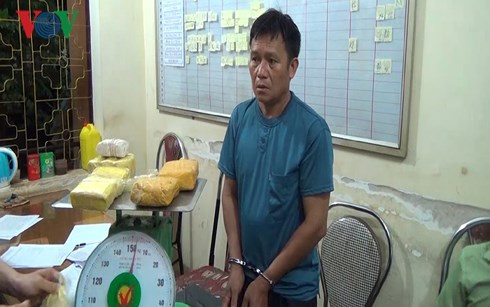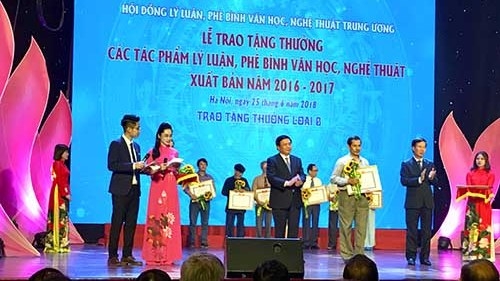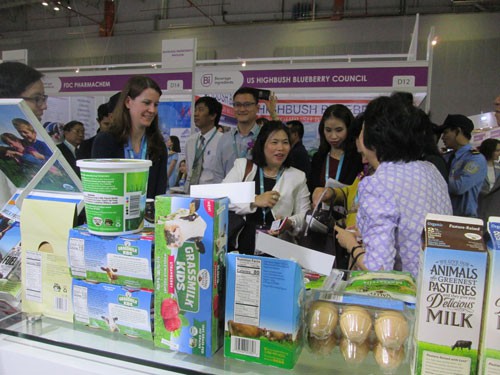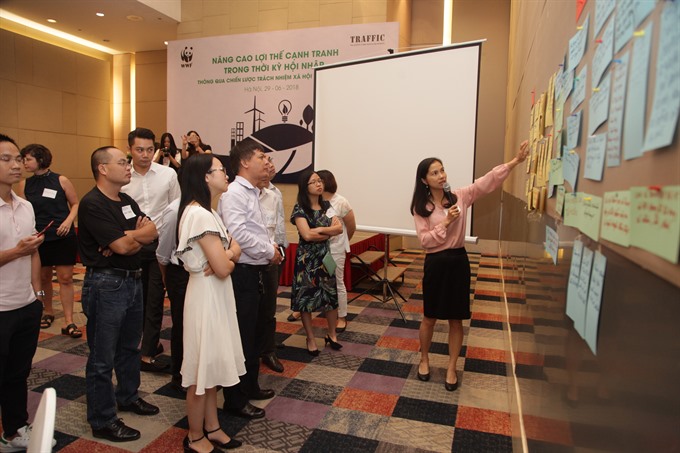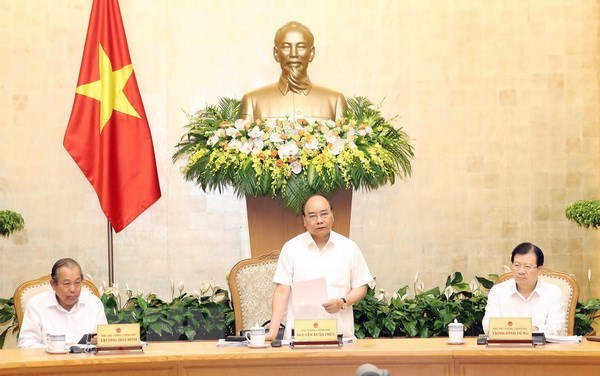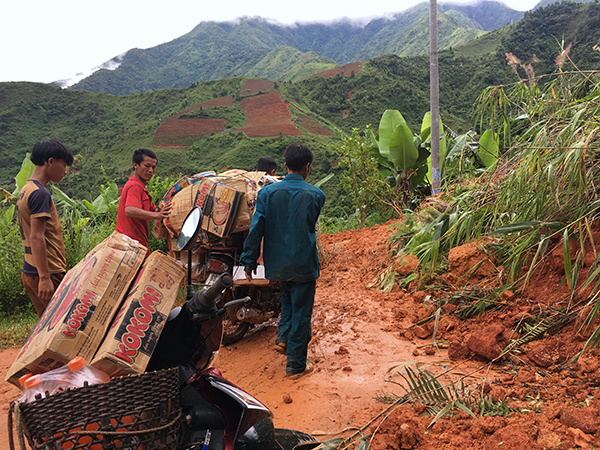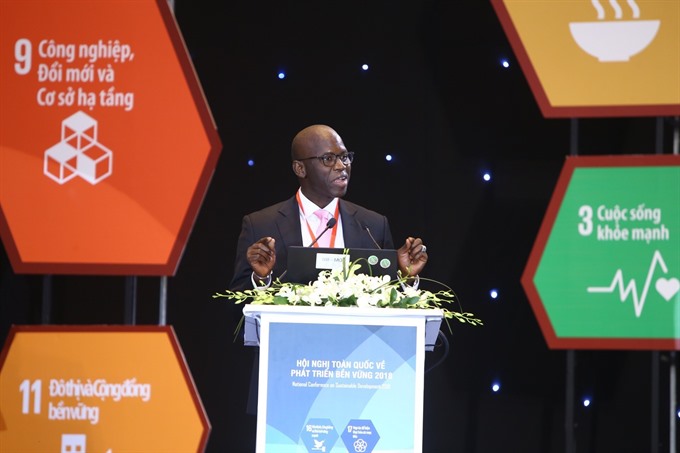Social News 29/6 Police officer refuses debt of hundreds of millions of VND On June 28, Dak Lak Police department informed that they had proposed the Ministry of Public Security to fire off police officer Le Duy Tan who works at the Traffic Police Department of Dak Lak province.
 Le Duy Tan's People's Police Certificate ID card Tan was discovered that he had leveraged his police ID card for hundreds of millions of VND. Earlier, Ngo Thi Ngoc, a resident of Ea Dang Town, Ea H'leo District, filed a lawsuit against Le Duy Tan over fraudulent misappropriation of property. Accordingly, on April 11, Tan borrowed Ms. Ngoc the amount of VND 330 million to pay the bank debt and mortgaged with the People's Police Certificate ID card No. 389-477. When borrowing money, Tan wrote a loan paper, promising that on April 30, 2018 he will return the money to Ms. Ngoc. On the date of the appointment, Ms. Ngoc has repeatedly reclaimed the money but this police officer gave many excuses and reasons, refused to reimburse. Therefore, Ms. Ngoc made a denunciation to the authorities to denounce the behavior of the police officer. According to the a high-ranking official of the police department of Dak Lak province, the department will strictly handle police or army officers and soldiers who are in the public security sector but lose police or military ID cards, or use those papers in any terms contrary to regulations. Even officers and soldiers who are out of the public security organs all are required to return their career cards or papers issued by the military or police authorities, he said. "The police have guided Ms. Ngoc to bring the case to court. If officer Tan escapes, Ms. Ngoc should send the petition to the provincial police to investigate the case of deceptive behavior and appropriation of property”, he added. Thanh Hoa: Flood-proof houses to be built for more than 780 poor families 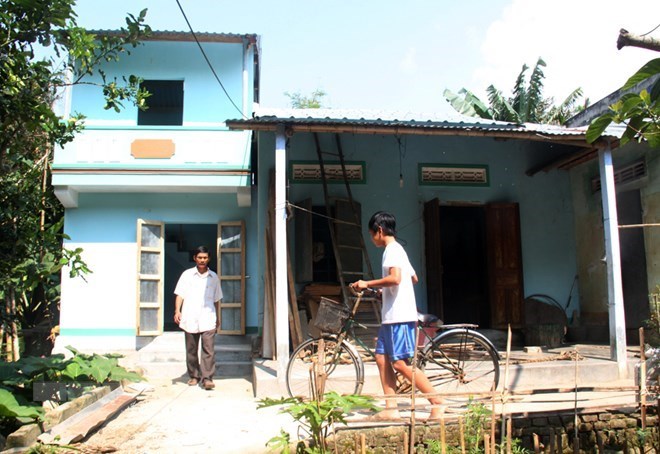 A project to build houses resilient to storms and floods for 782 poor households in coastal area of the north central province of Thanh Hoa will be carried out from 2018 to 2022 A project to build houses resilient to storms and floods for 782 poor households in coastal area of the north central province of Thanh Hoa will be carried out from 2018 to 2022. The houses will be built for disadvantaged families in the province’s four coastal districts of Nga Son, with 170 houses, Hau Loc (136), Hoang Hoa (210) and Tinh Gia (266), at a cost of more than 4 billion VND (about 174,800 USD). The province is among five coastal localities of Vietnam benefitting from the project funded by the Green Climate Fund (GCF) through the United Nations Development Programme. About 200-340 houses will be completed in the first part of the project in Thanh Hoa, as constructions of some houses began earlier in June. GCF Director in Thanh Hoa Le Cong Cuong said the organisation has worked with local authorities to provide safe and stable houses for disadvantaged households which are vulnerable to storms and floods, thus improving their lives and contributing to poverty reduction. The project will support the construction of 4,000 houses in Thanh Hoa, Quang Binh, Thua Thien-Hue, Quang Nam and Quang Ngai provinces. It will run until 2022 with non-refundable assistance totalling about 29.5 million USD. Major drug trafficking ring busted in Son La
Ly A Chong Police of Song Ma district in the northern province of Son La have cracked a major drug trafficking ring, seizing nearly 24,000 pills of synthetic drug and 7kg of opium latex. Ly A Chong, 54, residing in Song Ma district, Son La province, was apprehended at 4pm on June 27 while in the process of smuggling a large volume of synthetic drug and opium latex. Police also confiscated a motorbike, a mobile phone and other related evidence. The suspect confessed to having bought the drugs from an unknown man and that he intended to profit from the sale and distribution of the drugs. Further investigations are underway. Winners of theory and criticism of literature and arts awards honoured
At the awards presentation ceremony (Photo: hanoimoi.com.vn) A ceremony was held in Hanoi on June 25 by the Central Council for the Theory and Criticism of Literature and the Arts to honour the winners of the Literature and Arts Awards in 2016 and 2017. The ceremony was attended by Politburo member, Secretary of the Party Central Committee (PCC) and head of the PCC’s Communication and Education Commission, Vo Van Thuong; and Secretary of the PCC and Director of the Ho Chi Minh National Academy of Politics, Nguyen Xuan Thang. The winners include 28 of the most outstanding works as voted for by the Council. Ten B, 13 C and five consolation prizes were presented to artists from local literature and arts associations. The entries sent to this year’s awards received praise for being of higher quality than previous years. In addition, many works covered important issues facing the country. In addition, nine press agencies and publishing houses were also praised during the event for their contributionsto popularising works of literature and art. Drug users fret over expiry date of Suboxone pilot program 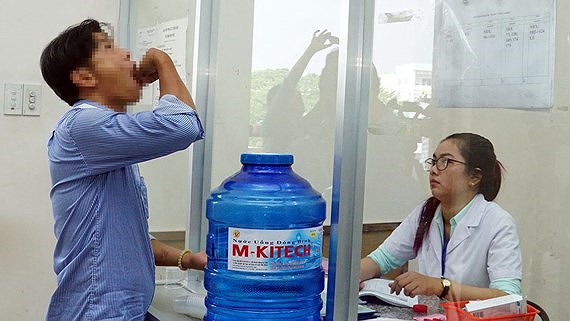 After two-year implementation project of Suboxone for injecting drug users in the Preventive Medicine center in Go Vap District in Ho CHi Minh City under the support of the French Governmental Agency ESTHER and the National Institute on Drug Abuse, many drug addicts succeeded in undergoing detoxification to start a new life; however, many of them fretted because of drug shortage and expiry date of the pilot program. The health sector has to find effective alternative medication when Suboxone in the pilot program runs out of. One of injection drug users successful in detoxificating is Th. in Hoc Mon District who have been addicted to drug for over 13 years. His family found out the information of the pilot program; subsequently, he was taken to the Preventive Medicine center in Go Vap District to take Suboxone as per the program. He said after one-week treatment with Suboxone, he was not addicted to the drug though he spent VND300,000 - 400,000 ($13 -$17.4) buying drug. He got healthier and gained weight. "I start to help my family's business; hence, I feel happier", said Th. Director of the center in Go Vap District Dr. Nguyen Trung Hoa said that 22 drug addicts are treated with Suboxone in the center and 80 percent of them get success. In comparison of buprenorphine and methadone, Suboxone has more advantages. Drug users must take Methadone daily because it has 24-36 hour half life while Suboxone has 48-72 hoour haf life so patients can take daily or alternate day in a week. On the other side, Suboxone has no interaction with Antiretrovirals (ARV) and tuberculosis medication.Accordingly, Suboxone is used to treat drug addiction in many nations in ten past years, said Dr. Nguyen Trung Hoa. The Suboxone -treated pilot program implemented from May, 2015 with 252 patients but 22 of them are being treated this time. Sadly, the pilot program ended in August, 2017 and nearly one year, 22 drug users receive the remaining drug in stock. Scientific journals in international conferences highly spoke of the effectiveness of Suboxone in the Preventive Medicine center in Go Vap District with the aim to propose Vietnamese Ministry of Health buying the drug to treat patients, Dr. Hoa said. People's Committee in Ho Chi Minh City has implemented "The action month against drug", “World Drug Prevention”. This year, a month-long program themed " To protect young generation against drug danger" aimed to increasing information of prevention task and bad effects of drug on young people as well as encourage people to participate in keeping security order in residential quarters. Campaign on greening vocational education launched in TVET institutes 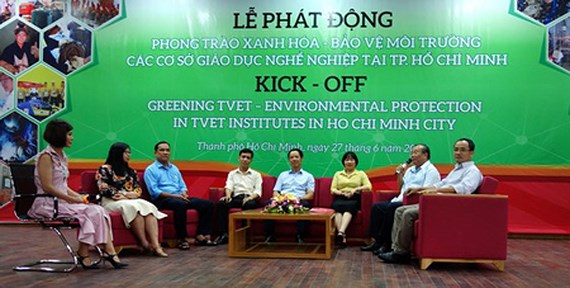 The campaign “Greening TVET – Environmental Protection in TVET Institutes” which develops skills and provides knowledge to ease transitions to green economies and societies was kicked off yesterday among technical and vocational education and training institutes in Ho Chi Minh City. The campaign was launched by the Directorate of Vocational Educationand Training, the Ho Chi Minh City Department of Labor – Invalids and Social Affairs, the College of Technology II and the German agency of international development cooperation Deutsche Gesellschaft für Internationale Zusammenarbeit (GIZ), According to Doctor Truong Anh Dung, Deputy Director of the Directorate of Vocational Education and Training, the concept of greening TVET is quite new in Vietnam, which is aiming at strategies and policies for the sustainable development in relation with comprehensive greening. To achieve this goal, the role of education is critical, especially in training human resources that are able to meet requirements of greening the economy by effectively using energy and resources at their workplace, correctly applying environmentally friendly technologies while preventing potential environmental damages. Head of the college Ms. Nguyen Thi Hang said that the green factor is embedded into the curriculum, especially in the major of ‘Technology in draining and sewage treatment’ – a cooperative program between the college and six businesses of the field. The college campus is undergone the greening process as well. Deputy Director of the Ho Chi Minh City (HCMC) Department of Labor – Invalids and Social Affairs Nguyen Van Lam suggested that these institutes prepare a detailed plan to gradually introduce the concept of greening to the staff as well as students. In July 2018, the department is going to organize a training workshop for leaders of colleges and vocational schools in the city about the greening of TVET. There were more than 50 vocational schools, colleges and representatives of businesses took part in the event. Vietnamese artists participate in cultural art exchange in Norway
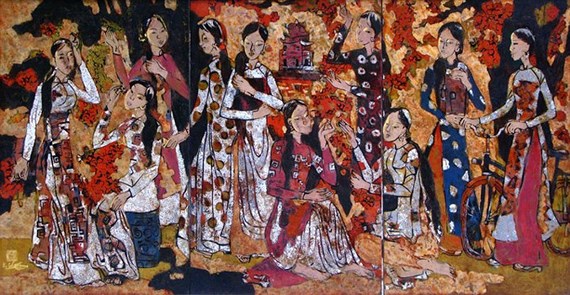 A painting by artist Le Xuan Chieu A group of 8 painters of the Ho Chi Minh city Association of Fine Arts took part in an exhibition in the Kingdom of Norway. Artists including Le Xuan Chieu, Dang Thi Duong, Ly Khac Nhu, Hua Thanh Binh, Bui Tien Tuan, Viet Thi Kim Quyen, Nguyen Phan Nam An and Nguyen Tri Minh Tuyet brought 45 artworks in various materials, such as lacquer, oil, silk and ceramic to the “Saigon art exhibition” held in Hedmark county in Eastern Norway. At an exchange between the two sides, Norwegian artists are interested in Vietnamese artists’ activities, their trend, role and position in the modern society as well as materials used for fabric and lacquer paintings. The delegation of Vietnamese painters also visited art museums, landscapes and met Norwegian Vietnamese artist Duc Thanh Hong who is specialized in painting on ceamic in Norway. The “Saigon art exhibition” runs until August 25. Exhibition on trade union activities held in HCMC An exhibition titled “Proud to be a worker of heroic city” opened at the Ho Chi Minh City Labor Culture Palace on June 26. The event introduces to viewers workers’ achievements in working and production in Ho Chi Minh City and Ton Duc Thang award-winning products of key industries, including new technological model, high-tech products, high-tech agricultural products, health and the reform of administrative procedures. The exhibition is also to honor the results and outstanding activities of workers and trade union organizations in the city in the 2013-2018 period and to mark the 11th Trade Union Congress of the 2018 - 2023 period. Deputy chairman of the Ho Chi Minh City Labor Confederation, Tran Doan Trung said that the last term saw significant achievements in various fields. Workers, civil servants and employees made initiatives in improving the operation of devices and machines to better working condition, save production costs, increasing working productivity and product quality. My Thuan 2 Bridge needs VND5.2 trillion
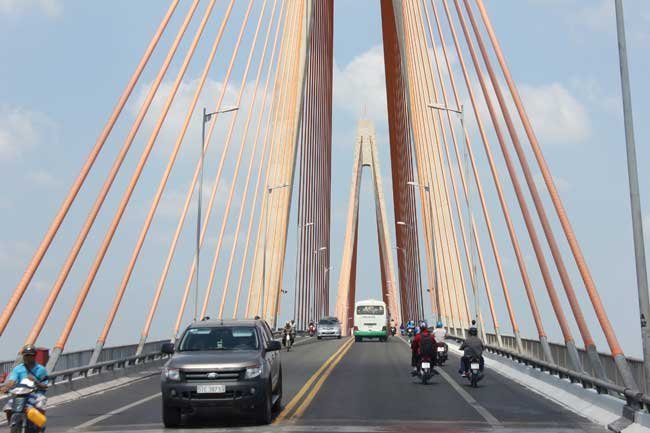 A view of the current My Thuan Bridge. When in place, My Thuan 2 Bridge will ease traffic on the My Thuan Bridge An estimated VND5.2 trillion, or US$227 million, will be required to build My Thuan 2 Bridge connecting Tien Giang and Vinh Long provinces. Project Management Unit 7 (PMU7) under the Ministry of Transport has completed the feasibility study for the project. The bridge and approach roads will have a total length of 6.6 kilometers. Located 350 meters upstream of the existing My Thuan Bridge, My Thuan 2 will start from an intersection with Trung Luong-My Thuan Expressway and end at an intersection with National Highway 80, the starting point of My Thuan-Can Tho Expressway. Besides My Thuan 2, the project will include constructing An Huu, Rach Son, Rach Gong and My Hung 2 bridges. According to the feasibility study, the technical design for the project will be made ready in the second half of the year. The project will get off the ground in the third quarter of next year and construction work is expected to take three years. According to PMU7, as Cao Lanh Bridge was opened to traffic last month and Vam Cong Bridge will be finished soon, vehicle traffic on the operational My Thuan Bridge will surge. Therefore, My Thuan 2 will play a pivotal role in easing the burden of My Thuan when large bridges in the Mekong Delta and Trung Luong-Can Tho expressway are put into use. Conference seeks NGOs’ financial assistance for Thanh Hoa  A conference to call for foreign non-governmental organisations (NGOs)’ financial assistance in poor areas in the central province of Thanh Hoa took place in Hanoi on June 27. Speaking at the event, Vice Chairwoman of the provincial People’s Committee Le Thi Thin said Thanh Hoa lies in a gateway between the north and central of Vietnam with railway, road, waterway and aviation infrastructure. As a poor province with limited internal resources, Thanh Hoa always heeds external economic activities to attract foreign resources, focusing on calling for official development assistance and foreign NGOs’ aid, she said, adding that the province now records 84 valid foreign-invested projects with a total investment of over 13.98 million USD. The Vietnam Union of Friendship Organisations has also listed Thanh Hoa among the top localities nationwide that has effectively used foreign NGOs’ aid. Over the past decade, the total financial assistance provided by foreign NGOs has hit 78.96 million USD via more than 300 projects. Up to 7.9 million USD on average was disbursed each year. In the first half of this year, 3.5 million USD has been disbursed. The projects are mostly in agriculture, rural development, poverty reduction, capacity improvement, health care, education, environment protection, natural disaster mitigation and climate change response. Many projects funded by NGOs have been productive and spread to many localities such as a children-oriented education model by the World Vision in seven mountainous and disadvantaged districts, the trans-generation mutual support club by Help Age. Thinh urged foreign NGOs in Vietnam to assist Thanh Hoa’s sustainable socio-economic development and pledged all possible support to their projects. Phan Anh Son, head of the VUFO’s People’s Aid Coordinating Committee said in the past five years, VUFO together with ministries, agencies, localities and partners effectively carried out the national programme on foreign aid mobilisation for the 2013-2017 period. The framework programme for 2017-2022 have been devised. Participants at the event discussed potentials and strengths of Thanh Hoa, local demand for foreign capital and aid. On the occasion, the provincial authorities signed memoranda of understanding with foreign partners and presented decisions approving projects using NGOs’ aid. Quang Nam works to alleviate poverty rate among ethnic minorities
A festival of the Co Tu ethnic minority in Quang Nam province The central province of Quang Nam’s efforts to reduce poverty rate among ethnic minority groups have given a new look to the rural mountainous areas as local livelihoods have been improved significantly. Guided by the Prime Minister’s Decision No.1557/QD-TTg dated September 10, 2015 approving a number of targets in realising Millennium Development Goals for ethnic minorities associate with the Sustainable Development Goal after 2015, the province has paid due attention to planning works and building residential areas for residents in mountainous areas to ensure that they have stable accommodation and land for production. Last year, nearly 106 billion VND (4.56 million USD) was arranged to help nearly 1,500 households settle down and branch out production. The mountainous districts have combined forestry development with poverty reduction programmes while encouraging the cultivation of medicinal herbs in line with local policies. During 2016-2017, the National Target Programme for Sustainable Poverty Reduction allocated over 165 billion VND (7.09 million USD) to Quang Nam to support infrastructure and production model development for six poor districts and 19 special difficult communes in coastal and island areas. Particularly, after one year implementing the provincial policy on encouraging districts and communes to try and escape poverty, nearly 4,000 households, including 2,700 families in the mountainous areas, have registered to get out deprived situation sustainably. Last year, average economic growth in the ethnic minority area reached 7.1 percent much higher than the province’s average level of 5.55 percent. Poverty rate in the nine mountainous districts tapers off 5 percent per year. Nearly 92 percent of the ethnic population have been connected to the national electricity grid while the rate of households using hygienic water is over 81 percent. The literacy rate reached nearly 98 percent among ethnic population from 15 years old. In a bid to realise the sustainable poverty reduction goal for ethnic minorities, Quang Nam province plans to prioritise more resources and carry out a set of comprehensive measures like infrastructure development, socio-economic development programme and preferential loans. Quang Nam province is currently home to 32,000 ethnic minority households with nearly 150,000 people, accounting for 10 percent of the province’s population. They reside mostly in six mountainous districts of Nam Tra My, Bac Tra My, Tay Giang, Nam Giang, Dong Giang and Phuoc Son. Flood victims to receive aids 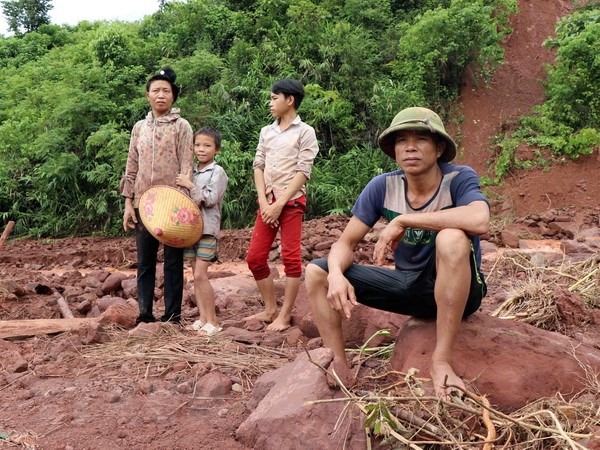 Quàng Văn Ố, a resident of Sìn Hồ district’s Noong Hẻo commune, has lost his crops and fish ponds to flash floods. Government agencies and donors have joined hands to provide urgent assistance to people who have been affected by floods in the past several days. The Việt Nam Fatherland Front Central Committee (VFFCC) had an urgent meeting on Wednesday to discuss measures to help the flood-affected people. At the meeting, VFFCC president Trần Thanh Mẫn assigned Hầu A. Lềnh, VFFCC vice president and head of the Centre Rescue Committee, to directly inspect the flood-relief work. The VFFCC is leading the way to deliver aid worth VNĐ1 billion (US$43,000) to the two hard-hit provinces of Lai Châu and Hà Giang. So far, the VFFCC has sent aid worth VNĐ5 million ($215) to each family whose member is either dead or missing in the floods and VNĐ3 million ($129) to each family with an injured member. It has also contributed VNĐ50 million ($2,150) to build new houses for those whose homes have been swept away in the floods. With an aid movement underway across Việt Nam, Mẫn has asked the VFF in the northern mountainous provinces to provide frequent updates about the flood situation so that the Central Rescue Committee can offer proper and timely support to the needy. He said flood-hit localities should report about donations and aids from organisations and individuals to the VFF as this would help minimise the overlapping of aid in the same area and prevent shortage of aid in other areas leading to insecurity and disunity in the community. Mẫn also asked VFF in localities to re-examine the total aid under their management and report to VFFCC. Based on this, VFFCC will re-arrange and allocate aid to localities in need. The Ministry of Agriculture and Rural Development on Thursday provided aid to flood-affected people in northern Lai Châu Province. Each family of a flood victim will receive VNĐ3-5 million ($129-215). Minister of Agriculture and Rural Development Nguyễn Xuân Cường has called on cadres and staff to contribute at least one day’s salary to help flood victims. The aid will be immediately transferred to people in the affected areas. Meanwhile, the Governor of State Bank of Việt Nam (SBV), Lê Minh Hưng, on Wednesday requested SBV branches in Hà Giang, Lai Châu, Thái Nguyên, Điện Biên, Tuyên Quang, Lào Cai and Cao Bằng provinces to support the flood-affected people. The SBV branches have also been asked to apply supportive measures, such as extending repayment deadlines and interest rate exemption and reduction for flood-affected customers. The SBV has so far raised VNĐ2.3 billion ($98,900) for flood victims. Nguyễn Khắc Chử, secretary of the Provincial Party Committee in Lai Châu, on Thursday, donated VNĐ30 million ($1,290) and daily necessities to 28 families whose houses and properties were buried due to erosion in Tả Ngảo commune on Wednesday. Traffic is still blocked in the commune. In northern Điện Biên Province’s Mường Nhé District, rescue teams have managed to supply food, clothes and provide shelter to affected people. According to the latest report of the Central Steering Committee on Natural Disaster Prevention and Control, flash floods have killed 23 people and left 11 missing in northern mountainous provinces, mostly in Hà Giang, Lai Châu, Lào Cai and Điện Biên. Torrential rains and floods have also swept away 161 houses, damaged 958 houses and submerged thousands of hectares of crops. Roads and irrigation works too have been damaged, causing losses of VNĐ487 billion ($20.9 million). PVF start strong at national U17 champs
 Defending champions PVF took on Bình Dương at the National U17 Football Championship’s final round on on June 27. — Photo thethaovietnam.vn Defending champions PVF had a good start in the final round of the National U17 Football Championship with a 3-0 win over Bình Dương. The game, which was held on Wednesday at the Promotion Fund for Vietnamese Football Talent Centre (PVF) in the northern province of Hưng Yên, was PVF’s first match in Group A. PVF banked on home support to control the game from the opening minute, with Nguyên Hoàng scoring two goals in the first half. After the break, Bình Dương tried to fight back but failed to score any goals. Hoàng completed a hattrick for the hosts in extra time. The tournament features eight teams which qualified for the final round from the initial 24 teams. They will play in a round-robin format in the group stage, and the four best teams will advance to the semi-finals. The two winners of the semi-final games will play in the final to determine who wins the championship. The two teams that lose in the semi-finals will be awarded joint third prize. VNN |
Article 1
↧
↧
Article 0
Foreign organic products find it difficult to enter Vietnam The Vietnamese organic product market, which includes both food and non-food, has been taking shape in the last few years, but there are still few importers of organic products.
There are still few importers of organic products Most of the products are carried to Vietnam across border gates. Customers have to buy products at high prices, and cannot enjoy post-sale services. Organic communities like ‘tieu dung huu co’ (organic consumption’ and ‘song huu co’ (organic life) on the internet and Facebook share knowledge about organic agriculture and also sell organic products. However, the bills issued by shops overseas are the only evidence that prove the ‘organic’ characteristic of products in some cascades.
Sometimes, when supermarkets overseas run sale promotion programs, the members of the communities order in groups to share shipping fees. At a high-end food shop on Nguyen Thi Minh Khai street in district 1, HCM City, next to shelves displaying products imported through official channel which have sub-labels in Vietnamese with sufficient information, there is a shelf for organic products imported through unofficial channels. Reporters noted that most of the products are organic spices with little information about names and selling prices. Detailed information is written in Japanese. Buyers have to rely on information provided by sellers or have to search for information on the internet. The representative of Thien An Le Trade & Service Company in HCMC, which specializes in ‘non-chemical products’, said the company is one of a few retailers which sell officially imported products. There are only a few importers which import these products. These include NTP, which specializes in importing dairy products, grains and cooking oil. Solomon specializes in organic dairy products and Fire Phoenix in cosmetics. Meanwhile, most imports don’t have documents to show their origin. According to Pham Phuong Thao, managing director of Organica which owns Organica shops, the Vietnamese organic food market is still small. Some companies only import products in small quantities. Phan Thi Hong Quyen, co-founder of Solomon International, the exclusive distributor of Organic Valley, said it took two years to negotiate with Organic Valley to obtain the right to distribute its products. However, Quyen complained that the import procedures are complicated and the import tariff on dairy products from the US is high (30 percent import tariff and 10 percent VAT). Vu Kim Hanh, chair of High Quality Vietnamese Product Business Association, said organic foods have become very popular in Vietnam. The market is worth VND3.5 trillion a year. VNN |
↧
Article 3
Gov’t urges speedy approval of new plan for Phan Thiet airportBinh Thuan - The government has urged the Ministry of National Defence and other agencies to approve the adjustment plan for the combined civilian and military Phan Thiet Airport in Binh Thuan province.  The Phan Thiet Airport is expected to open by 2020 (Photo: baogiaothong.vn) The airport will be upgraded from 4C to 4E standard of the International Civil Aviation Organisation as part of the country’s airport planning, according to the Civil Aviation Authority of Vietnam (CAAV). The upgrade will make the airport meet the requirements of flights using code E aircraft between Phan Thiet and Noi Bai in Hanoi, Van Don in Quang Ninh province and Cat Bi in Hai Phong city. The airport upgrade will allow flights of high-end military aircraft. The airport’s runway will be lengthened from 2,400 metres to 3,050 metres, and airplane parking lots will be expanded to contain two code E and four code C aircraft. The size of the terminal will increase from 5,000 square metres to 19,200 square metres, serving 2 million passengers a year instead of 500,000 as previously planned. The investment capital for the project will total 10.2 trillion VND (456 million USD) from now to 2020, and 332 billion VND (14.75 million USD) from 2020 to 2030. Rang Dong JSC is the contractor for the civilian component of the plan, which is under the BOT (build-operate-transfer) form, according to CAAV. The military component will be built under the BT (build-transfer) form by the Ministry of National Defence. Construction on Phan Thiet airport began in 2015. It is expected to open by 2020. VNS/VNA |
↧
Article 2
Nine localities record over 10 per cent GRDP growth in six months HÀ NỘI — Nine localities recorded over 10 per cent growth in gross regional domestic product (GRDP) in the first sixth months of this year, reported the General Statistics Office (GSO). 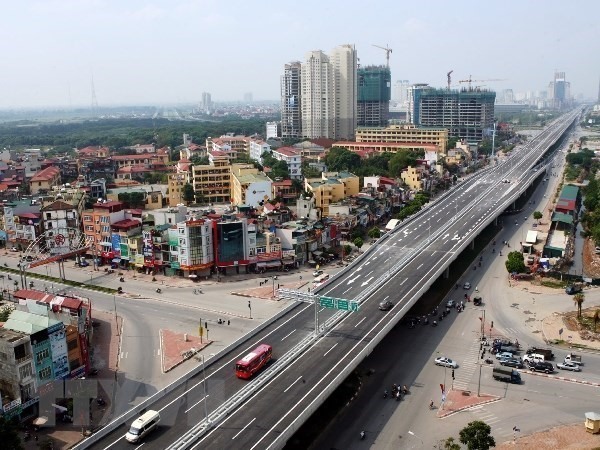 The central province of Hà Tĩnh topped the list of growth in gross regional domestic product (GRDP) in the first sixth months of this year. — Photo hatinh.gov.vn The central province of Hà Tĩnh topped the list. It was followed by the northern provinces of Bắc Ninh, Hải Phòng, Thái Bình, Bắc Giang, Quảng Ninh and Lào Cai, and southern provinces of Ninh Thuận and Long An. According to the GSO, many other localities achieved high GRDP growth of between 8-10 per cent, including Thái Nguyên, Hà Nam, Ninh Bình, Đắk Nông, Quảng Ngãi, Kiên Giang, Hải Dương, Lâm Đồng, Bình Thuận, Đồng Tháp and Hậu Giang. However, Bà Rịa-Vũng Tàu, Hòa Bình, Lai Châu and Cao Bằng were among localities with low growth in the reviewed period. Although in the leading group, Hà Nội and HCM City saw a GRDP expansion of more than 7 per cent. In terms of economic regions, the Red River Delta Region took top position with 12.02 per cent, followed by the Northern Central and Central Coastal Region with 8.61 per cent. Major reasons behind the large gap in GRDP growth between the two regions were the stronger development of industry and construction in some northern and central localities such as Vĩnh Phúc, Bắc Ninh, Hải Phòng, Quảng Ninh, Thái Bình, Hà Tĩnh and Quảng Ngãi. Lowest growth was recorded in the southeast region at only 4.17 per cent. The northern midland and mountainous region recorded growth of 8.43 per cent, followed by the Mekong Delta region (7.61 per cent) and the Central Highlands region (7.28 per cent). VNS |
↧
Article 1
Social News 1/7 Drilling of second tunnel for HCM City metro completed  The drilling of a second tunnel at Ba Son Station on Metro Line No 1 in HCM City has been completed. Tunnel-boring machines yesterday completed the drilling of the second tunnel of the Metro Line No.1 connecting HCM City’s Bến Thành Terminal in District 1 with Suối Tiên Terminal in District 9 after more than five months of implementation, according to the HCM City Management Authority for Urban Railways. The tunnel, with total length of 781 metres, width of 6.79 metres and depth of more than 12 metres, runs from Ba Son Station on District 1’s Tôn Đức Thắng Street to the Municipal Theatre on Đồng Khởi Street in District 1. According to the HCM City Management Authority for Urban Railways, because the tunnel’s depth is lower than the first one, more careful drilling was required. Strict monitoring to adjust the machine’s operation parameters during the drilling process were necessary, the authority said. After drilling the two tunnels, the main builder of the tunnel project, Japan’s Shimizu-Meada Joint Operation, will continue construction on the western tunnel, and also install rails, signal systems and drainage for both tunnels. Construction on Metro Line No 1 began in August 2014. It is expected to open by 2020. The line, which has a total length of 19.7 kilometres, has 2.6 kilometres of underground passage. Around 54 per cent of construction on Metro Line No 1 has been completed. Total capital after adjustment for the project has reached US$2.49 billion. Court delays trial in deforestation case  A large tree is chopped by loggers in central Bình Định Province. The People’s Court of central Bình Định Province on Thursday delayed the first-instance trial in a large-scale deforestation case in An Lão District last year. More than 64ha of forest were chopped down. Nine defendants were required to be present at the court for hearing, but most of them did not turn up. After considering the opinion of the People’s Procuracy, participating lawyers and defendants, the judging council decided to delay the trial. According to the indictment of the provincial People’s Procuracy, in July 2017, Lê Văn Thiệt, general director of Thương Thảo Trading and Investment Joint Stock Company, directed Nguyễn Văn Ri, a company official, to cut down trees in zone 1 of An Hưng Commune for planting acacia trees. Ri hired workers to get the work done, destroying 37.5ha of two forest areas. Thiệt widened the roads and set up camps to make it easier for the workers and to transport timber to the company. Seven other defendants, who lived in Hoài Nhơn District’s Hoài Sơn Commune, hired workers and cut down trees in 27ha of forests in An Hưng District. Damages are estimated at VNĐ4.79 billion (over US$2 million). Deputy Prime Minister Trương Hòa Bình asked the Bình Định People’s Committee to investigate the case after the incident was reported by the Việt Nam News Agency in September 2017. Flashfloods leave one missing in Dien Bien 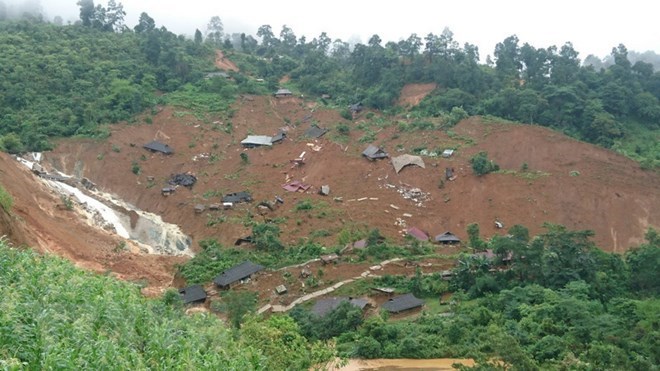 Flashfloods swept away a local on June 27 in Muong Nhe commune, Muong Nhe district of the northern province of Dien Bien, while destroying many houses and massive areas of crop. According to the Steering Committee for Natural Disaster Prevention, Search and Rescue of Dien Bien, torrential rains from June 23-27 caused floods in the locality, damaging 25 houses and 10 hectares of crop. About 500 square metres of aquatic farm was swept away, while more than 60 heads of livestock were drowned. All equipment of the kindergarten of Nam Vi commune in Muong Nhe district was swept away. Floods also destroyed a primary school in Sen Thuong commune of Muong Nhe district. Many suspension bridges, irrigation dams and canals in the district were seriously damaged, while travel in Muong Nhe and Tua Chua districts has been difficult due ot the damage to roads. Meanwhile, floods ruined 11 middle-voltage power poles and 38 low-voltage poles, causing power loss in a massive area spanning Muong Nhe, Dien Bien Dong and Tuan Giao districts. On June 25, 11 transformer stations were damaged, along with a 35kV transmission line, leading to power disruption of more than 900 households. Power supply is expected to resume on July 4. On June 28, National Assembly Vic Chairman Phung Quoc Hien led a working team to the neighbouring province of Lai Chau to direct the settlement of flood consequences and visit victims’ families. Lai Chau has been seriously hit by flood and landslides, with heavy losses in both human life and property. By 7:00 on June 28, the province reported 16 deaths and nine people missing.- Fourth International Day of Yoga comes to Gia Lai 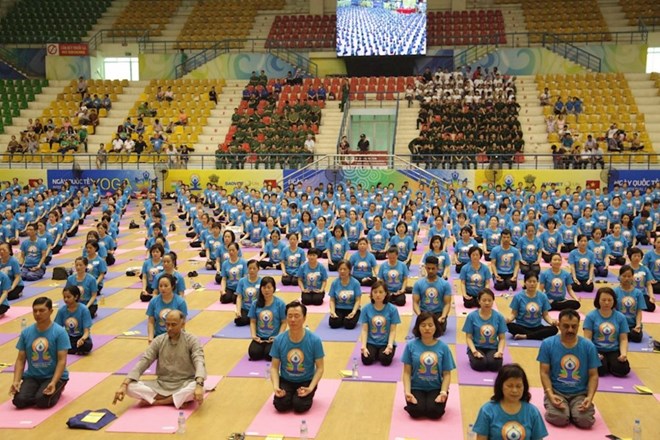 The 4th International Day of Yoga (IDY) took place in Plaiku city, the Central Highlands province of Kon Tum on June 28, with the participation of nearly 200 people. The event was jointly organised by the provincial Department of Culture, Sports and Tourism and the Indian Consulate General in Ho Chi Minh City. The event of this kind was held in succession from June 16 - July 15, 2018 in 11 provinces and cities of Vietnam, including HCM City, Hanoi, Da Nang, Nha Trang, Dong Nai, Can Tho, Dak Lak, Tien Giang, Vinh Phuc, Kien Giang and Gia Lai. The IDY is to honour the 5,000-year-old physical, mental and spiritual practice originating in India, which aims to transform both body and mind. It helps those who practice yoga improve their health and life quality. Project helps ensure traffic safety at schools in Gia Lai 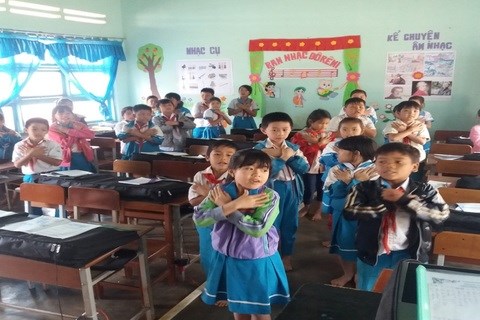 The Fondation Botnar and the Global Road Safety Partnership (GRSP) have jointly launched a project on traffic safety in two elementary schools in the Central Highlands province of Gia Lai. The targeted schools are Phan Dang Luu Elementary School in Bien Ho commune and Nguyen Luong Bang Elementary School in Thang Loi Ward, Pleiku city. A conference on the implementation of the project was held by Gia Lai province’s Traffic Safety Board and the Asia Injury Prevention Foundation (AIPF) on June 28. The project aims to ensure traffic safety around schools in Pleiku city by upgrading traffic infrastructure and improving public awareness of this issue. Pleiku has 31 elementary schools with nearly 24,000 pupils, who are dropped off and picked up by their parents. Traffic jams often occur at school gates as the schools are located on main streets. According to Vietnam’s National Traffic Safety Committee, traffic accidents kill about 1.3 million people and injure 50 million others each year, causing losses worth 500 billion USD. The Vietnam-Germany Transport Research Centre reported that the number of child fatalities in accidents in Vietnam was 20 per 100,000, nearly three times higher than other countries in the Association of Southeast Asian Nations (ASEAN) and more than four times higher than developed countries. Against the back drop, the committee has selected the theme of “Traffic safety for children” for the 2018 Traffic Safety Year. Northern mountainous provinces seek to improve PCI 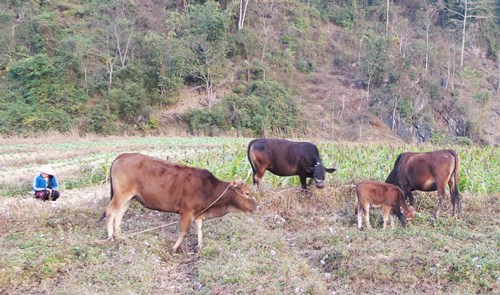 President of the Vietnam Chamber of Commerce and Industry (VCCI) Vu Tien Loc has urged northern mountainous provinces to review their economic management, with priorities given to businesses in socio-economic development. Speaking at a workshop in Cao Bang province on June 28, which saw the participation of representatives from 14 northern mountainous provinces, the official pointed out the fact that these localities have been left behind in socio-economic development and investment environment quality. Of note, the five provinces with the lowest provincial competitiveness index (PCI) belong to the region, Loc said. Given this, he asked the provinces to improve their competitiveness, build department and district competitiveness index, and pay more attention to the quality of investment promotion. In this regard, Dau Anh Tuan, head of the VCCI’s Legal Department, said the provinces should push forward the reform of enterprise establishment procedures as well as administrative reform, especially land-related procedures, and pay more heed to micro-and small-sized enterprises. Other delegates at the workshop suggested implementing open dialogues to remove difficulties facing enterprises, and boosting regional connectivity in business environment development. Vietnam, RoK intensify IT cooperation  The Vietnam Internet Association has signed a cooperation agreement with the Korea Federation of ICT Organisations, aiming to develop bilateral relations and create a forum for businesses of Vietnam and the Republic of Korea (RoK) to transfer technologies, services and industries relating to ICT. Accordingly, the two sides will exchange market information, support Vietnamese and RoK companies to participate in trade fairs, and organise workshops and training courses on ICT. The RoK is pursuing the I-Korea 4.0 policy, which, the Presidential Committee on the Fourth Industrial Revolution said, will secure a new growth engine for the country by expanding industries' productiveness and competitiveness under the idea of "intelligence, innovation, inclusiveness, and interaction," according to the Yonhap News Agency. Vietnam is the RoK’s third largest trade partner. Of note, the bilateral cooperation in the IT sector is thriving. Vietnam has more than 58 million internet users out of its 90 million people and over 125 million mobile subscribers. Vietnam promotes ITC technologies at CommunicAsia 2018 The Vietnamese space at the CommunicAsia 2018  Vietnam ran a national space spanning 100sq.m at Asia’s largest telecommunications exhibition CommunicAsia 2018, which took place in Singapore between June 26 and 28. Themed “Connect the Future”, the exhibition attracted the participation of about 2,000 businesses from 50 countries and territories. The Vietnamese space, organised by the Ministry of Information and Communications, gathered representatives from the Vietnam Association for Information Processing, Vietnam Post and Telecommunication (VNPT), MobiFone, and MQ ICT Solutions. It displayed the latest information and communications technology developed by Vietnamese engineers. The VNPT introduced a series of Internet of Thing (IoT) solutions for the management of smart city, smart tourism, and smart agriculture, among others, based on the IoT Connected Platform. The platform was developed by the VNPT Technology and helped its developer won a Gold Stevie Award in 2018. MobiFone, meanwhile , showcased its four IT solutions, including the journey tracker mTracker and distribution channel management mSale. CommunicAsia, together with BroadcastAsia, and the new NXTAsia, form ConnecTechAsia – the region’s answer to the converging worlds of Telecommunications, Broadcasting and Emerging Technologies. The organiser said the event drew more than 30,000 visitors during its 3-day course. Vietnamese students graduate from agricultural programme in Israel 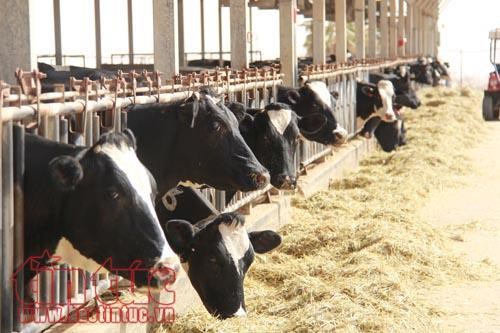 A cow breeding farm in Israel More than 130 students, including 50 Vietnamese nationals, on June 28 graduated from an international agricultural programme at the Sedot Negev Agriculture Centre in the south of Israel. At the graduation ceremony, Shlomo Nezer, manager of the centre’s training programme, noted that the course, the fourth of its kind, was designed for students from Asia and Africa. Due to the excellent performance of Vietnamese students, the centre decided to increase the number of Vietnamese attending the following course to 65, he said. Meanwhile, Khuat Van Quyen, First Secretary of the Vietnamese Embassy in Israel, affirmed that the 11-month training course gave the students an insight into the modern agriculture of Israel. He expressed his hope that the Vietnamese graduates, will use their knowledge acquired in Israel con contribute to agriculture development in their homeland. Professor Yiftach, director of the Katif Research Centre under the Sedot Negev Agriculture Centre, told Vietnam News Agency that many Israeli farm owners want to recruit Vietnamese students due to their industriousness and creativeness. During their stay in Israel, the students also have opportunities to practice English, and receive a minimum stipend of 1,000 USD per month excluding tax and accommodation fees. Currently, there are four Israeli centres offering training for Vietnamese students, including AICAT Arava, Ramat Negev, Sdot Negev and Agrostudies. Photo contest on sea and islands launched A photo contest themed ‘Homeland’s sea and islands’ was launched on June 28, aiming to introduce and promote the role, potentiality, and beauty of the seas and islands of Vietnam to domestic and international art lovers. The event was co-organised by the Central Committee's Propaganda and Training Department, the Ministry of Culture, Sports and Tourism and the Vietnam Association of Photographic Artists. The competition is open to Vietnamese people and foreigners working and living in Vietnam from all ages. Participants are encouraged to submit photos under specific topics, including the beauty of nature, people in the sea, islands of Vietnam; life moments, daily activities, customs, the habits and cultures of coastal people in Vietnam; photos of visitor’s experiences with local people on sea and islands; protecting the security, order, safety and sovereignty of the sea and islands of the Vietnamese armed forces; praising outstanding individuals; economic activities and images showing the friendship cooperation of Vietnam and other countries in the East Sea; cultural works, artforms, festivals in the sea and islands of Vietnam. Contestants can submit their images through the website: www.anhnghethuatbiendao2018.com. The deadline for applications is midnight on August 31, 2018. There is one first prize worth VND15 million, one second prize worth VND10 million, one third prize worth VND7 million, and ten consolation prizes. International eye hospital resort opens in Bắc Giang 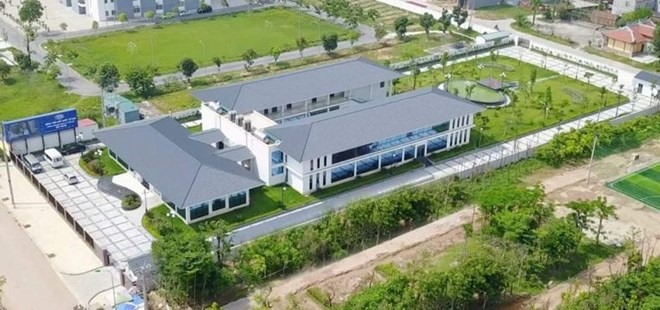 The view of the hospital. — Photo Vietnamplus An international eye hospital was put into operation in northern Bắc Giang Province on Thursday. The DND hospital covers an area of some 10,000sq.m in Dĩnh Kế Ward, Bắc Giang City. Combining the high-end resort model with hospital, DND is the first international standard hospital in the province. Along with its high-tech equipment and qualified staff, DND provides a variety of choices for high-quality medical service to the locals. The elements of a resort would also be included such as biological gardens, lakes, and a Japanese style architecture, ready to serve thousands of patients every year. Lương Ngọc Khuê, head of the ministry’s Medical Examination and Treatment Department, said the hospital with its equipment and staff was expected to satisfy the increasing demand of the people for health examination and treatment. Raising the quality of medical services is also the goal of the ministry to better serve patients, according to Khuê. On the occasion of the opening ceremony, the hospital plans to provide free cataract surgeries for 150 poor and disadvantaged patients from Bắc Giang, Bắc Ninh and Lạng Sơn provinces. Trà Vinh farmers grow mangrove forests to breed shrimp, other species 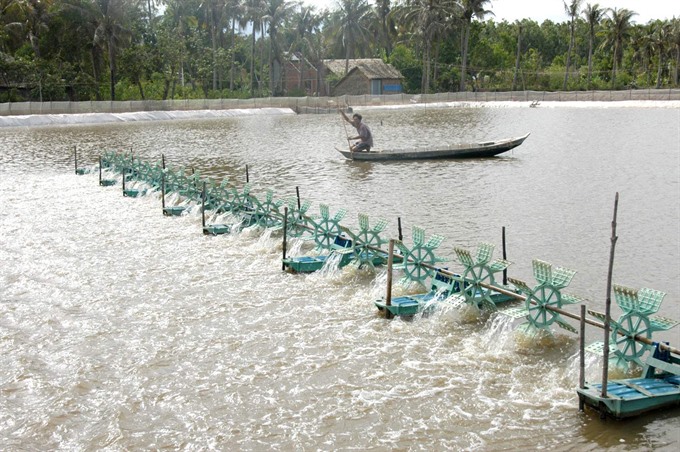 A shrimp pond belonging to a local resident in the southern province of Trà Vinh. Farmers in coastal Trà Vinh have planted more than 4,000ha of mangrove forests to breed shrimp and other aquatic species, according to the province Department of Agriculture and Rural Development. They are mostly in Duyên Hải, Cầu Ngang, and Châu Thành districts and Duyên Hải Town. The model of growing mangrove forests and breeding aquatic species in them is highly sustainable since it protects the environment amid the ravages caused by climate change, according to the department. Besides it involves little investment and protects the shrimp from disease outbreaks, according to local authorities. Huỳnh Văn Phong, who has 4ha of land in Duyên Hải Town, said he grew forests on 2ha to breed aquatic species. He raises 50,000 black tiger shrimp and 6,000 mud crabs every year through extensive farming and earns a profit of more than VNĐ200 million (US$8,850), he said. He has to spend money only on buying shrimp and crabs fry for breeding, and nothing on their food since they subsist on what they find in the forest, he said. Phong also breeds blood cockles and mud clams in the submerged forest and earns dozens of million of đồng a year. Phạm Thị Hồng Diễm, deputy head of the Duyên Hải District Agriculture and Rural Development Bureau, said the industrial shrimp farming model yields high profits but involves high costs for breeding facilities unlike the mangrove-shrimp model. Besides, the risks of the environmental pollution and disease outbreaks are high, she said. Duyên Hải District has more than 8,500ha of shrimp farms, according to the bureau, with the shrimp – forest model accounting for nearly 60 per cent. The bureau plans to petition the district People’s Committee and province People’s Committee to help establish a value chain to supply organic shrimp to the market. The chain will help farmers increase their profits, sustain the shrimp – forest model, protect the environment and provide the market with clean shrimp. The Cửu Long (Mekong) Delta province has more than 9,000ha of forests, including more than 4,000ha submerged forests grown by farmers, according to the department. Trà Vinh farmers raise brackish shrimp on a total area of 24,000ha and harvest 37,000 tonnes a year, according to the department. Its first high-tech shrimp breeding centre has been supplying quality fry to the market since March. The centre, owned by the Thông Thuận Group, has already supplied more than 250 million shrimp fry, mostly white-legged shrimp, to farmers in Trà Vinh and other delta provinces. Trần Trung Hiền, director of the department, said the centre has a capacity of more than 5.5 billion white-legged shrimp, black-tiger shrimp and blue-legged prawn fry a year. It would help ensure supply of quality shrimp fry for farming, he said. Trà Vinh has bred 1.35 billion black tiger shrimp fry and 3.1 billion white-legged shrimp fry so far this year. It has 72 other breeding establishments that can supply around 1 billion black-tiger shrimp fry annually. Electricity supply resumes on Cô Tô Island 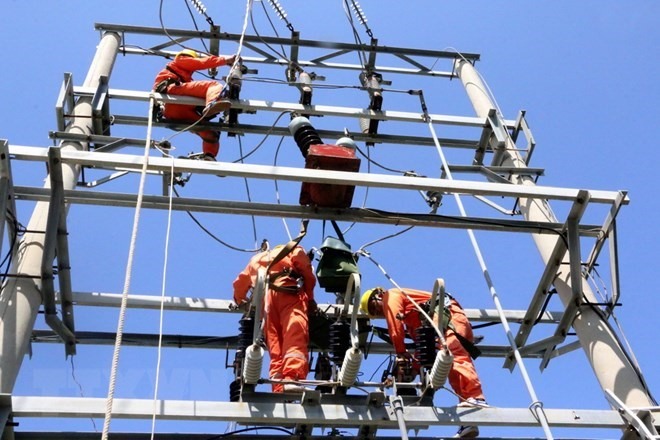 Electricity workers fix the power line on Cô Tô island. Electricity supply was resumed on Cô Tô island in northern QuảngNinh Province on Friday after the power line was struck by lightning earlier this month. The power line was damaged by heavy rains and lighting on June 18, causing power loss to Cô Tô and five other communes. The local electricity department had mobilised divers and various means to replace the damaged submarine cables. However, the local authorities have warned tourists to limit their visit to the island for now due to rough seas and water shortage. Tourists to CôTô island are advised to have a backup plan in case they get stuck on the island. From June 24 to 26, 5,500 tourists were stranded on the island due to rough seas. The Quảng Ninh Inland Waterways Port Authority had to ban ships from leaving the port. During the peak season in summer, Cô Tô island receives 7,000-10,000 tourists per day. Binh Dinh strives to deal with EU “yellow card” The fishery sector of central Binh Dinh province has employed solutions to prevent local fishermen from violating waters of regional countries, helping deal with the “yellow card” issued by the European Commission (EC), a provincial official has said. Tran Van Phuc, Deputy Director of the provincial Department of Agriculture and Rural Development, said local agencies have increased inspections of fishing activities at the three largest ports of Quy Nhon, De Gi and Tam Quan. Over the past three months, up to 5,896 fishing boats and more than 20,000 tonnes of seafood were monitored by the provincial Department of Agriculture and Rural Development. Phuc said captains have to present relevant documents to competent agencies, inform them about where they will fish before setting sail. They also have inform agencies of their return to port at least an hour before docking. Local fishermen have committed to not violating foreign waters while fishing. Training courses have also been held to raise their awareness of the “yellow card” warning. Those who violate the commitments could get administrative fines, no longer receive support from the Government and have fishing licenses revoked for six months. The European Commission has noted Vietnam’s efforts in addressing illegal, unreported and unregulated (or IUU) fishing and its inspectors will return to Vietnam in January next year to review progress in addressing its ‘yellow card’ warning. The Ministry of Agriculture and Rural Development said despite considerable achievements, Vietnam still struggles with IUU, especially in controlling fishing activities and origin of fishing catches. Vietnamese authorities have admitted that the country lacks the budget to fit all fishing vessels with proper tracking equipment. They also said that despite the country’s integration of the EC’s recommendations into its 2017 fisheries law, regulations are lacking at local level. The EC issued the "yellow card" against Vietnamese aquaculture products on October 23 last year. Vietnam Red Cross sends more aid to flood victims Members of the Vietnam Red Cross Society present aid to flood victims in Sin Ho district of Lai Chau province The Vietnam Red Cross Society (VRCS) has sent the second batch of urgent aid worth over 870 million VND (37,900 USD) to victims of recent floods and landslides in the two northern mountainous provinces of Lai Chau and Ha Giang. Accordingly, the organisation offered 210 million VND in cash for 70 families whose houses were swept away or collapsed, along with 240 boxes of goods and 600 personal hygiene kits. Earlier on June 25, the VRCS presented assistance worth 250 million VND to families of victims who were dead or injured during the floods in the two provinces. According to the Central Steering Committee for Natural Disaster Prevention and Control, as of June 28 morning, the death toll in floods and landslides triggered by torrential rains in northern mountainous provinces on June 23-26 reached 23, while 10 others went missing. In Lai Chau alone, 16 people were killed, nine went missing and 15 were injured. Total economic losses are estimated to reach about 458.7 billion VND (19.9 million USD), with Lai Chau being the hardest hit with damages amounting to 338 billion VND. People in Lai Chau province have continued to receive support from organisations and agencies to overcome losses in recent floods and landslides. Lai Chau to date has received about 2.3 billion VND from donors across the country. Of the amount, one billion VND came from Ho Chi Minh City, 300 million VND from the Vietnam Bank for Agriculture and Rural Development (Agribank). Dien Bien and Son La provinces also offered 200 million VND each. The province has decided to present 35 million VND for each family losing their home and 15 million VND for each household whose house was damaged. The Vietnam Fatherland Front chapter in Lai Chau and local authorities are responsible for the prompt distribution of the aid to people in need. Quang Ngai: Exhibition on Ly Son’s sea and islands opens 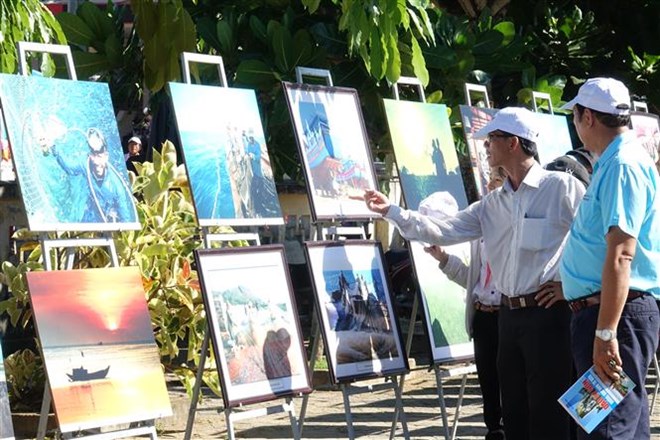 Visitors look at photos of the exhibition An exhibition entitled "Ly Son - Sea and Island Culture Heritage” opened in Ly Son district of the central province of Quang Ngai on June 29 as part of the first Ly Son Culture - Tourism Week. On showcase are about 80 images and 50 exhibits and documents introducing Ly Son’s geological characteristics and history, along with locals’ daily life and their activities to protect the country’s sea and island sovereignty. Using the digital 3D technology, the exhibition also displays maps and documents on Vietnam’s Hoang Sa (Paracel) and Truong Sa (Spratly) archipelagoes. The maps and documents are seen as historical and legal evidence proving Vietnamese sovereignty over the islands. Vice Chairman of the district People’s Committee Le Van Ninh said the event aims to introduce Ly Son’s traditional cultural values, festivals and beautiful landscapes to both locals and foreign tourists. In addition, it also proves Vietnam’s sovereignty over Hoang Sa and Truong Sa archipelagoes as well as raises public awareness of protecting the national sovereignty over the islands, he added. The exhibition and the Ly Son Culture - Tourism Week will run until July 2. Phu Quoc island invests in six power works The Southern Power Corporation of the Electricity of Vietnam (EVN SPC) is investing in building six new power works in Phu Quoc island district of the Mekong Delta province of Kien Giang. With total investment worth 3.3 trillion VND (143.7 million USD), those projects are designed to ensure constant and stable electricity supply for the island’s socio-economic development. They include two 110kV transformer stations of South Phu Quoc and North Phu Quoc, which is being built at a cost of 61.2 billion VND and 71 billion VND, respectively. Some 156 billion VND has been spent on a 110 kV Phu Quoc switching station, while the remaining has been allocated for construction of two 110 kV power lines and a 220 kV line connecting Kien Binh commune of Kien Luong district with Phu Quoc. Director of the SPC Project Management Board Vo Quoc Tuan said the 110kV power works are expected to become operational within this year. Chairman of the provincial People’s Committee Pham Vu Hong has instructed Phu Quoc authorities and the SPC to step up communications to help local residents understand benefits of the power works and devise suitable compensation and land clearance plans. Kien Giang aims to mobilise 9.5 billion USD for socio-economic development by 2020 and 45 billion USD by 2030. The adjusted target was recently approved by the Prime Minister as part of a master plan to 2020 and towards 2030 for the province. The province targets becoming a well-developed locality and a transportation and tourism service destination in the Mekong Delta, and a development hub of the southern key economic region. It aims for an average Gross Regional Domestic Product (GRDP) of 7.5-8 percent per year by 2020. Large-scale fields yield higher profits for farmers in Ninh Thuan 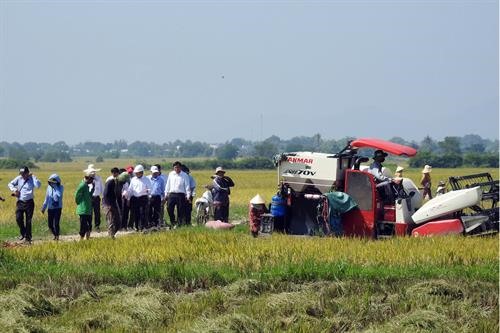 People visit a large-scale rice field that produces rice seeds for cultivation in Ninh Thuận Province’s Ninh Phước District. Farmers in the south-central province of Ninh Thuận are planting more rice, corn, sugarcane and other crops on large-scale fields to raise incomes. As many as 103 ethnic Chăm households, who are part of the Phước Hậu Agricultural Services Co-operative, planted TH 41 rice seeds last year on the province’s first large-scale field, which covers 56 ha in Ninh Phước District. Under the model, the households must use certified or quality seeds and reduce the use of seed, fertilisers, herbicides, irrigation water and post-harvest losses. In the first crop produced on the large-scale field, the households harvested more than 8 tonnes of rice seeds per hectare, up 2.5 tonnes compared to normal fields. The Nha Hố Seed Joint-Stock Company signed a contract with the co-operative to buy all output of the large–scale field. Quảng Đại Hoàng, chairman of the Phước Hậu Agricultural Services Co-operative, said that many households registered to expand the large–scale field to 100ha for the 2017-2018 winter – spring rice crop. “The success of the model has changed the outdated farming habits of Chăm households here,” he said. The techniques of sowing rice seeds in lines and using fewer seeds helped farmers save 150-200 kilos of rice seeds per hectare compared to traditional sowing techniques, he said. The planting of the same variety of rice seeds and the use of the same cultivation schedule for the large–scale field had improved productivity and reduced production costs. In the 2017-2018 winter-spring field, the province developed an additional nine large-scale fields with a total area of 986ha. Of the figure, Ninh Phước had six large-scale fields, producing rice and corn seeds for cultivation and asparagus. The Phước An Agricultural Service Co-operative in Ninh Phước’s Phước Vinh Commune is producing hybrid corn seeds for cultivation on an 80ha large-scale field. The co-operative’s members have made a profit of VNĐ40-50 million (US$1,760 – 2,200) per hectare a crop, up VNĐ29 – 33 million compared to planting corn for consumption. Lê Phúc Hoa, director of the Phước An Agricultural Service Co-operative, said the co-operative focused on guaranteeing an outlet for its members and supplying material inputs for them. The co-operative has worked with companies to expand cultivating areas and ensure outlets for members, he said. Trương Thịnh, who participated in a large-scale rice field in the 2017-18 winter-spring crop, said his 3ha rice field had a yield of nearly 9 tonnes of ML 48 paddy per hectare, up nearly 500 kilos per hectare against the 2016-17 winter-spring crop. He earned a profit of VNĐ20 million per hectare. “With high profits, many farmers will invest in expanding large-scale rice fields in the summer-autumn crop,” he said. Nguyễn Hữu Đức, chairman of the Ninh Phước District People’s Committee, said the model of large-scale fields had been used for three crops with positive results. The area of large-scale fields had increased after each crop. The model eliminated outdated farming techniques and small-scale production, increased links among farmers, and reduced production costs, he said. Ninh Phước District plans to increase the area of large-scale rice fields to 766ha this year, and encourage farmers to plant corn and asparagus by 2020. This year, Ninh Thuận plans to develop 14 large-scale fields with a total of 1,424ha. Local authorities have helped farmers take part in large-scale fields, including a 180ha large-scale sugarcane field in Ninh Sơn District and a 30ha large-scale grape field in Ninh Hải District. The provincial People’s Committee has told agencies to support co-operatives and stakeholders who participate in large-scale fields. The dry season lasts up to nine months in Ninh Thuận, which has the least rainfall of any area in the country. Mainstream media remains key platform in digital era: experts 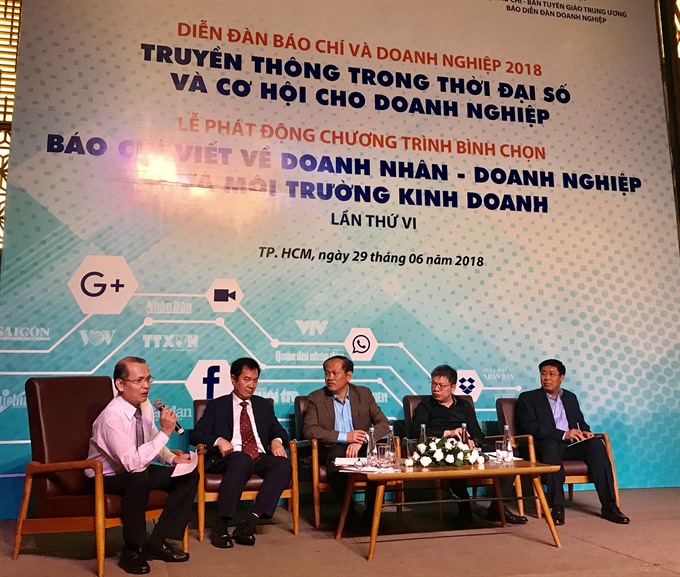 A panel at the forum “Media in the Digital Age and Opportunities for Enterprises” held yesterday in HCM City. Though new media platforms such as social media have become increasingly popular, mainstream media remains the major channel to promote the growing business community in Việt Nam, speakers said at a forum held yesterday in HCM City. Vũ Tiến Lộc, chairman of the Việt Nam Chamber of Commerce and Industry (VCCI), said “A country’s prosperity is reflected through its economy with businesspeople playing an important role, which should be a key focus of media coverage.” Speaking at the forum “Media in the Digital Age and Opportunities for Enterprises”, Lộc noted that media products today should be shorter, faster and easier to understand, and have more visual appeal. “In the context of fake news, the media should reflect multi-dimensional information in an objective, accurate, honest and timely manner,” he said. “More in-depth analysis of business activities and investment should be produced to promote the business community, which still faces challenges.” Vũ Đình Thường, head of the Journalism and Publishing Department of the Party Central Committee’s Commission for Publicity and Education , said: “The press and business community should stand together for a better growing business community.” "Social media is now a popular platform with both positive and negative effects," he said, adding that inaccurate information and fake news could cause serious consequences to enterprises. “Journalists need to continue renewing and exerting more efforts to keep their role and position in guiding public opinion,” he said. Dr Phạm Hải Chung, lecturer and researcher at the Academy of Journalism and Communication, said that digitalised information was challenging traditional news concepts. “However, even though anyone with a smartphone can be a citizen journalist, the mainstream media will still play the objective role of a third party that can verify sources,” she told Việt Nam News. Lê Quốc Vinh, chairman of Le Group, said the fight against false information or fake news had become increasingly important. “The mainstream media must create trust among the public,” he said, adding that the content and accuracy of the information would be key to the continued existence and prestige of a newspaper. According to Reuters 2018’s Digital News Report, the biggest challenge of press agencies is not only pressure to rush in the digital age, but also the loss of trust of readers. Readers’ habits are changing and moving from traditional media to digital media, including social media. With a strong force of nearly 850 media agencies and more than 18,000 reporters with press cards, and a Việt Nam Journalists’ Association with more than 22,000 members, the Vietnamese press has become a pioneer in the ideology battlefield. The forum’s organiser, Business Forum newspaper, plans to offer awards to journalists for the best articles about the businesses community in Việt Nam. Submitted articles will be about profiles of innovative businesspeople or Government policies. The forum was attended by representatives of newspapers’ leaders and enterprises in the city. Flood relief work underway  Police and army forces were working together to search for four people who were still missing after a landslide at Noong Hẻo in Lai Châu Province’s Sìn Hồ District. Flood recovery work is underway in the northern provinces of Lai Châu, Hà Giang, Lào Cai and Điện Biên after days of torrential rain claimed lives and destroyed property. Local authorities have mobilised all forces and vehicles with priority given to find people who are still missing and support people in repairing their houses and resuming production. In Lai Châu Province, efforts were being made to promptly relocate households in areas at risk of flash floods and landslides. By 12pm on Friday, 233 households had been evacuated to safer areas. Police and army forces were working together to search for nine people who were still missing. The incident happened in a remote area and it was difficult for rescuers to access. Meanwhile, workers were striving to clear the road so that traffic could resume on all routes. The province was trying to provide food and water for 20 households in the Sà Dề Phìn Commune in Sìn Hồ District, which are isolated due to a landslide. Lai Châu Province is considered the hardest-hit locality with 16 people killed and nine missing in the floods. As many as 452 houses in the province have been reported either damaged or swept away. Over 1,000 ha of rice and maize cultivation have been destroyed. Flood recovery work was also underway in Hà Giang Province which suffered VNĐ122 billion (US$5.3 million) in damage from the floods. On Thursday night, the provincial Party Committee held a meeting with the province’s Steering Committee for Natural Disaster Prevention, Search and Rescue to discuss measures to direct flood-relief work. At the meeting, Triệu Tài Vinh, Hà Giang Province’s Party Secretary, asked local authorities to calculate the damage and adopt measures to help affected victims stabilize their lives. Localities were requested to provide assistance of VNĐ6 million per family of each person killed in the floods and VNĐ20 million for households that lost their homes to the floods. In the Quản Bạ District, police forces and civil servants were mobilised to help local residents rebuild their houses and return their lives to normal. Competent agencies were ordered to collaborate with communes in arranging housing for families whose houses were displaced or lie in landslide-prone areas. Quản Bạ district authorities also instructed local authorities to disseminate information to warn people who are living in places where there is a high risk of landslides and flash floods so that they will be vigilant and take appropriate measures in case they face a bad situation. According to the latest report of the Central Steering Committee on Natural Disaster Prevention and Control, flash floods have killed 23 people and left 11 missing in northern mountainous provinces, mostly in Hà Giang, Lai Châu, Lào Cai and Điện Biên. Torrential rains and floods have also swept away 161 houses, damaged 958 houses and submerged thousands of hectares of crops. Roads and irrigation works have also been damaged, causing losses of VNĐ487 billion ($20.9 million) VNN |
↧
↧
Article 0
Vietnamese natural makeup brands prosper in home market After many years of using only French makeup, My Ha, 40, from Phu Nhuan district in HCM City has begun using natural products made by Vietnamese enterprises.
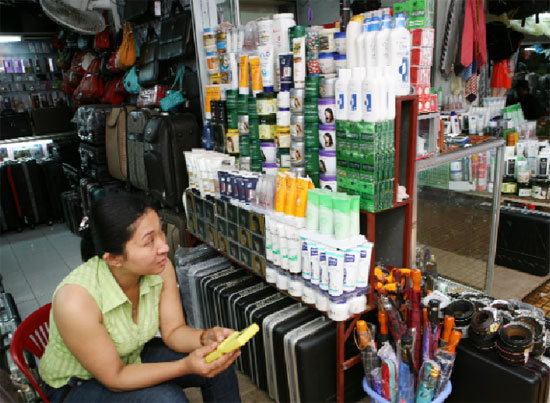 Most of the products available in the market are imports My Ha, a ‘follower’ of the ‘live green’ movement, found a showroom that sells skin-care products made by Vietnamese enterprises on Mac Thi Buoi street in district 1. “Vietnamese enterprises have great advantages in making natural products because of the material sources in Vietnam,” she explained. “Made-in-Vietnam cosmetics no longer means low-cost products,” she said. The number of customers, mostly women, has been increasing rapidly in large cities. The market segment has become large enough for domestic cosmetics companies to display products at luxury showrooms in the central business districts of Hanoi and HCM City. Since mid-October 2018, natural makeup fans in Vietnam can easily buy products at labambivalley.com, a website set up by six cosmetics companies. Designed as a cosmetics supermarket, the website gathers products licensed by the Ministry of Health and made by prestigious brands, namely TheHerbalCup, Skinna, SheaGhana, Myin, Karose and Bambi green cosmetics.
Through the websites, six natural cosmetics companies can easily access customers throughout the country at the lowest possible costs. With the attractive growth rate of 30 percent per annum, the Vietnamese cosmetics market brings great opportunities. Not having advantages in distribution networks and advertisement budgets, the companies still can sell well in niche markets. The long-distance race Nguyen Thu Lanh, the founder of Bambi Cosmetics, said it takes many years to find and select materials, experiment with formulas and follow procedures to get permission to circulate products. “Clean materials are just one of many things manufacturers must have. Besides, they must have production conditions meeting standards set by the Ministry of Health,” she said. To do this, enterprises need modern technology which has to be imported at high tax rates. Nguyen Van Minh, chair of the Vietnam Association of Essential Oils, Flavors and Cosmetics, confirmed that expensive modern technologies and unstable material growing areas are the biggest problems for domestic manufacturers. However, the stories about Thorakao or Thai Duong are the typical examples proving that Vietnamese brands can also succeed if they follow the right path. There are about 100 cosmetics brands making their presence in Vietnam, while 90 percent of the products available on the market are the imports. VNN |
↧
Article 4
Gov’t discusses economic challenges for next six months HÀ NỘI — This year’s first national governmental e-meeting opened on Monday morning with Prime Minister Nguyễn Xuân Phúc asking officials to focus on solutions instead of boasting about past achievements. 214114222AM.jpg) PM Nguyễn Xuân Phúc said that the cabinet listed 18 particular issues that needed serious discussion in the coming time. They included inflation control, macroeconomic stabilisation, urban development and private economy growth among others. — VNA Photo The meeting between the central Government and localities aimed to review Việt Nam’s socio-economic development in the first half of 2018 but also to work out measures to handle weaknesses and problems in governmental management over the next six months. The PM said the country’s development in 2018 has so far progressed across all sectors, with the average gross domestic product growth of the first six months standing at 7.08 per cent. The growth of the industrial, agricultural and services sectors was all reported higher than during the same period last year. “The World Bank forecast Việt Nam’s growth this year at more than 6.8 per cent while Fitch ranked Việt Nam as one of the fastest-growing economies in the Asia-Pacific. But they were just their predictions and whether we can really pull them off depends on our determination entirely,” Phúc told the officials. Phúc said that the cabinet listed 18 particular issues that needed serious discussion in the coming time. They included inflation control, macroeconomic stabilisation, urban development and private economy growth among others. “I suggest that we don’t talk much about our achievements but rather bring practical solutions to the localities’ and the country’s problem,” he said. Inflation put major pressure on the Government as the consumer price index (CPI) shot up in the first six months this year, standing at 0.61 per cent on average– the highest rate recorded over the last seven years. To hold the inflation rate at no higher than 4 per cent, the PM affirmed that the Government would not increase the electricity price this year while medical services were unlikely to see any price hike unless certain conditions were met. Economic growth was not the only concern of the Government. Phúc told the officials that risks could undermine the country’s development in the coming time, including natural disaster, social security and other pressing social issues like traffic safety, food safety and corruption. He cited the riot in Bình Thuận Province last month as an example showing the importance for other localities to ensure security and social order in order to protect the citizens. VNS |
↧
Article 3
BUSINESS IN BRIEF 3/7 Two hacked customers lose VND200 million in DongA Bank overnight Two DongA Bank cardholders confirmed that they are still holding their ATM cards and have never given them to anyone, but VND201 million ($8,855) was stolen from their accounts in the middle of the night. Nguyen Thi Phuong Thuy (District 12, Ho Chi Minh City) is a client of DongA Bank who had VND86 million ($3,790) withdrawn from her account through an ATM early on June 26. Thuy said at around 3.30 AM on June 27, DongA Bank sent her several messages informing her that VND60 million ($2,640) has been transferred from her account to three others. A few minutes later, she was informed that another VND20 million ($880) was withdrawn in cash while she was still sleeping. At 4 AM, another message showed that another VND5 million ($220) was withdrawn from her account. She woke up and found her ATM card in her bag. “I called DongA Bank’s hotline to freeze the account, but it was too late, only VND900,000 ($40) was left on it,” Thuy said. In the morning, she went to DongA Bank to report the incident that lost her altogether VND85 million ($3,750). The bank told her that money was withdrawn at an ATM machine in Tan Phu district, Ho Chi Minh City, and that they will find out more within the next five days. Thuy confirmed that she did not share her password with anybody. “A day before, I withdrew VND2 million ($88) from an ATM in Quang Trung Street. And I cannot tell for sure whether any device has been used to copy my information,” she added. In another case, Doan Thi Ngoc Duyen (District 12) reported to VnExpress.net that she also had money withdrawn from her account at around 3.55 AM on June 27. DongA Bank sent five messages to inform that VND96 million ($4,230) had been transferred (in five installments) to other accounts. A few minutes later, Duyen received another messages about withdrawing an additional VND20 million ($880) in cash from her account. As a result, she lost a total of VND116 million ($5,110). She was very worried and made sure that her card was still in her wallet. She called the hotline of DongA Bank to freeze the account, but she was too late as only VND320,000 ($14) was left on the account. In the morning, she went to DongA Bank to report the incident. The bank identified that the same ATM was used at the same time to withdraw her and Thuy’s money. The representative of DongA Bank told VnExpress.net that this bank is investigating the incident and is going to respond to the client as soon as possible. Against the trend of high technology crime increasing rapidly in Vietnam, the safety of cardholders is the priority, and the bank would do their utmost to strengthen security for them. He said that in addition to using skimming devices to copy and forge fake cards, another leading cause of losing money is revealing card information to family members or friends. DongA Bank’s representative recommended customers to keep the PIN codes secret from everyone. The Ministry of Public Security’s Department of Hi-Tech Crime (C50) showed several methods criminals use to hack bank accounts. The most popular measure is to steal data at ATMs. A set of skimming devices includes an ultra-small camera set up with a sighting on the ATM’s keypad, a card skimmer inserted into the card slot, and a keypad skimmer placed over the ATM’s keypad. This equipment is used to appropriate the PIN code and card number of anyone using the ATM. Then the criminals create fake cards and will start stealing money via ATM withdrawals. Another way is when criminals create websites and inform victims via Facebook, Zalo, Viber, and SMS that they won a valuable prize, asking them to sign in on the website and get their prize. Criminals may also act as bank officer to contact cardholders to ask them to provide information (PIN code, card number, OTP code). Thereby, customer should improve their knowledge and be vary of suspicious signs of hi-tech fraud. MobiFone to sell its shares in TPBank Việt Nam Mobile Telecom Services Corporation (MobiFone) plans to sell its total of more than 5.5 million shares in Tiên Phong Commercial Joint Stock Bank (TPBank). The minimum bid price will not be lower than VNĐ29,510 (US$1.28) per share. The reference price is the average over 30 trading days on the stock market. The transaction method is matching order via HCM Stock Exchange. MobiFone expects to collect at least VNĐ163.7 billion from this divestment. MobiFone is currently a State shareholder at TPBank, owning 5,549,914 TPBank shares and is expected to transfer all of these shares to ensure compliance with the regulations of the State and add to the firm’s mobile fund serving business and production. Bac Giang earns 5.4 trillion VND from lychees The northern province of Bac Giang has so far sold 191,000 tonnes of lychees for over 5.4 trillion VND (236.8 million USD), according to the provincial Department of Industry and Trade. Of the figure, about 3.26 trillion VND was from lychee sales and the remaining from support services. The province exported 72,250 tonnes of lychees, earning 126.8 million USD. Bac Giang’s lychees were mainly shipped to China, with 71,250 tonnes and 125 million USD. The remaining 1,000 tonnes, worth 1.8 million USD, were exported to several EU countries, Russia, Singapore, Thailand, Australia, the US, Canada, Japan and the Republic of Korea. Bac Giang’s specialty fruit has also been consumed across the country, especially Hanoi, Quang Ninh, Hai Phong, Hue, Da Nang, Ho Chi Minh City, and southern provinces via wholesale markets, trade centres and supermarkets. This year, the lychee prices are relatively stable, ranging from 8,000 VND to 25,000 VND per kilogram. Lychees for export are sold at between 15,000 VND and 25,000 VND per kilogram. As the main harvest season will end in the next 10-15 days, with an output equivalent to 30 percent of the total production, authorities recommended people use safe plant protection chemicals to ensure the best quality, prestige and trademark of Bac Giang lychees. Lychee is one of the 52 key agricultural products of Bac Giang, a list approved by local authorities in 2017. About 13,500ha of lychee trees in Bac Giang are farmed under VietGAP standards with an estimated output of 90,000 tonnes. Of that area, 218ha with more than 10,000 tonnes of lychees are cultivated under GlobalGAP standards and eligible for export to demanding markets. Total lychee output in the province is expected at 150,000 – 180,000 tonnes in 2018. Domestic firms assisted to boost veggie, fruit exports to China 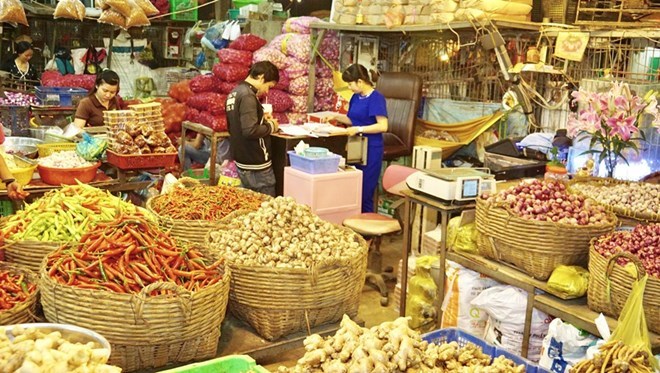 The Vietnam Trade Promotion Agency (Vietrade) under the Ministry of Industry and Trade has supported businesses to promote Vietnam’s farm produce and food products in the world, especially Asian markets such as China and the Republic of Korea (RoK). Vietrade has sent many business delegations to the Chinese and RoK markets to carry out trade exchange programmes and join trade fairs so as to directly meet potential customers. Recently, the agency has helped eight domestic enterprises in agricultural production introduce fresh and dried fruits at the Guangzhou International Fruit Expo 2018 in China’s Guangdong province, which also drew businesses from many countries in the world including Greece, Australia, Turkey, Spain, Chile, Thailand, Argentina, Indonesia and Malaysia. A Vietrade representative said that Guangdong has been the biggest fruit importer in China, adding that the fair was a good chance for Vietnamese fruit producers and suppliers to promote their products and seek partners and customers, thus boosting their exports. In the first five months of 2018, Vietnam’s vegetable and fruit exports to major markets saw a relatively high growth rate, with the highest rise recorded in the Chinese market, at 18.1 percent to 1.2 billion USD. Vietrade commented that China remained Vietnam’s important market as exports to China accounted for 74.6 percent of Vietnam’s total vegetable and fruit export revenue in the first five months of 2018. Vietnam’s vegetable and fruit exports to China enjoy advantages due to the market’s high demand, close geographic distance, and similarities in consumer taste. However, quality requirements in the Chinese market has increased, therefore domestic firms need to enhance their products’ quality and study the crops in China to plant suitable fruits and vegetables, avoiding depreciation, the agency said. VietjetAir to pay dividends to shareholders by shares The low-cost carrier Vietjet Air will issue more than 90.2 million shares as dividends paid to its shareholders for the last stage of 2017 at the rate of 20 percent. Accordingly, each shareholder who owns 10 shares of Vietjet Air, coded VJC on the Ho Chi Minh City Stock Exchange (HOSE), will receive additional two new shares. After paying the dividends, Vietjet Air’s charter capital will increase from 4.51 trillion VND to over 5.41 trillion VND. The deadline for dividend payment registration is July 2, 2018. Over the past year, Vietjet Air has paid high dividends to its shareholders, with over 100 percent in some particular years. Recently, the Petrovietnam Trading Company (Petechim) has purchased 100,000 shares of Vietjet Air after buying 150,000 shares previously. Hoa Phat Dung Quat Steel JSC improves administration capacity The Hoa Phat Dung Quat Steel JSC has announced that it will apply SAP S/4HANA, a next-generation enterprise resource planning (ERP) software, for its iron and steel production complex. The project will be carried out in the next 10 months. Once the project is completed, the company will have an administration system that meets international standards and helps it analyse business data in real-time and helps the company’s leaders to quickly make decisions so as to improve the company’s competitiveness. The Hoa Phat Dung Quat Steel JSC is the first one in the Hoa Phat Group to apply SAP S/4HANA. The process of the Hoa Phat Dung Quat iron and steel production complex project is on schedule with the first line expected to be operational in the third quarter of this year, meeting demands of the central and southern regions. According to Hoa Phat Group, other items are projected to be completed from the fourth quarter of this year to 2019. It aims to put both phases of the project into a trial run in late 2019. By the end of the first quarter of 2018, Hoa Phat Group reported revenue of 13 trillion VND (572 million USD), and a post-tax profit of 2.2 trillion VND (96.8 million USD), up 25 percent and 14 percent year-on-year, respectively. The steel sector remained the driver of Hoa Phat during the reviewed period, the group said. 85 products win Vietnam Gold Farming Brand As many as 85 products were honoured with Vietnam Gold Farming Brand in Hanoi on June 30. Chairman of the General Council of Agriculture and Rural Development Ho Xuan Hung said the winning products were selected from nearly 400 agri-products across the country. The council had closely worked with the Department of Agriculture and Rural Development, Department of Industry and Trade, and Associations of Farmers in cities and provinces nationwide for four months to examine the products. The programme also raised awareness of businesses and farmers about the importance of building and developing brands in business production activities to look towards sustainable exports of agricultural products, Hung said. He revealed that many small-and medium-sized enterprises (SMEs) registered for the gold brand this year. RoK firms seek partnership chances with Hoa Phat Group A delegation of investors from the Republic of Korea (RoK) has visited Hoa Phat Group, one of the three largest steel producers in Vietnam, to seek partnership opportunities. The delegation, including Kunam Kim, Global Securities Director of the KB Securities and Le Thi Quyen, Deputy General Director of KB Security Vietnam, visited two steel plants of Hoa Phat in the northern province of Hung Yen. The RoK firms showed interest in the steel production process and technology of Hoa Phat as well as the group’s growth prospects as its Dung Quat project completes. Pham Thi Oanh, Director for Finance of Hoa Phat, said that the group is strong for its river port system at Hai Duong steel integrated complex. The firm is developing a similar system in Dung Quat complex, which is expect to handle ships with capacity of up to 150,000 tonnes, she said. The ports has helped Hoa Phat reduce cost and get convenience in import-export activities, which pushes the firm up to top 50 biggest steel producers in the world, added Oanh. She also highlighted that Hoa Phat is using Italian technology, which is friendly to the environment. As the Dung Quat steel complex becomes operation, Hoa Phat’s competitiveness is expected to significantly increase, she stressed, adding that the group has focused on intensive processing and promoting added value of its products. Currently, two major products of Hoa Phat are construction steel and steel pipes. In late April this year, Hoa Phat introduced high quality painted steel sheet to the market. In early June 2018, Hoa Phat also introduced its potential to Thai investors, including One Asset Management investment fund. Programme promotes Vietnam localities in Italy The Ministry of Foreign Affairs and the Embassy of Vietnam in Italy have recently held a programme namely “Vietnam Provincial Roadshow in Italy” as part of activities to celebrate the 45th founding anniversary of the two countries’ diplomatic ties and fifth anniversary of the bilateral strategic partnership. The programme took place from June 28-29 in Milan, a metropolis in Italy’s northern Lombardy region, with the participation of Chairman of the Hanoi People’s Committee Nguyen Duc Chung, Chairman of the Can Tho People’s Council Pham Van Hieu, Secretary of the Phu Yen Party Committee and Chairman of the Phu Yen People’s Council Huynh Tan Viet, and Chairman of the Quang Ngai People’s Committee Tran Ngoc Cang. Vietnamese Ambassador to Italy Cao Chinh Thien along with representatives from the two sides’ ministries, departments and businesses were engaged in the event. The Vietnamese delegation also attended a seminar on economic opportunities between Lombardy region and localities from Vietnam, which drew over 50 Italian leading enterprises. The guests later visited some industrial production facilities and innovative start-up centres in Lombardy as well as worked with representatives from Italy-Vietnam friendship associations from different regions and cities in Italy. Nguyen Duc Chung, Chairman of the Hanoi People’s Committee, and Enrico Letta, former Italian Prime Minister and President of the Italy-ASEAN Association, agreed with the proposal of hosting a high-level conference on cooperation between ASEAN and Italy in Hanoi in May 2019 with the participation of senior officials from the Italian government and around 300 leading businesses from the European country. The department of external affairs under the Ministry of Foreign Affairs and the Italian Chamber of Commerce in Vietnam (ICHAM) signed a memorandum of understanding on cooperation to support Vietnamese and Italian localities and enterprises to enhance partnership and connectivity. Lombardy is a big economic centre in Italy with gross domestic product (GDP) of 450 billion USD, making up nearly 25 percent of the country’s GDP. The region also accounts for over 20 percent of Italy’s trade turnover and it is one of the leading economic regions in the European Union (EU). The cooperation agreement between Lombardy and Vietnam signed in 2010 has created opportunities to promote bilateral trade, which topped 1.7 billion USD in 2017. The Italian region attaches great importance and prioritise to promoting trade exchange and investment cooperation with Vietnamese localities, especially in the fields of infrastructure, machinery, mechanical engineering, high technology, food, health care, pharmacy, fashion, environment, and technical consultancy. Locality-to-locality cooperation and people-to-people exchange are one of the priorities in the Vietnam-Italy strategic partnership, significantly contributing to the reinforcement and enhancement of bilateral collaboration in all realms from politics, external affairs, and economy to culture, education, science, technology and sustainable development. Particularly, as Vietnam and the EU are pushing ahead with the ratification and implementation of their free trade agreement, this is an excellent opportunity for Vietnamese and Italian localities and businesses to tighten cooperation and trade in the fields of their strengths. Italy is currently the fourth biggest trade partner of Vietnam in the EU while Vietnam is the biggest trade partner of Italy in the Association of Southeast Asian Nations (ASEAN). The two sides welcomed the effective cooperation between the pairs: Hanoi - Lazio region/Rome city, Ho Chi Minh City - Milan and Tornio cities, Hai Phong city - Liguria region/Genoa city; Vinh Phuc province - Tuscany region, Binh Duong and Emilia-Romagna region, Ba Ria – Vung Tau and Veneto region. They are promoting the establishment of cooperative relations between Italian localities and Vietnam’s Can Tho city, Quang Ngai and Phu Yen provinces, focusing on economy, agriculture, culture and tourism. Vietnam calls on Swiss investors in agriculture Deputy Minister of Agriculture and Rural Development Tran Thanh Nam called on Swiss investors to engage in Vietnam’s agricultural sector during a trade and investment promotion forum on agriculture in Zurich, Switzerland, on June 29. Nam highlighted Vietnam’s economic achievements, including the highest growth in the region, in recent years since the country implemented its renewal policies. Vietnam is one of the world largest exporters of many agricultural products such as rice, coffee, cashew, rubber, aquatic products, wood and wooden products, he noted. The officials stressed that Vietnam is restructuring its agriculture towards higher value, high technology, organic and sustainable growth, with priority on processing and raising quality and added value of agricultural products. Swiss businesses operating in Vietnam’s agriculture sector, including Nestle, Tetra Pak, Buhler, Bucher, Syngenta, have shown their pioneering role in renovating their products, enhancing quality and added value of the products, thus promoting many farm produce of Vietnam in the international market, he said. Vietnam and the European Free Trade Area (EFTA), in which Switzerland is a member, have been negotiating for a free trade agreement. After being signed and becoming effective, the deal will open up great chances for businesses of both sides to boost their partnership, Nam said. Meanwhile, Marc Townsend, Chairman of the Vietnam Committee under the Swiss-Asian Chamber of Commerce, said that many Swiss firms has long experience in partnering with Vietnamese farmers, including Nestle that has been operating in the Southeast Asian country since 1912. Vietnam is strong in the production of rice, pepper corn, cashew and tropical fruits, he held. Townsend revealed that Swiss enterprises interested in Vietnam have considered the introduction of new Swiss invention into Vietnam, including environmental-friendly technology, and smart cultivation techniques. They have sought opportunities to bring Vietnamese products to the world, he added. He asserted that the investment environment of Vietnam is attractive. He advised Swiss firms who are keen on expanding investment in Vietnam should thoroughly study the market and demand in Vietnam, along with the culture and working methods of Vietnamese people. Tran Van Cong, deputy head of the Department of Farm Produce Processing and Market Development under the Ministry of Agriculture and Rural Development, introduced investment and business opportunities in Vietnam’s agricultural sector. Vietnam is now ranking 13th in the world in terms of farm produce exports, while its agricultural products have been available in 180 countries. Vietnam has 10 major products with export revenue exceeding 1 billion USD - aquatic products, wood and wooden products, cashew, coffee, vegetable, rice, pepper corn, rubber and cassava. Cong also clarified Vietnam’s policies in luring investment in agriculture and rural development as well as incentives for high technology businesses. He said that Vietnam is willing to apply special preferential policies for Swiss firms in agricultural machineries, processing technology, and high-tech agriculture. On the sidelines of the forum, businesses of both sides tasted famous agricultural and beverage products of Vietnam. Tra Vinh farmers grow mangrove forests to breed shrimp Farmers in coastal Tra Vinh have planted more than 4,000ha of mangrove forests to breed shrimp and other aquatic species, according to the provincial Department of Agriculture and Rural Development. They are mostly in Duyen Hai, Cau Ngang, and Chau Thanh districts and Duyen Hai town. The model of growing mangrove forests and breeding aquatic species in them is highly sustainable since it protects the environment amid the ravages caused by climate change, according to the department. Besides it involves little investment and protects the shrimp from disease outbreaks, according to local authorities. Huynh Van Phong, who has 4ha of land in Duyen Hai town, said he grew forests on 2ha to breed aquatic species. He raises 50,000 black tiger shrimp and 6,000 mud crabs every year through extensive farming and earns a profit of more than 200 million VND (8,850 USD), he said. He has to spend money only on buying shrimp and crabs fry for breeding, and nothing on their food since they subsist on what they find in the forest, he said. Phong also breeds blood cockles and mud clams in the submerged forest and earns dozens of million of VND a year. Pham Thi Hong Diem, Deputy Head of Duyen Hai district’s Agriculture and Rural Development Bureau, said the industrial shrimp farming model yields high profits but involves high costs for breeding facilities unlike the mangrove-shrimp model. Besides, the risks of the environmental pollution and disease outbreaks are high, she said. Duyen Hai district has more than 8,500ha of shrimp farms, according to the bureau, with the shrimp – forest model accounting for nearly 60 percent. The bureau plans to petition the district People’s Committee and province People’s Committee to help establish a value chain to supply organic shrimp to the market. The chain will help farmers increase their profits, sustain the shrimp – forest model, protect the environment and provide the market with clean shrimp. The Mekong Delta province has more than 9,000ha of forests, including more than 4,000ha submerged forests grown by farmers, according to the department. Tra Vinh farmers raise brackish shrimp on a total area of 24,000ha and harvest 37,000 tonnes a year, according to the department. Its first high-tech shrimp breeding centre has been supplying quality fry to the market since March. The centre, owned by the Thong Thuan Group, has already supplied more than 250 million shrimp fry, mostly white-legged shrimp, to farmers in Tra Vinh and other delta provinces. Tran Trung Hien, director of the department, said the centre has a capacity of more than 5.5 billion white-legged shrimp, black-tiger shrimp and blue-legged prawn fry a year. It would help ensure supply of quality shrimp fry for farming, he said. Tra Vinh has bred 1.35 billion black tiger shrimp fry and 3.1 billion white-legged shrimp fry so far this year. It has 72 other breeding establishments that can supply around 1 billion black-tiger shrimp fry annually. Vietnamese, German businesses commit to fight wildlife crimes Representatives of more than 40 Vietnamese and German companies in Vietnam pledged to adopt a zero-tolerance policy towards wildlife crimes at a workshop in Hanoi on June 29. They agreed to take a public stand against the illegal trading, transport and consumption of wild animals and related products, and pass on the message to their clients and staff throughout their companies. The event, organised by TRAFFIC with funding from WWF-Germany and Intelligentmedia behavioural change communication company, aims to encourage the business community to step forward to handle social and environmental issues. “Wildlife trafficking is transnational by nature and bears repercussions that are felt worldwide. It is an issue that resonates with the German people, and we are pleased with this opportunity for German and Vietnamese companies to come together and spread a united message against this crime,” said Katharina Trump, programme manager, anti-poaching, WWF-Germany. Through the workshop, participants were given an opportunity to learn how to enact a corporate social responsibility (CSR) policy to attract environment-conscious clients, increase competitiveness and mitigate potential risks. The workshop featured discussions on how companies could construct meaningful messages and incorporate them in CSR activities that would be effective in combating wildlife crimes and lead to a change of practices among their colleagues and customers. Participants learnt that adopting these policies could strengthen the reputation of their businesses by ensuring they were not inadvertently participating in wildlife crime. The event is the latest in a series of activities organised by TRAFFIC with different companies and civil society organisations, such as Vietnam Chamber for Commerce and Industry, Vietnam E-Commerce Association and the Vietnam Automobile Transportation Association, which work towards the eradication of animal trafficking by encouraging companies to take a strong stand against wildlife crimes. TRAFFIC’s efforts to encourage companies to integrate wildlife protection into their CSR activities have spanned the business, tourism and hospitality sectors. Anti-trafficking messages have been put up on buses, websites, events and other platforms, reaching some 250,000 people. Vietnamese, Italian localities boost economic cooperation A seminar highlighting economic cooperation between Lombardy region of Italy and Vietnamese cities and provinces took place in Milan city on June 29. As part of series of activities marking the 45th anniversary of Vietnam-Italy diplomatic relations, the event was jointly organised by the authorities of Lombardy region, the Vietnamese Foreign Ministry’s Department of Provincial Foreign Affairs and the Vietnamese Embassy in Italy. In his opening speech, Altitonante, a representative from the Lombardy administration, stated that Vietnam is a potential market for the region’s businesses. With its advanced science and technology in production and services, Lombardy has always paid attention to fostering its businesses’ investment and technological transfer activities in promising markets like Vietnam. This is an important development objective of local enterprises, he affirmed. Vietnamese Ambassador to Italy Cao Chinh Thien said that despite recent positive developments, cooperation between Vietnam and Italy, especially in economy and trade, is still yet to match fruitful bilateral political relations as well as potential and expectations of the two nations. He stated that Vietnam and the EU are working toward the signing and ratification of the EU-Vietnam Free Trade Agreement (EVFTA) and Vietnam is implementing policies to foster and expand relations with countries around the world, especially those it has strategic partnership with like Italy. It is a suitable time for Italian and Vietnamese localities, businesses and investors to study collaboration opportunities and grasp information on each other’s markets, particularly in areas that the two countries have demand for cooperation such as transport infrastructure, energy, industry and waste treatment, he noted. At the seminar, representatives from Vietnamese localities and businesses introduced their development potential and preferential policies on investment attraction while the Italians presented their production and business activities as well as their demands for expanding cooperation with and promoting technological transfer for Vietnamese enterprises. With a young population, trained workforce with low cost, and notably the rapid growth of middle and upper classes, Vietnam is an attractive destination for Italian investors, said participants. Nguyen Duc Chung, Chairman of the Hanoi People’s Committee, stressed that Italy is the fourth largest trade partner of Vietnam in the EU while Vietnam is the biggest trade partner of Italy in ASEAN. He expressed his belief that once the EVFTA takes effect, trade relations between the two nations will further develop, adding that Lombardy region’s strengths are suitable to development demands of Vietnamese localities. Hanoi and other localities in Vietnam are actively improving their investment climate and stepping up administrative reforms targeting people and businesses. They wish to cooperate with Lombardy region in areas of its strengths such as tourism, food processing, construction, pharmaceutical technology, renewable energy, heritage conservation, and smart city building. At the end of the seminar, representatives of Vietnamese cities and provinces witnessed the signing of an agreement on cooperation in fostering connectivity between Vietnamese and Italian localities and businesses by the Vietnamese Foreign Ministry’s Department of Provincial Foreign Affairs and the Italian Chamber of Commerce in Vietnam. Vietnam promotes tourism in Chinese northeastern province A Vietnam – China cultural, tourism and trade exchange took place in Shenyang city, China’s northeastern province of Liaoning, on June 29 with an aim to introduce the Vietnamese country and people to local residents. Opening the event, Vietnamese Ambassador to China Dang Minh Khoi affirmed that Vietnam – China comprehensive strategic cooperative partnership grew stably and actively last year. He said high-level visits and contacts were maintained regularly while ties between ministries, agencies and localities became increasingly close. The diplomat also reported that two-way trade topped 100 billion USD in 2017 with Vietnam being China’s largest trade partner in ASEAN and the eighth largest partner globally. The number of Chinese tourists in Vietnam kept increasing, he said. He stressed that Vietnam always highly welcomes and creates favourable conditions for Chinese firms to do business in the country, with priority given to hi-tech and environmentally-friendly projects that pay attention to workers’ interest and community activities. The ambassador also expressed welcome to Chinese tourists, including those living in the northeast and Liaoning, to visit Vietnam to feel the people’s hospitality. With beautiful landscapes, unique culture and modern tourism infrastructure, Vietnam is able to meet diverse and increasingly high demand of Chinese visitors, he said. Vice Chairman of the Liaoning provincial chapter of the Chinese People’s Political Consultative Conference Gao Ke, for his part, lauded the Vietnamese Embassy in China, ministries and agencies concerned for bringing Vietnam closer to the northeast China and Liaoning in particular through tourism promotion activities. He believed that more Liaoning people and enterprises will travel to Vietnam for sightseeing and business opportunities. On the occasion, the national flag carrier Vietnam Airlines launched a direct route linking Shenyang and Vietnam’s Nha Trang beach resort city, making it easier for Liaoning people to travel to Vietnam for leisure and investment. Wholesale markets need more investment Regarding the country’s key food distribution networks, wholesale markets have not yet undergone proper planning and development so far, according to experts. Thus, policies are necessary to develop wholesale markets to ensure food safety standards and clear origins of products, according to opinions at a recent meeting on wholesale markets in Vietnam. A recent report by the Ministry of Industry and Commerce (MoIC) showed that by the end of 2017, there were 8,539 markets, of which 83 were wholesale markets, accounting for 0.97 percent. Most wholesale markets were in the provinces of Thanh Hoa, Quang Binh, Dong Thap, Tien Giang, Hung Yen, and Hanoi and HCM City. The markets sold various products, from vegetables, meat and seafood to dry and semi-processed foods, said the report. Nguyen Van Hoi, Vice Director of MoIC’s Domestic Market Department told online newspaper vietnamplus.vn that along with modern retail models, wholesale markets had an effective network of product distribution which plays an important role in connecting producers, distributors and consumers and contributing to enhancing business capability of Vietnamese wholesalers, retailers and enterprises as well. Additionally, a system of wholesale markets also helps stabilise prices and create jobs for labourers who live nearby. Despite their important role, investment in wholesale markets has been modest, reported the paper. Most wholesale markets had sparse infrastructure with few services, unhygienic environments and lack of fire fighting systems. In Hanoi, there were 6 wholesale markets. But they were on such a small scale that market prices could not be regulated. Managing the quality of products at wholesale markets was also difficult, said Dao Ha Chung, President of HCM City’s Hi-tech Association. “Vehicles transporting goods to the markets must be tightly controlled to ensure food safety”, said Chung. “The wholesale markets must be equipped with systems to assess the origins of goods as well as their supply chains”, he said. The prices of goods at the markets must be transparent and could not manipulated, he added. Sharing experiences of developing wholesale markets, Ricardo Lopez Piestch, a representative from Spain’s Mercasa Group, which owns 23 wholesale markets in Spain, said that one successful idea was to ensure the presence of farmers at wholesale markets. This would help farmers to understand market demands, he said. Food safety was tightly monitored by inspectors. This was an important factor for the quality of wholesale markets, he added. Vu Duy Dong, Head of Domestic Market Department, said to further develop networks of wholesale markets nationwide, it was necessary to have policies that encourage private investors to upgrade old markets and build new ones. It was essential to monitor the quality of goods and food safety at wholesale markets as well as to train professional market management staff. Da Nang looks to become startup destination in ASEAN by 2030 The central city of Da Nang aims to become a destination for startups and innovation in Southeast Asia by 2030, according to Vice Chairman of the municipal People’s Committee Ho Ky Minh. Speaking at the 3rd International Start-up Conference and Exhibition in Da Nang – Da Nang Startup Wave 2018 (SURF 2018) themed “Startup Capitals” in the city on June 29, Minh revealed that the locality is focusing on five key orientations in a project on developing a startup ecosystem until 2020, with a vision towards 2030. They are building the startup culture and raising awareness, knowledge and interest of local youth of startups; fine-tuning and issuing mechanisms, policies to support and promote startup activities; enhancing activities of business incubators and building infrastructure for startup development; promoting the building and development of startup training network; and expanding cooperation to improve capacity and attract internal and external resources for developing startup ecosystem and multiplying cooperation models among authorities, education institutions and enterprises. While praising the local authorities for their efforts to create breakthroughs in the work, Deputy Minister of Science and Technology Tran Van Tung hoped Da Nang will continue nurturing startup initiatives, especially those in the fields of local strength such service and tourism. The city should consider issuing specific policies for startup support; enhance the provision of services related to laws, accounting, consulting and communication; organise events to share relevant knowledge and experience; and foster startup ecosystem links with localities in and outside the country. Vo Duy Khuong, Chairman of the Da Nang Business Incubator, said to develop Da Nang into a destination for startups and an innovation centre in ASEAN in the future, the incubator will work with high schools and higher education institutions to include startup in curricula, thus motivating business ambitions and passions among students. The incubator will also give consultations to the municipal authorities in building policies to form a startup support fund, helping startups easily access capital sources of domestic and foreign investment funds and financial and credit organisations. Conferences and exhibitions on startups will be also organised to forge links and experience sharing, and introduce startup products to domestic and foreign markets. Khuong expressed his belief that the SURF 2018 will be a new development step of the coastal startup ecosystem, towards turning the Da Nang Business Incubator into an innovation hub by the sea. Domestic and foreign speakers shared startup initiatives, stressing it is necessary to have five capital sources for the work, including financial capital, technological capital, personnel capital, native capital and social capital, he noted. In the framework of the event, the Pitching Competition featured the best startup projects. Organised by the Da Nang Startup Council and the Da Nang Business Incubator, the 3rd International Start-up Conference and Exhibition in Da Nang saw the participation of representatives from the embassies of Israel and Ireland in Vietnam, the Ministry of Science and Technology, local officials and nearly 800 young entrepreneurs. This was the programme matching startups with investors, representatives from investment funds, mentors and entrepreneurs in the form of one-on-one meeting. It is an invaluable opportunity for startups to seek investments, receive precious advice and connect with experts and speakers in the field. The Danang Startup Council was established in October 2015 with 59 members including leading thinkers, universities, institutes and businesses. Meanwhile, the Da Nang Business Incubator is the first public private incubator in Vietnam. Established in early 2016, the incubator is an innovation platform that helps early-stage startups build their business fast. Dong Nai sees 8.35 percent growth in industrial production in six months Industrial production of the southern province of Dong Nai in the first six months of 2018 grew 8.35 percent over the same period of 2017. Highest rise was seen in water supply, waste management and treatment industry at 13.11 percent, followed by power, gas and hot water production and distribution at 8.35 percent, and mining at 5.2 percent. The provincial People’s Committee attributed the results to the stable global economy that led to stable export orders of many products such as footwear, garment, rubber and plastics. At the same time, some foreign-invested projects expanded, while some others were put into operations. Meanwhile, in the first six months of 2018, Dong Nai continued maintaining high and stable economic growth, which was the driving force for industrial production. Dong Nai’s total gross regional domestic product grew 7.5 percent over the same period last year. With exports of over 9 billion USD, Dong Nai enjoyed trade surplus of over 1 billion USD in six months. Foreign direct investment reached 950 million USD, completing 95 percent of the locality’s yearly target. As many as 1,650 new firms were established with combined capital of 12 trillion VND. Dong Nai’s total budget collection hit 23.22 trillion VND, fulfilling 43 percent of the yearly estimate and representing a rise of 11 percent year on year. In the rest of the year, Dong Nai will continue rolling out measures to improve its business environment and enhance competitiveness, while dealing with difficulties related to investment procedures to speed up the progress of disbursement and public investment projects. Vietnamese lychees get shelf space in Western Australia This year, Vietnamese lychees have been exported to more than 30 countries and territories around the world, including Australia, a fastidious market for many types of fresh fruit. Western Australia (WA), the largest State of Australia imposes strict controls on plant quarantine and food safety and hygiene. Since the Australian Government Department of Agriculture decided to permit imports of Vietnam’s fresh lychees in 2015, customers in the sunny southern continent have had a chance to taste delicious fresh lychees whenever the harvest season begins in Vietnam. Hoang Luat, owner of a company which specializes in the import and export of goods and operates a chain of five MCQ supermarkets selling Asian products in Western Australia, says his company has bought 4.5 tons of fresh lychees from Vietnam since late May. Despite higher prices compared to other types of fruit (around 13-14 AUD per kilo), fresh lychees are popular purchases. Tran Thi Thuy Van, an overseas Vietnamese in Western Australia, says Vietnamese lychees are much sought after by Vietnamese nationals as they are of a better quality than the Chinese fruit. Many people consider Vietnamese fruit as something of a luxury goods, she adds. Tran Thi Anh Dung, another overseas Vietnamese, says lychees are greatly favoured by numerous Vietnamese and Australian people. The quality of the product is still in good condition after the long transportation distance thanks to the advanced preservation methods used. While Australia has opened its doors to Vietnam’s fresh lychees, imports of the fruit remain modest. Importers have to choose supplies of high quality fruit and meet stringent quarantine requirements in both nations. In addition, transporting the product via air pushes the price of fresh lychees to an even higher level, making them more of a luxury purchase than an everyday fruit. Vietnamese coffee maker gets an energy boost Vinacafe Bien Hoa (HoSE: VCF) is placed among the top three instant coffee producers in Vietnam, alongside Trung Nguyen and Nestle. After reaching its peak in 2014, however, the company’s coffee segment went through a stiff drop in revenue which was recorded at VND1.7 trillion ($74.6 million) last year, a decline of VND300 billion year-on-year and VND550 billion compared to the record high in 2014. Its portion of revenue generated by instant coffee has plummeted from 80 percent to 50%. This trend is not unique, as revenues of Trung Nguyen, its major rival, have stayed flat in the last three years at around VND3.8 trillion (US$166.8 million). According to several market research firms, the market share of caffeine drinks is now being eaten up by energy-boosting alternatives to coffee, like energy drinks and bottled tea. This trend has helped Vinacafe offset sluggish sales of instant coffee. It introduced the coffee-flavored energy drink under Wake-up brand in 2014. The new product quickly gained popularity in a market dominated by Thailand’s Red Bull, PepsiCo’s Sting and local Number 1. Revenue of Wake-up 247 has gone up four-fold in three years. Last year, it was recorded at more than VND1.2 trillion (US$52.7 million), an increase of 55.5% from 2016. The gross profit of the energy drink was VND557 billion, corresponding to a gross profit margin of 45.5%, higher than the figure of coffee by 12 percentage points. Vinacafe has targeted VND3.1-3.3 trillion in revenue this year, a 5% year-on-year decline. However, it aims at higher post-tax profit of VND450-500 billion, up 21%-35% from 2017. To achieve these targets, the company will focus on rebuilding its instant coffee brands by relaunching some products with new makeovers. For the energy drink, it seeks to expand production and distribution. At the general meeting last April, Nguyen Tan Ky, general director of Vinacafe, said the company has changed its distribution model to secure a two-digit growth rate in face of stiff competition. Its products are now sold through a nationwide network of its parent company Masan Beverage, a wholly owned subsidiary of consumer goods giant Masan Consumer under Masan Group. VNN |
↧
Article 2
Deputy PM Pham Binh Minh meets Greece’s parliamentary leadersAthens -Parliamentary leaders of Greece voiced their support for the EU-Vietnam Free Trade Agreement (EVFTA) while meeting with Vietnamese Deputy Prime Minister and Foreign Minister Pham Binh Minh in Athens on July 2.  Vietnamese Deputy Prime Minister and Foreign Minister Pham Binh Minh (L) meets with Greece's Parliament Speaker Nikos Voutsis on July 2 (Photo: VNA) Deputy PM Minh, who was on an official visit to the European nation on July 1 and 2, had a meeting with Parliament Speaker Nikos Voutsis and Deputy Speaker Georgios Varemenos, who also chairs the Greece-Vietnam Parliamentary Friendship Group. The two sides said Vietnam and Greece share many similarities in national development in history, and the close friendship over the last 43 years is the solid prerequisite for the countries to solidify multi-faceted cooperation in the time ahead. The officials also highly valued bilateral parliamentary ties which have contributed to the friendship and cooperation. Deputy PM Minh said economic and trade partnerships remain modest compared to the nations’ political relationship and potential. He asked the Greek Parliament to continue supporting the signing and ratification of the EVFTA, thereby creating optimal conditions for Vietnam’s economic-trade links with the EU and Greece. Speaker Nikos Voutsis affirmed that his country treasures relations with Vietnam and supports the EVFTA. He will join the Greek Government in bolstering all-round cooperation with Vietnam both in bilateral aspects and at multilateral forums. Minh also conveyed National Assembly Chairwoman Nguyen Thi Kim Ngan’s invitation to visit Vietnam to Speaker Nikos Voutsis, who accepted with pleasure. After the trip to Greece, the Vietnamese Deputy PM will pay an official visit to Bulgaria from July 3 to 5. VNA |
↧
↧
Article 1
Vietnam is world’s fourth most optimistic country in Q1 With nine points higher than in the last quarter of 2017 on the back of increased positivity about local job prospects and the state of personal finances, the Vietnam consumer confidence index in the first quarter of 2018 was at its highest in a decade, which made the Southeast Asian nation the fourth most optimistic country in the world.
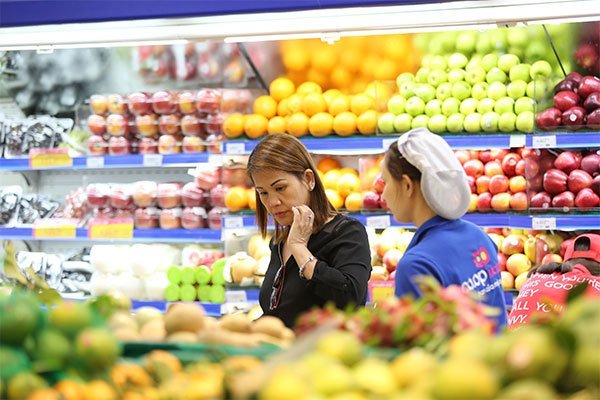 A shopper (L) inspects fruit at a Co.opmart supermarket in HCMC. Vietnam is the world’s fourth most optimistic country in the first quarter of this year Consumers in Southeast Asia remained relatively optimistic in January-March, with confidence increasing by two points from 119 in the fourth quarter of 2017 to 121 in the first quarter of this year, according to the latest issue of The Conference Board Global Consumer Confidence Survey, in collaboration with Nielsen, a global information and measurement company. The first-four survey shows that three out of six countries with the highest confidence scores were Vietnam, the Philippines and Indonesia. Notably, the Vietnam consumer confidence index gained an all-time high of 124 points. Emerging countries like Vietnam, Philippines and Malaysia registered annual average gross domestic product (GDP) growth of 5% to 7% in the final quarter of last year. Therefore, the good momentum of economic growth, coupled with the positive signals of foreign investment flows, increasing household income and growth-oriented government policies, could translate into consumer optimism, said Nguyen Huong Quynh, managing director of Nielsen Vietnam. “However, positive sentiment in Vietnam did not lead to strong fast-moving consumer goods (FMCG) sales, with the market up just 1.8% in quarter one. The growth was slower than expected and reflected the volatility of the FMCG industry, possibly due to changing consumer behaviors,” she said. Spending and saving at the same time Having covered essential living expenses, Vietnamese consumers were eager to spend on big-ticket items to enhance the quality of life. This desire had slowly grown in the last four quarters, according to the report. In particular, nearly half of consumers were willing to spend their spare cash buying new clothes (51%) and traveling (46%). Besides, around two in five spent on new technology products (46%), out of home entertainment (43%) and home improvements (42%). More importantly, spending on health insurance premiums surged a significant nine points at 38% in this quarter. However, Vietnamese consumers still had a strong affinity for saving. Close to three-fourths (73%) would put their spare cash into savings (compared to 72% in the previous quarter). The report also revealed that saving was an integral part of Southeast Asian consumers, with 67% of respondents putting their spare cash into savings. “While health insurance was once thought of as luxury years ago, Vietnamese consumers now start getting financial assistance to pay for health insurance programs,” said Quynh of Nielsen Vietnam. She added this trend reflected one of the changes in consumers’ mindsets. When consumers cover themselves with insurance plans, they could have a sense of protection. Having stable jobs and good health remain top concerns In the first quarter, the top five concerns of Vietnamese consumers remained the same as in the previous quarter. Job security continued to top the list of Vietnamese consumers’ key concerns (43%). The next key concern was health (41%), followed by work and life balance (23%), the economy (23%), and the parents’ welfare and happiness (16%). “In today’s world of information and technology, consumers are better informed as they can easily search for news and information. They can foresee some short-term challenges such as the current condition of the economy, job security, health and work-life balance,” said Quynh. She noted that these concerns may result in curbing their discretionary spending this year. SGT |
↧
Article 0
Social News 3/7 JICA helps improve water drainage system
Installing water drainage system in district 11 The Japan International Cooperation Agency (JICA) will give non-refundable aid to improve the existing water drainage system of Ho Chi Minh City, announced the City People's Committee office on June 30. Accordingly, JICA will provide US$17.5 million to upgrade the 2.7km-long degrade water drainage system in the heart of city, aiming to reduce pollution, depression, traffic jams and flooding. The total capital of the project costs US$20.6 million, including the reciprocal capital of US$3.1 million. The project is scheduled to be carried out from now until 2020. National Committee for e-government to be established The National Committee for e-government will be established and chaired by the Prime Minister, the Government Office announced at the conclusion of the meeting between PM Nguyen Xuan Phuc and Deputy PM Vu Duc Dam and members of the National Committee on IT application. The National Committee for e-government will be formed from the strengthening the National Committee on IT application to conduct the building of e-government system directly. PM also asked the ministries, departments and local authorities to provide online public services to better serve the people and businesses in the country and improve business environment for investment. Traffic restricted around Hòa Bình Hydropower Plant
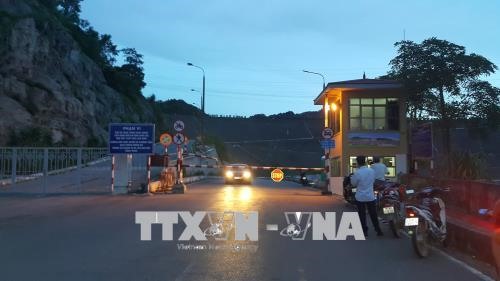 Hòa Bình Province People’s Committee has decided to restrict traffic running through Hòa Bình Hydropower Plant as of this month. Starting this month, Hòa Bình Road that runs through Hòa Bình hydropower plant in the northern province will be restricted to traffic. Only staff and special-use vehicles that serve the plant will be allowed to use the road, but only between 5.45-8.15 in the morning and 4.15-6.45 in the afternoon. Director of the plant, Nguyễn Văn Minh, said that the decision to restrict traffic was made after the plant was recognised as an important work relating to national security last year. However, he said that the plant managers would try to ensure convenience for people so that public vehicles could travel on Hòa Bình Road or visit the plant if needed. Local residents were disappointed with the decision as the area was a popular place for exercise because of its quiet surroundings and fresh air. The Hòa Bình Hydropower Plant, located in the northern province of Hòa Bình, is the second largest hydropower plant in Việt Nam, after the Sơn La Hydropower Plant, with an annual electricity output of over 10 billion kW/h. The plant has taken on several important tasks, including ensuring flood and drought prevention for the downstream area, providing electricity to the national grid and improving waterway transport, as well as ensuring local socio-economic development. It will be expanded in the future, with the installation of two more turbines that will raise total capacity from 1,920 MW to 2,400 MW by 2022, equivalent to the capacity of Sơn La Hydropower Plant, contributing to ensuring national energy security, Minh said. Fire breaks out at apartment block
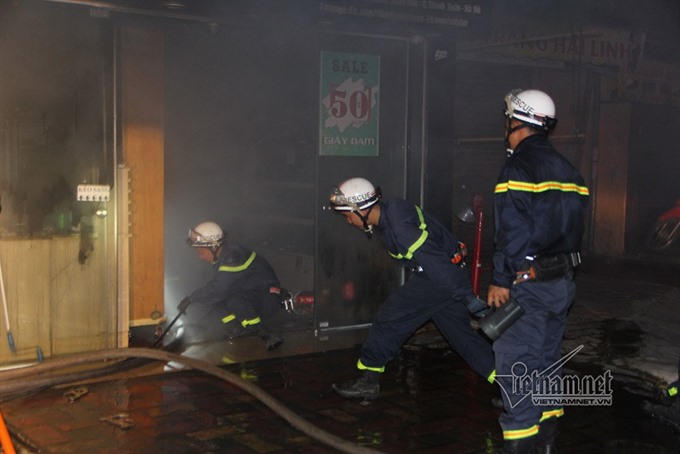 Firefighters attempt to enter the building in Hà Nội. — Photo vietnamnet.vn A fire broke out at 3am this morning at an apartment compound in Thanh Xuân District, Hà Nội, Vietnam News Agency reported. No casualties were reported. Reportedly starting in a footwear store, the fire spread to the 5-storey apartment blocks, trapping many residents inside. At least seven fire trucks and dozens of firefighters were deployed to the scene. Major Nguyễn Quang Huấn, Vice Chief of firefighting, prevention, and rescue team No 8 said, “The fire started on the first floor in a shoe storage room. We prioritised rescuing people from the second floor to the fifth.” Due to the narrow stairs and heavy smoke, rescue forces had to access the building through the balconies and used equipment to battle through the smoke. Approximately 20 people were guided to safety by the firefighters, and a further 20 had to be rescued from the fire. “At around 3am, I was watching football then heard someone shout that there was a fire. I woke up all five people in my family to escape. Due to the heavy smoke in the stairway, we had to escape through a balcony,” said Nguyễn Sĩ Tuấn, resident on the fourth floor of the building. Firefighters took 45 minutes to extinguish the blaze. Deputy Patriarch of VBS Patronage Council passes away
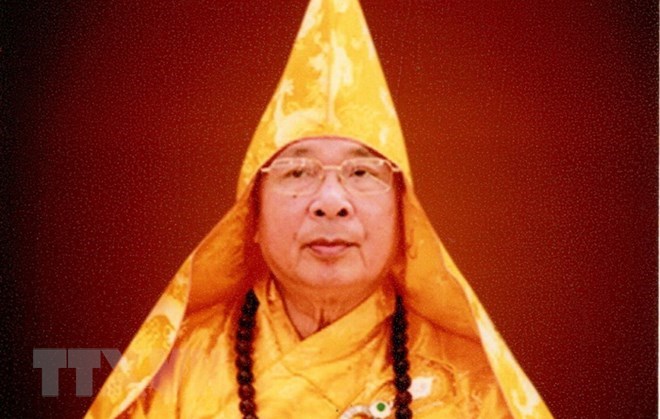 Most Venerable Thich Duc Phuong Most Venerable Thich Duc Phuong, Deputy Patriarch of the Vietnam Buddhist Sangha (VBS)’s Patronage Council, passed away on July 1 at the age of 85. According to the VBS’s Patronage and Executive Councils, the funeral is being held at Lam Son pagoda in Hue city of the central province of Thua Thien-Hue. The memorial service started from 7am of July 3 to the end of July 7, while the burial service will be organised on July 8. With his great contributions to the Buddhism and the nation, Most Venerable Thich Duc Phuong was honoured with noble awards by the Party, State and VBS, including the Independence Order, third class, and the Great National Unity Order. Quang Binh welcomes over 1.8 million tourists in first half of 2018
A new cave in Quang Binh The central province of Quang Binh welcomed over 1.8 million tourists in the first half of this year, up nearly 17 percent year-on-year. Foreign arrivals surged by more than 22 percent with nearly 90,000 visits. Since early 2018, Quang Binh has successfully held tourism promotion activities such as the Culture-Tourism Week in Dong Hoi city, the Hoang Phuc pagoda festival in Le Thuy district, the Phong Nha grass carp festival, the traditional boat race on Son River, and the Phong Nha-Ke Bang cuisine festival. The province also gave direction to upgrade hotels and restaurants, diversify tourism products and services, and open new tours. In order to expand the tourism connectivity network, the province signed tourism cooperation agreements with the Mekong Delta provinces of An Giang, Bac Lieu, Soc Trang, and Can Tho regarding the exchange of information and State management experience in tourism promotion. In the near future, Quang Binh will be calling on major prestigious partners at home and abroad to invest in tourism projects in its localities, offering incentives to investors in resort development. Along its coastal areas, Quang Binh has allocated over 1,000ha for tourism investors. An Giang finds remains of 116 fallen soldiers 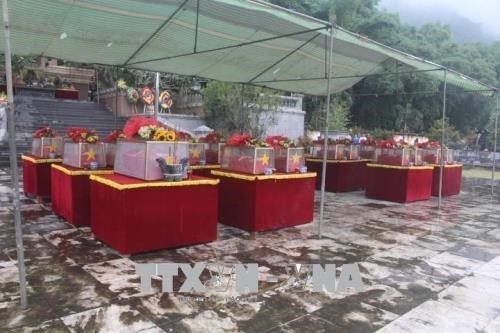 During the 2017-2018 dry season, the search team K93 of the An Giang Military High Command found the remains of 116 Vietnamese volunteer soldiers who laid down their lives during wartime. According to the head of the team, Colonel Pham Quang Trung, 78 of the total remains were discovered in Cambodia’s Kampong Speu and Takeo provinces, while the rest were found in Vietnam. Among the 38 remains recovered in Vietnam, two were identified. The team contacted the soldiers’ families so that they could be laid to rest in their hometowns. As planned, all the remains found in the 2017-2018 dry season by the K93 team and the K90 team of the Military Zone 9 will be reburied at the Doc Ba Dac Martyrs’ Cemetery in Tinh Bien district, in the Mekong Delta province of An Giang on July 20, on the occasion of the 71st Day of War Invalids and Martyrs. Vietnamese leader congratulates re-elected Turkish President President Tran Dai Quang sent a congratulatory message on July 2 to Recep Tayyip Erdogan on his re-election as President of Turkey. Vietnam and Turkey set up their diplomatic ties on June 7, 1978. Turkey is Vietnam’s leading trade partner in the Middle East. Their bilateral trade has increased over the years, exceeding 2 billion USD in 2017, of which 1.9 billion USD came solely from Vietnam’s exports. Turkey currently runs 16 investment projects in Vietnam with total registered capital of more than 1 billion USD. In June 2016, Turkish Airlines opened a flight route connecting Hanoi and Istanbul via Ho Chi Minh City with seven flights per week. Previously, the two countries had signed agreements on aviation, maritime transportation, and double tax avoidance. Summer football camp gives hope for young talents
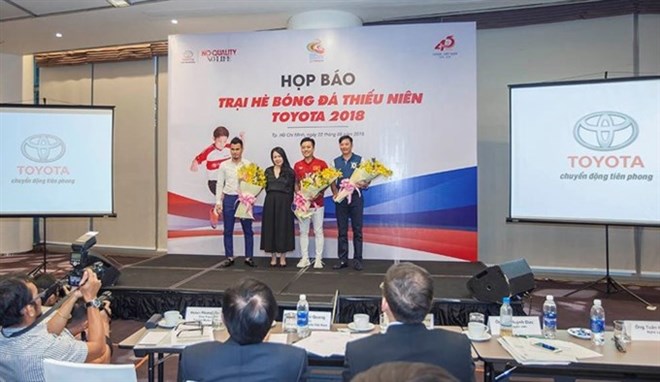 More than 3,860 children from around the country have taken part in selection for the Toyota Junior Football Programme 2018, with hopes of becoming the country’s next football stars (Photo: nghenhinvietnam) More than 3,860 children from around the country have taken part in selection for the Toyota Junior Football Programme 2018, with the hope of becoming the country’s next football stars. The programme covered three selection rounds in Ho Chi Minh City, Da Nang, Gia Lai and Hanoi. In the second round, 106 qualified players will join six-a-side group matches to show off their individual technique and logical thinking. Finally, 36 players will be selected for another six-a-side match. In this round, players have to demonstrate strong abilities in teamwork, aggression and intelligence to solve problems on the pitch. “I’m very satisfied with this year’s contestants as they have been trained carefully by the local centre. I also have a good feeling about the Vietnamese football movement because summer football camps like this will help find many more talented football players in the future,” coach Le Huynh Duc said about the quality of this year’s programme. After the four selection rounds, 30 of the top football talents will advance to the training camp at Ton Duc Thang University in Ho Chi Minh City from July 10 to 16. Finally, the best 18 players selected from the training camp will play a friendly match in Japan and join the Toyota international football league with Toyota teenage football teams from Japan and Thailand from September 13 to 20. The Toyota Junior Football Programme has been annually organised by Toyota Motor Vietnam (TMV) since 2015, for young football talents aged between 9 and 12, in the country. 2018 also marks 45 years in the relationship between Vietnam and Japan. Besides annual activities, TMV has been making efforts to become “a good citizen in the local community” through many social activities, focusing on traffic safety, education and training, environmental protection and culture. National programme adopted to support minority students
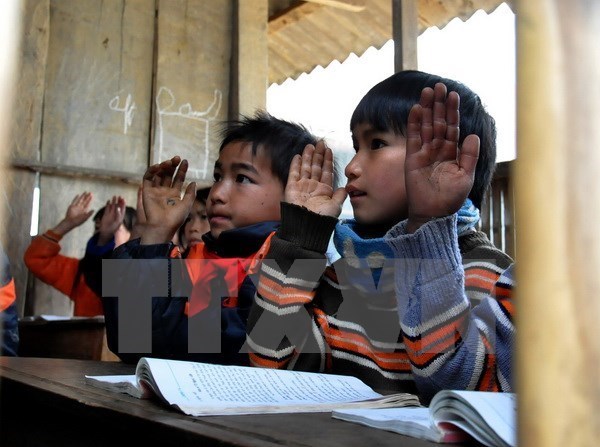 Prime Minister Nguyen Xuan Phuc approves a national target programme on education for ethnic minority, mountainous and disadvantaged areas across the country between 2016 and 2020. Illustrative image Prime Minister Nguyen Xuan Phuc has approved a national target programme on education for ethnic minority, mountainous and disadvantaged areas across the country between 2016 and 2020. The programme aims to provide financial support for the construction, expansion and renovation of boarding schools for ethnic minority students with total investment of more than 401.7 trillion VND (17.67 billion USD). The investment can be increased but should not exceed 1.1 trillion VND (48.4 million USD). It will also offer 4 trillion VND (176 million USD) in funds to repair, upgrade, expand and provide necessary facilities for 1,070 schools, including semi-boarding high schools for ethnic minority students as well as elementary and secondary schools with day boarders, in extremely difficult areas. These schools will get support to purchase basic teaching aids, classroom desks and chairs, equipment for catering services and residential houses for students.- Part of the sum will be used to purchase utensils and equipment for 1,045 canteens, kitchens and 1,045 dormitories at the targeted schools. Companies learn how to adopt zero-tolerance policy on wildlife crime
Staff from 30 Vietnamese and Germany companies met at a workshop last weekend in Hà Nội organised by TRAFFIC to learn the benefits of adopting a zero-tolerance policy on wildlife crime. Staff from 30 Vietnamese and Germany companies met at a workshop last weekend in Hà Nội organised by TRAFFIC to learn the benefits of adopting a zero-tolerance policy on wildlife crime. Taking a public stance against buying, gifting and consuming wild animals could make their companies more competitive, workshop leaders said. “Wildlife trafficking is transnational by nature and has repercussions that are felt worldwide. It is an issue that resonates with the German people and we are pleased with this opportunity for German and Vietnamese companies to join together and spread a united message against this crime,” said Katharina Trump, anti-poaching programme manager at the World Wide Fund for Nature (WWF)-Germany. During the workshop, participants learned how to enact a corporate social responsibility (CSR) policy to attract ecologically-minded clients, increase competitiveness, and mitigate potential risks. The workshop featured sessions on how to construct meaningful messages using CSR activities that could combat wildlife crime and lead to a change of practices among their colleagues and customers. Adopting these policies could strengthen the reputation of their businesses by ensuring they are not inadvertently participating in wildlife crime. “In this age of global integration, Vietnamese companies are expected to accept their stakeholder responsibilities and societal obligations along with their shareholder wealth-maximisation goals,” said Lương Tú Anh, managing director of Mắt Bão - Northern Area, one of the presenters at the workshop. The event was the latest in a series organised by TRAFFIC with different companies and civil society organisations, including the Việt Nam Chamber for Commerce and Industry (VCCI), Việt Nam E-Commerce Association, and Việt Nam Automobile Transportation Association. The aim is to work towards the eradication of animal trafficking by encouraging companies to take a strong position against wildlife crime. TRAFFIC’s efforts to encourage companies to integrate wildlife protection into their CSR activities have spanned the business, tourism and hospitality sectors. As a result, anti-trafficking messaging has been placed on buses, websites, at events, and on other platforms, reaching around 250,000 people. Following the workshop, companies were given CSR toolkits to help them develop an effective integrated CSR policy against wildlife crime. Bình Phước warns farmers not to grow uncertified cashew varieties 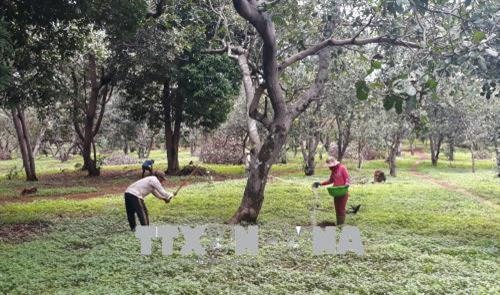 The Bình Phước Province Department of Agriculture and Rural Development has warned local farmers not to grow new cashew varieties that have not been certified by the Ministry of Agriculture and Rural Development to ensure cashew quality is not affected. Farmers in the country’s largest cashew growing province have begun to replant old cashew trees since the start of the rainy season in summer. They are planting varieties like AB29 and AB05-08 that have not been certified, saying they produce large nuts and more fruits than existing varieties when they begin to fruit after one year. The seedlings of the two varieties are in great demand now. But the department said the two varieties cannot match traditional ones for quality or flavour. Lê Thị Ánh Tuyết, deputy director of the department, said the department is monitoring the growth and disease situation of the two varieties grown on a trial basis by the Institute of Agriculture Science for Southern Việt Nam’s cashew research and development centre. It is also evaluating their quality for flavour and fat, she said. It has petitioned the ministry to instruct relevant authorities announce the research results soon, she said. The department encourages farmers to replace old cashew trees with certified varieties like PN1, MH54, ĐP41, and PN18, which are suitable for the province’s soil conditions. The south-eastern province needs to replant about 2,486ha this year, according to the department. Ethnic minority, poor, and near-poor farmers and those covered by the Government preferential policies, who are replacing their old cashew trees, are provided with subsidies for seedlings. Bù Đăng and Bù Gia Mập districts lead the province in the number of old cashew trees that need to be replanted this year -- 241,000 and 197,190. Cashew farmers have suffered from poor harvests in recent years because the weather has been inclement and their trees are too old. Dương Văn Phong, who has a 4ha orchard in Bù Gia Mập District, said he suffered a loss of about VNĐ15 million (US$660) this year after having a poor harvest. Disease outbreaks had caused yields to decline for the last three years, he added. The province plans to replant 25,000ha of cashew trees and plant more than 41,000ha anew under the intensive farming model by 2020. The cost of replanting is around VNĐ20 million ($880) per hectare while new trees cost VNĐ10 million ($440) per hectare, according to the department. Cashew is the province’s key industrial crop and has helped people in ethnic communities and rural, mountainous and border areas to escape poverty. Bình Phước’s cashew has been given geographical indication (GI) certification by the National Office of Intellectual Property. The province has 134,170ha under cashew, or nearly 50 per cent of the country’s total area under the nut, and produces 150,000 tonnes a year. Cancer can be controlled: experts
 The development of new generation sequencing along with artificial intelligence help doctors quickly identify the best drugs for their patients, said doctor Phan Minh Liêm.— Photo ungthuvietnam.com The development of new generation sequencing along with artificial intelligence help doctors quickly identify the best drugs for their patients, said doctor Phan Minh Liêm. Addressing at workshop on next-generation sequencing and genomics in cancer precision medicine and screening held in the central province of Khánh Hòa yesterday, Liêm said with these technologies, genetic experts can analyse genomes, detect genetic mutations that increase the risk of cancer and provide appropriate cancer prevention counselling. According to Liêm - who has been honoured four times by MD Anderson Cancer Centre in the United States, cancer is a deadly disease in Việt Nam. The treatment of diseases in Việt Nam is still limited as it based on monitoring the effects of drugs, but if detected early, cancer can be controlled, he said. “The results of 20,000 gene sequencings provide important information about genetic mutations. The analysis of the genetic code will help medical specialists choose the right treatment, especially for cancer,” said Yun Yu, from MD Anderson Cancer Centre. According to the Ministry of Health, more than 150,000 new cancer cases are detected yearly in Việt Nam. Of these, nearly 90,000 resulted in deaths, mainly due to late detection. Việt Nam is among the countries with the highest rates of cancer mortality in the world at 74.8 per cent. Cancer is a dangerous disease and claims the lives of more than 8 million people a year. Liêm said that the number of people suffering from the disease could be cut if cancer screening technology was used well. On this occasion, a Việt Nam-US Biomedical Institute was launched yesterday in Nha Trang City. The institute will be the place for patients to receive information, counselling support and help finding the optimal drug for treatment from specialists at the MD Anderson Cancer Centre, the American Society for Clinical Pathology and the American College of Medical Genetics and Genomics. According to Trần Đình Thiên, Director of the Vietnam Institute of Economics, the opening of the institute is a breakthrough, allowing Việt Nam to use the world’s advanced medical treatment. It would help Vietnamese access cancer screening technology without having to visit Japan and Singapore as before, he said. Thiên said that successful transfer of technology for early detection and treatment of cancer at the Việt Nam-US Biomedical Institute demonstrates that the Vietnamese medical sector is fully capable of receiving the world’s advanced solutions, opening up opportunities for the best screening, treatment and lowest possible costs for patients in Việt Nam. HCMC to make efforts in addressing urban flooding
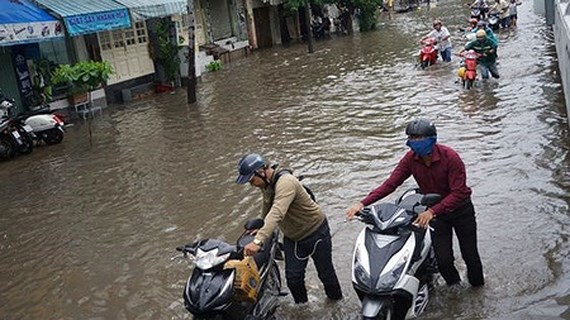 The basic cause of urban flooding in HCMC is the unsuccessful sewage treatment Ho Chi Minh City (HCMC) People’s Council Chairwoman Nguyen Thi Quyet Tam announced at the forum ‘Urban Flooding in HCMC – Reasons & Solutions’ yesterday that the flooding situation in the city has become worse and worse, creating much concern among city dwellers. According to Mr. Nguyen Hoang Anh Dung, Deputy Director of the Steering Center of the Urban Flood Control Program HCMC, recently, his center has focused on addressing urban flooding in the downtown basin and a part of the five urban basins in an area of 550km2, accommodating around 6.5 million citizens. His staff has also tried to improve the water environment, increase the space of water reservoirs, and create attractive cityscapes in order to develop living standards and protect the environment. At the moment, 22/37 hotspots of urban flooding have already been tackled (accounting for 59.46 percent) and the other 15 routes are now being dealt with. It is expected that in 2020, all tasks will be completed. When explaining for the fact that many streets are flooded whenever it rains, Mr. Dung shared that the drainage system of the city is quite small, while littering is still a serious problem, all of which have impeded the sewage flow. In addition, there are many cases of illegal land encroachment near the opening of the drainage system, yet no actions have been made to address that. Sharing his feeling in the event, Mr. Ngo Chi Hung, a worker of the HCMC Urban Drainage Co. Ltd., expressed how upset he was when people in many construction sites, restaurants, or food shops thoughtlessly throw litter into the drainage system. Much of this litter is fat substance, which easily impedes the water flow, let alone other dangerous kinds like waste, injection needles, broken bottles, knives that can harm sanitation workers. His hope is that people have higher awareness and stop littering public space and drainage systems. That will also prevent occupational accidents among sanitation workers. Expressing her apology to these workers on behalf of the municipal authorities, Ms. Nguyen Thi Quyet Tam promised to focus more on the task of raising people’s awareness of this issue. Vice Chairman of the HCMC People’s Committee Tran Vinh Tuyen welcomed all suggestions of citizens to tackle urban flooding and admitted that this is a very challenging problem, caused basically by the unsuccessful sewage treatment in the city. Furthermore, the drainage planning of the city has become so outdated, along with the ineffective management. The city, therefore, is going to focus on urgent tasks first while socializing projects to fight against urban flooding, hoping to have many breakthroughs in the future. Simultaneously, the local authorities will be stricter in addressing illegal land encroachments to clear the openings of the drainage systems. Meanwhile, the evaluation on previous actions, which cost dearly yet delivered very poor results, must be done to pinpoint weaknesses and correct them. All must be done to ensure quick sewage draining. Concluding the forum, Ms. Nguyen Thi Quyet Tam insisted that the fight against urban flooding is one of the critical tasks of the city to boost the economic and social development and to answer the urgent request of city dwellers. VNN |
↧
Article 4
BUSINESS IN BRIEF 4/7 Vietnam Airlines adopts QR Pay Vietnam Airlines has signed a deal with Việt Nam Payment Solution Joint Stock Company (VNPAY) – the biggest QR code payment firm in Viet Nam, to apply QR code technology for online ticket bookings. With the deal, Vietnam Airlines becomes a pioneer in Việt Nam’s aviation sector by using QR codes for online ticket booking at :vietnamairlines.com Customers will have a new, safer and more convenient way to pay for their flights. Accordingly, QR Pay will be implemented both online and at Vietnam Airlines’ official ticket office system nationwide from the beginning of this month. After successfully booking their tickets, customers will be able to use the QR code to pay without entering bank account of card information. The QR Pay system ensures safety thanks to two-factor verification including mobile banking sign in and one-time pass (OTP) through SMS or fingerprint verification. Payments via smartphones have risen in the last couple of years, thanks to the introduction of QR code technology. The function is already in use by many banks. Vietnam Airlines has taken advantage of the technology to co-operate with VNPAY and meet customers’ demands while ensuring security as part of the Fourth Industrial Revolution. Việt Nam’s aviation sector is one of the top 5 rapidly growing markets. With huge potential, airlines have been improving their services and prices to bring the best experiences to customers with the help of digital technologies. Like banks, local airlines have adopted fintech to catch up with trends worldwide. A representative of Vietnam Airlines said the mobile payment trend in general and QR codes in particular have become more convenient and popular in Việt Nam. Vietnam Airlines’ application of QR Pay is an effort to bring even better services to customers. There are 12 taxi and bus firms with more than 4,000 vehicles and over 20,000 payment points integrated with QR Pay. QR Pay is available with the mobile apps of many big banks in Việt Nam, such as Vietcombank, VietinBank, Agribank, BIDV, ABBANK, SCB, NCB, IVB, MaritimeBank, SHB and VIB, with more than 8 million users. Trade openness grows with sub-contracting Vietnam’s wider trade openness than other regional countries simply reflects the sub-contracting nature of the domestic economy. In other words, it does not mean the country has a higher level of global economic integration and trade liberalization. Opinions have recently surfaced about Vietnam’s very high degree of trade openness, and the country is even among the economies with the highest degree of trade openness in the world. But this also means the country may be more vulnerable to external economic changes. The important question regarding this issue is whether or not this high degree of trade openness results from Vietnam’s trade policy and it needs policy revision, especially amid the global trade war, mainly the ongoing U.S.-China trade friction together with its unpredictable risks. It is first necessary to differentiate between trade openness and trade liberalization of an economy. Trade openness denotes the relative scale of foreign trade in an economy, measured in total import-export value against the Gross Domestic Product (GDP). Meanwhile trade liberalization reflects factors obstructive to cross-border commodity trade of a country, such as taxes, import and export quotas, and technical barriers. With the total import-export value/GDP at 185% as per the 2016 data, Vietnam ranks third in Asia and eighth in the world in trade openness. However, the country has low ranking in trade liberalization. According to the ranking by the World Economic Forum in 2016, Vietnam is ranked 73rd out of 136 countries in the trade promotion index, much lower than regional competitors like Malaysia (37th), China (61st), Thailand (63rd). Vietnam ranks even below Indonesia (70th). High import tariffs and complicated procedures are two of the biggest trade barriers of Vietnam in comparison with other regional countries. It may come as a surprise for many people that the openness of an economy is not entirely related to the free trade policy of a country, but is dependent more on the structural factors of that economy. First, countries with bigger economies have lower openness, as they can produce almost every item and commercial relations take place mainly within their economies. For instance, according to the 2016 figures, the three biggest economies in the world, namely the U.S., China and Japan, have low degrees of trade openness, at 27%, 37% and 31%, respectively. On the contrary, countries with small economies like Vietnam have higher degrees of trade openness. Second, developing economies with low per capita income tend to have high degrees of trade openness. In developed countries, the service sector has the largest share in the GDP and is impacted little by international trade relations. Meanwhile, in developing countries, the agriculture and industry sectors, which are greatly impacted by international trade relations, have large shares in the GDP. These countries also have a relatively large non-official economic sector, so the total import-export value/GDP is generally overstated. In the ASEAN (Association of Southeast Asian Nations), Vietnam and Cambodia have higher degrees of trade openness, at 185% and 127% respectively, compared with more developed economies like Thailand (123%), the Philippines (65%) and Indonesia (37%). Third, trade openness is particularly high for countries which are regional trade transit hubs like Hong Kong and Singapore, or sub-contracting economies like Vietnam. These three economies rank first in Asia in trade openness and their foreign trade values are double counted, both in imports and exports. In sum, Vietnam’s trade openness is essentially the result of structural factors reflective of the development level of the economy; it is not a policy option that Vietnam can easily change and revise over the short-term. The free trade policy is only one of the factors that affect trade openness of an economy. In the case of Vietnam, the higher degree of trade openness versus other regional countries simply reflects the sub-contracting nature of the domestic economy, and does not means that Vietnam has a higher level of global economic integration and trade liberalization. The degree of trade openness may decrease when Vietnam can gain a higher position in the global production chain and have a larger service sector thanks to higher per capita income. Countries with high degrees of trade openness are generally affected more when the global market jitters and are more negatively impacted by global economic shocks. However, for sub-contracting economies like Vietnam, the impact may not be too big as reflected by the degree of trade openness. Economic shocks, once materialized, would affect directly and the most strongly to the foreign direct investment (FDI) sector. However this sector currently does not have close relations with the domestic sector. Trade openness is widely used partly because it is highly summarized and easily calculated with available data, but it is not a complete benchmark to reflect the severity of external shocks on the economy. It does not tell many factors like the essence of trade relations, competitors, the nature of imports and exports and the diversification of trade partners. To put it differently, Vietnam’s trade openness is very high versus other regional countries, but this does not means the country is more impacted by global trade jitters. Jasan Vietnam Textile and Dyeing Company, efficient FDI enterprise in Hai Phong 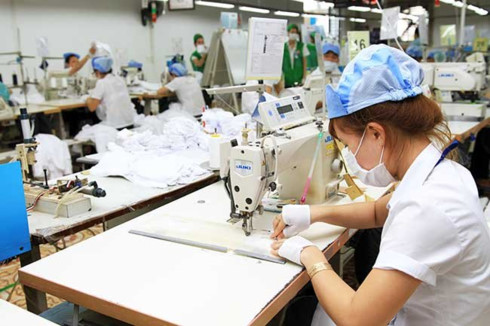 Established in 2014 at the Vietnam Singapore Industrial Park (VSIP) in Hai Phong, Jasan Vietnam Textile and Dyeing Company has gained remarkable achievements in production and trading. This proves the attractive investment environment of Hai Phong City. Jasan Vietnam Textile and Dyeing Company is a subsidiary of the Jasan Group in Hangzhou, China. The group chose Hai Phong as the base to expand its market because of its convenient transportation system, a seaport, and policies to support investors. Tran Thuy Trang, Deputy Director of Jasan Vietnam Textile and Dyeing Company, said, “We invested in Hai Phong due to its preferential policies for FDI enterprises: we are exempted from corporate income tax for the first four years. In the next nine years, we will receive half of the tax reduction. All employees in the company are entitled to personal income tax deductions. In addition, Hai Phong is a very convenient place for export activities.” Initially, Jasan Vietnam Textile and Dyeing Company rented only three hectares and invested US$14 million in VSIP. The improved investment environment, the company has expanded its scale of production by an additional 7 hectares with a total investment capital of US$50 million. All of the information regarding investment licensing procedures has been posted on the city's portal. All investor queries are addressed within a day to make sure Jasan and other foreign investors feel satisfied. Trang noted “Another advantage is that we are very satisfied with employees, ranging from highly skilled workers to blue-collar workers. They all have good sense of working hard.” Currently, Jasan Vietnam employs 1,500 workers. It plans to double that number by the end of 2018. The company has a good remuneration policy for employees according to their performance, a special welfare program for female workers, organizes free annual travel activities, and offers bonuses during holidays and gifts for workers. Pham Thi Kim Hue in charge of the garment workshop 2 said, “Over the past three years, I have been promoted from team leader to head of a group. With a good remuneration package and a convenient working environment, I am happy to work for the company.” Jasan Vietnam now has more than 1,500 workers and 40 foreign experts. Many important positions in the company are held by Vietnamese people. The company has increased their recruitment of qualified Vietnamese laborers and conducted a transfer of dyeing techniques to their Vietnamese employees. Currently, the most important section of the company is the technical section where 12 of the total 21 workers are Vietnamese. It is expected that by the end of this year, the company will reduce the maximum number of foreign managers and experts while making full use of the Vietnamese labour pool in all production stages of the company. Jasan is the only company to have a closed production line from dyeing to export. Jasan 1 was put into operation in 2015. Two year later, Jasan 2 was set up, and Jasan 3 will likely come into operation by the end of this year. With their 2000 looms, 2015 was the first year when Jasan began to produce and export 20 million pairs of socks. It is expected to produce 120 million pairs of socks by 2020. According to Trang, Jasan will certainly expand and aims to raise the current investment value from about US$50 million to US$120 million in the coming years. Hoang Anh Gia Lai bets on banana, Chinese market in agriculture switch Once a leading property developer, Hoang Anh Gia Lai has reinvented itself as a hi-tech agriculture giant. About a decade ago, Hoang Anh Gia Lai (HAGL) was a leading property developer in Vietnam. Today, it is more known for its agricultural prowess. Agriculture is now everything to HAGL, chairman Doan Nguyen Duc told shareholders at the group’s general meeting last week. Under a major restructuring effort launched in 2010, the group invested heavily in rubber plantations and livestock farming. Five years later, the rubber arm was renamed HAGL Agricultural Joint Stock Company (HoSE: HNG), and it started growing fruit in 2016. After two years, Duc has identified banana as a strategic fruit thanks to its high economic efficiency and huge demand from China. There is some doubt among shareholders about his betting on the Chinese market, with many cases recorded of Vietnamese farm produce being stuck at the Vietnam-China border or even being sent back. Duc, however, is confident that there will always be demand in the market of more than one billion people. “From market research, I’ve seen that the whole world wants to tap into China’s one billion people market. I had no worries after learning that we could not meet their massive demand,” he said, adding that it was not just HAGL, but suppliers from the Philippines and South America who have being selling bananas to China. Still, the demand has not been met. Duc said the group estimates China’s banana consumption at 15 million tons per year, while its annual banana export is no more than 240,000 tons. However, to reduce excessive reliance on the Chinese market, Duc is seeking to have about 20 percent of the group’s banana exports shifted to the Republic of Korea and Japan. The business tycoon reassured investors about the economic feasibility of his plan, saying the cost of production is only VND8,000 (US$0.35) per kilogram, but the company sells it for VND14,000-VND23,000 (US$0.6-1), depending on the season. Banana prices reach their peak between September and February or March as it corresponds to the winter in China. Duc seeks to expand the group’s banana plantations to 10,000 ha as it is now one of his core businesses. Its agricultural unit HNG grew 1,500 ha of banana last year and targets another 4,000ha this year. It expects to harvest 106,200 tons of banana in 2018, which will yield around VND1.7 trillion in revenue and VND983 billion in gross profit. Besides, it also looks to earn billions from dragon fruit and chili. HNG, which owns 13,000ha of orchards, posted VND1.64 trillion in revenue from its fruit sector last year for a gross profit of VND893 billion, a margin of 54%. HAGL has set an annual revenue target of VND3.7 trillion for HNG this year, more than 80% of it coming from selling fruit for a gross profit of nearly VND1.7 trillion. Supermarkets free from mandatory holiday, sales schedules The Ministry of Industry and Trade has stopped drafting a decree that would have required supermarkets to remain open through holidays and have at least three annual promotions a year. Trade Minister Tran Tuan Anh signed the order suspending the controversial decree’s drafting process, saying it was not practical, given “current market needs and management practices.” Supermarkets will no longer have to open from 10 a.m. to 10 p.m. during holidays and hold a minimum of three promotional events per year. The decree’s provisions were severely criticized by experts as well as industry insiders who said the state should leave the day-to-day running of a business to businesses. The Vietnam Chamber of Commerce and Industry said the decree interfered too deeply in the operations of businesses, and violated the Supermarket Investment Law, that allowed businesses to operate freely in compliance with relevant laws. The Vietnam Retailers Association objected to the proposed regulations saying they would not be practical for all businesses, and some would not be able to comply because of the type of products they dealt with. Other provisions of the proposed decree were also deemed impractical and restrictive, including one that set space specificatoins to categorize businesses. It said supermarkets should have an area of 250 square meters or more, while trade centers had to have more than 10,000 square meters each. China reduces imports of Vietnam’s cassava Although exports of cassava and cassava products saw strong growth over the first five months of this year, exports to China dropped 25.4% to just 1.1 million tons, according to the General Department of Vietnam Customs. Vietnam shipped 223,400 tons of cassava and cassava products worth US$100.1 million in May, bringing the total export amount for the five months to 1.3 million tons valued at US$468.1 million, down 23.6% in volume but up 10.1% in value against the same period last year. The increase in export value was attributed to the 44.4% rise in export prices, hitting US$356.9 per ton. China was the largest consumer of Vietnamese cassava products, buying up 88.5% of the country’s total exports with 1.1 million tons worth US$408.2 million, down 25.4% in volume but up 8.7% in value. The Republic of Korea came second with 43,400 tons valued at US$11.7 million, up 7.9% in volume and 30% in value, followed by the Philippines (18,900 tons), Malaysia (18,800 tons), Taiwan (17,300 tons) and Japan (10,100 tons). Over the five-month period, the Philippines witnessed the sharpest decrease, dropping 40.4% in volume and 15.7% in value. Meanwhile Japan was the highest growth market, ballooning 3.8 times in volume and 2.6 times in value. Russia becomes Vietnam’s top wheat supplier Russia has become Vietnam’s top wheat supplier, selling 1.7 million metric tons of wheat to Vietnam between July 2017 and April 2018. The Bloomberg news agency reported that Russia has benefited from lower production costs and a good harvest, while another report by the United States Department of Agriculture noted that Australia, which has been exporting wheat to Vietnam for years, was hit by a drought that saw its export of the grain drop by a third in 2017-2018 season. Tom Basnett, manager at Market Check marketing company in Australia, told Bloomberg that Australia typically exported 10% of its wheat to Vietnam, but the country has been loosing market share in recent years to wheat from Russia. However, Russian traders are worried that Vietnam could stop importing their wheat after weed seeds were spotted in shipment. Specialists were sent to Vietnam to discuss the issue. According to a report by the UkrAgroConsult Agency, besides Vietnam, Russia has also increased its share of the world market by supplying wheat to the Republic of Korea, Kenya, Peru, Philippines, Malaysia and several other countries. Japanese business builds packaging factory in HCM City United Packaging Co.,Ltd from Japan has broken ground on the building site for a new 5ha manufacturing facility at Tan Phu Trung Industrial Zone (IZ) in Cu Chi district, Ho Chi Minh City with a total investment of more than US$15 million. The company is owned by Oji Holdings Corporation, one of Japan’s leading paper and packaging groups. They chose to locate the factory at Tan Phu Trung IZ due to favourable geographic and planning conditions with the aim of implementing a strategy of expanding investment, diversifying and improving the quality of products to meet increasing market demand, and to sharpen their competitive edge. The factory is expected to come into operation by May 2019. Tan Phu Trung IZ has drawn more than 80 investors and many factories have been established in the IZ. A representative of the IZ says its managing board have always facilitated investors and created the best possible conditions for their production, bringing them long-term sustainable value. KPMG and LIN reach three-year CSR partnership LIN Center for Community Development (LIN) and KPMG Vietnam signed a Partnership Agreement for a three-year strategic corporate social responsibility program called “Partnership for a Vibrant Vietnam” at the conference “How Doing Good is Good for Business 2018” in HCM City on June 28. Under the agreement, LIN will work with KPMG to enable KPMG employees to engage in CSR programs, gain fresh perspectives, improve leadership skills, and get involved in professional and legal work for the public good through pro bono. Within three years, KPMG and LIN aim to empower their staff and non-profit organization communities for cross-sectored collaboration toward sustainable socio-economic development, and support businesses in dealing with social and environmental issues. The conference “How Doing Good is Good for Business 2018” was jointly held by LIN, the Canadian Chamber of Commerce in Vietnam and the French Chamber of Commerce in Vietnam at the Park Hyatt Saigon. The event was attended by more than 270 guests who are senior leaders, marketing and HR managers, CSR executives of multinational corporations, and representatives of non-profit organizations and small and medium enterprises wanting to optimize their CSR tools as a strategy to grow their businesses, or looking for innovative models and win-win approaches. Focusing on “Business Impact and Community Impact – Where to Meet?”, the conference discussed and showcased models of creating shared value (CSV) and CSR that build value and sustainable impact, encourage and enable businesses to continue to grow sustainably, create and continue positive social and environmental impacts, and strengthen partnerships with key stakeholders. Cashew nut exports up 17% in first half of 2018 Vietnam exported around 33,000 tons of cashew nuts worth US$300 million in June, bringing the total volume of shipments during the first half of this year to 176,000 tons, valued at US$1.41 billion, up 17% in both volume and value, according to the Ministry of Agriculture and Rural Development (MARD). The US, the Netherlands and China remained the three largest importers of Vietnamese cashew nuts with market shares of 37.9%, 13.1% and 10.9%, respectively. In the opposite direction, Vietnam imported around 151,540 tons of raw cashew nuts worth US$304.4 million in June, bringing the total amount of imports in six months to US$1.14 billion, down 13% over the same period of last year. This month’s price of cashew nuts in the world market was quite stable as there were no fluctuations in demand. The average export price of Vietnamese cashew nuts reached US$9,068 per ton in June, down 3.6% compared to May. The MARD’s Agro Processing and Market Development Authority (AgroTrade) forecast that export markets will be favourable in the coming time as importers accelerate their purchases to serve increasing year-end demands. In the context of the downward trend in the price of cashew nuts, the Authority also advised domestic businesses to reduce processing capacity, link with farmers to develop high quality material zones and focus on intensive processing to improve the value of products. Stricter controls needed to combat counterfeit goods Businesses need to devise effective security measures which will protect intellectual property, business tactics, customers’ information and distribution system, emphasizes Associate Prof. Dr. Nguyen Quoc Thinh from the Vietnam University of Commerce. The rampage of fake and counterfeit goods in the domestic market has raised major public concern in spite of relevant agencies’ great control efforts. Some businesses deceptively sell fake goods for illicit earnings while genuine businesses which refuse to deal in counterfeit products are often failing to cooperate with law enforcement agencies in the fight against bogus goods. According to a survey of 100 fine arts and handicraft businesses conducted by the Vietnam University of Commerce, 90% of businesses are afraid of their products being faked for the market, while up to 70% of them are willing to replicate the product designs of other businesses. Another survey, which covered 350 businesses operating in multiple fields in Hanoi, Thai Nguyen and Thanh Hoa, showed that only 208 of those businesses thought it worth their effort to pay special attention to brand protection. However, just 18 out of those 208 businesses have registered trademarks, patents or other intellectual property rights (IPR) to be concerned with. One out of the 18 businesses has registered for industrial designs while the remaining 17 businesses have signed up for brands. Quoc Thinh says that any type of product can now be faked in a sophisticated manner, adding that counterfeit goods are publicly circulated on the market, making it difficult for law enforcement agencies to identify suspect products “Consumers are confused about fake and unfaked goods. Even the trademark owners find it difficult to distinguish between their products and fakes,” says Mr Thinh. Mr Thinh points out that there has been a strong increase in the number of counterfeit foods and IP violations. Up to 98.37% of violations get administrative fines while only 1.63% of prosecuted cases were settled in court. Mr Thinh attributed the flood of fake goods onto the market to the lack of duly punishments and an imperfect legal framework. Most trademark violations were punished with fines of just VND20-30 million, which is minute compared to the huge profits from selling counterfeit goods, he noted. Sharing the same viewpoint, Mr Nguyen Vu Quan,of the Vietnam Industrial Property Association (VIPA), says administrative punishments on IT infringements are mostly used as the procedure for dealing with these cases to save costs and reach a swift conclusion. But these remedies are not strong enough to resolve cases of IPR violations. In addition, the penalties for violations often depends on the different assessment results of the Vietnam Intellectual Property Research Institute or VIPA, which can lead to difficulties for law enforcement agencies. According to Dr. Vo Tri Thanh, director of the Institute for Trademark and Competition Research Strategies, the efforts to fight fake goods and protect intellectual property are not simply related to real or counterfeit goods but also pertain to business methods, competition, creativity, consumer trust and the prestige of Vietnamese businesses. To prevent the prevalence of fake goods and the infringement of brands, Associate Prof. Dr Nguyen Quoc Thinh insists there is a need to change the thinking behind management and law enforcement agencies, and in the business community. Mr Thinh notes that businesses need to establish their IPR by registering trademarks or industrial designs patents. Nearly 90% of surveyed businesses have yet to devise protective measures and have no recognized intellectual property, he adds. The story of fake goods remains a thorny issue if there are loopholes in management agencies, organizations and associations which have been tasked with preventing fake goods but aid and abet fraudulent trade activities. Many experts suggests severe punishments should be imposed on the manufacture and trade of counterfeit goods but harsher punishments are needed for those aiding and abetting businesses in faking goods, so that businesses can regain the trust consumers. Tech can improve competitiveness of Vietnam’s corn Over the last five years, the high demand in the Vietnamese corn sector combined with the limited available land and the continuous increases in imported corn volume – the imported corn volume is 1.3 times higher than the local corn volume – force Vietnamese farmers and the local corn sector to apply science and technological solutions to increase their capacity. Corn is one of Vietnam’s most important crops. In the period 1995-2010, Vietnam saw an increase in corn production quantity thanks to expansions of the cultivation area and a higher capacity of the corn seeds. However, over the past five years, Vietnam spent massive amounts of money importing corn seeds to serve the local animal feed processing industry. Notably, in 2016, Vietnam’s corn import turnover reached $1.65 billion, equalling 75 per cent of the country’s rice exports. In the first four months of this year, the imported corn volume increased in terms of quality and value, while the price of imported corn seeds has been continuously increasing, creating disadvantages for the local agricultural sector in general and the corn sector in particular. Vietnam reached a breakthrough in corn production with an increase from 1.1 million tonnes in 1995 to 4.6 million tonnes in 2010, with the government’s approval to use a new generation of corn seeds and to expand the cultivation area considered key factors for the development. In order to achieve another revolution in the corn sector as well as meet the target to increase corn production by 40 per cent against the backdrop of climate change and limited available land, Vietnamese farmers need new support policies in order to be able to approach the issue with international standards of technology. Helping farmers to acquire new corn seeds to increase their capacity and to improve the quality of the corn, ultimately resulting in a greater capacity and value of their products, is considered an important step. One of the technologies chosen by more than 18 million farmers across the world over the past two decades in order to produce high-quality commercial seeds is pest-resistant and herbicide-resistant technology. With this technology, the plant is protected from damage caused by insects and weeds as well as from fumomisin – the carcinogenic toxin produced by the mold caused by insect pests. This helps to maximise productivity as well as quality. This technology started to be applied in Vietnam in 2015 and has brought significant benefits so far. Aruna Rachakonda, CEO of Dekalb Vietnam stated, “During its 20 years of accompanying farmers, Dekalb Vietnam has always been striving to bring technology solutions to help Vietnamese farmers increase the quantity and quality of their crops. Dekalb Vietnam’s corn hybrids helped Vietnamese farmers in numerous regions increase corn yield by 40 per cent compared to local corn seeds.” In 2015, Dekalb Vietnam introduced insect-resistant and herbicide-tolerant corn seeds to farmers for the first time. After two years, farmers reported that the quantity of corn increased by 20 per cent, resulting in a 20-30-per-cent increase in income. In 2017, the income from all fields applying the pest- and herbicide-resistant corn seeds saw signs of increase. Notably, farmers reported a 20-per-cent increase in capacity and a 20-30-per-cent increase in economic gains. Better corn grain quality, reducing the risk of aflatoxin contamination arising from pest bites, is one of the key elements of this technology to help farmers increase their competitiveness with imported products, which are produced with similar technology. After receiving the new corn seeds, almost all farmers were satisfied with their bumper crops. According to Nguyen Van Dang, a farmer in the Mekong Delta province of An Giang, the new corn seeds created higher profit than the previously used ones. “I spent VND700,000 ($30.9) more on the new corn seeds from Dekalb Vietnam and earned VND3.5 million ($154.52) more in profits – five times the investment cost. Along with the increase in profits, I saved a lot of time on weeding and costs to spray pesticide, thanks to the new variety DK6919S,” Dang stated. “We are very excited about the results of the application of new corn varieties,” said Tran Quang, a farmer in the southern province of Dong Nai, who is also chairman of the Xuan Tien Corn Co-operative. “The area in the co-operative reaches 150 hectares. All 125 members of the co-operative have chosen to cultivate the new corn hybrid DK6919S, since it helps us to save costs and labour and improves our profits. The average yield of the dried seeds is 10 tonnes per hectare – double the national average.” Masan Consumer and Jinju Ham form strategic partnership Saigon Nutri-food JSC, a wholly owned subsidiary of Masan Consumer Corporation - one of Vietnam’s largest branded food and beverage companies, has just formed a strategic partnership with Jinju Ham Limited, a leading Korean branded processed meat company. This was announced today by Masan Consumer, a subsidiary of Masan Group - one of Vietnam’s largest private sector companies. Accordingly, Jinju Ham has acquired a 25 per cent stake in Saigon Nutri-food JSC (SNF) via a primary issuance. The entity will be renamed Masan Jinju. The strategic partnership will create significant synergies that will ultimately benefit Vietnamese consumers: combining Jinju Ham’s cutting-edge know-how with Masan’s deep understanding of Vietnamese consumers and brand building capabilities. “Our aim is to improve Vietnamese consumer’s meat experience by providing innovating and delicious products. We will not only develop products that are delicious, but will focus on nutrition and affordability,” said Truong Cong Thang, chairman and CEO of Masan Consumer. “This partnership aligns with our mission to enhance the daily physical and spiritual lives of 90 million Vietnamese consumers. I look forward to partnering with Jinju to transform the processed meat segment and deliver on our mission in the near future,” Thang added. In the words of Park Jungjin, CEO of Jinju Ham, Vietnam’s processed meat market has the same dynamics as Korea and China 20 years ago. This segment is in an early phase of development, contributing less than 1 per cent to the overall meat market. “We believe that synergizing our respective platforms will enable Masan-Jinju to drive the process meat contribution to 20-50 per cent over the long-term, similar to China and Korea today, respectively. Our objective is to be at the forefront of this transformation and build a championship position over the course of the next five years,” said Jungjin. New innovations under this strategic partnership are expected to launch in the second half of 2018. Jinju Ham, established in 1963, is the oldest sausage producer in South Korea with market leading positions in the sausage and home meal replacement segments. The company has over 30 years of experience in the processed meat market and has developed best-in-class R&D and technological know-how. Masan Consumer boasts its market leadership in large consumer categories such as seasonings, convenience food, and beverages. Masan Consumer’s portfolio includes some of Vietnam’s most trusted and loved brands such as Chin-su, Nam Ngu, Tam Thai Tu, Omachi, Kokomi, Heo Cao Boi, Vinacafé, Wake-Up, Vinh Hao, and Quang Hanh. PVIRe taking the initiative on the reinsurance market Vietnam’s reinsurance market is witnessing stiff competition between two local players, the Vietnam National Reinsurance Corporation, which came into being in 1994, and PVIRe, a pillar of leading financial insurance institution PVI Holdings. Figures released by the Ministry of Finance’s Insurance Supervisory Authority showed that last year, Vietnam’s non-life insurance market’s size reached $2 billion and insurance premium value jumped by 12 per cent on-year to reach VND43.6 trillion ($1.94 billion). Non-life insurers retained 68 per cent of insurance premium value, whereas the remaining 32 per cent was ceded to reinsurers to transfer risks, helping to shape a secondary market barely known to the Vietnamese public, the reinsurance market. Worldwide, this market is the playing field of long-standing financial institutions with a value reaching several hundred billion dollars, such as Swiss Re, Munich Re or legendary billionaire Warren Buffett’s Berkshire Hathaway Group, which boasts the second-largest revenue in the US. In Vietnam, the reinsurance market’s size reached VND13.07 trillion ($596.8 million) last year, up 9.1 per cent on-year, but 72 per cent of the market share was in the hands of foreign reinsurers, while the remainder was shared by Vietnam National Reinsurance Corporation (Vinare) and PVIRe. Vinare is the more well known brand of the two, as the company made its debut on the Vietnamese stock market in 2006. The stock’s trading liquidity remains low however, as the state shareholder State Capital Investment Corporation (SCCI), foreign shareholder Swiss Re, and other corporate shareholders hold nearly 96 per cent of the company’s circulating stock volume. Meanwhile, comparatively juvenile PVIRe, which is also smaller in capital size, has been developing vigorously, leveraging the brand value and advantages of parent company PVI Holdings. After three years of operations, PVIRe reached premium revenue from reinsurance services surpassing VND1.6 trillion ($71 million) in 2014, almost equal to that of Vinare. In the past three years, PVIRe has adjusted company’s underwriting guidelines from top to bottom lines. Therefore, despite a slight fall in reinsurance premium revenue to about VND1.3 trillion ($57.7 million) a year, its efficiency has been stable. Of particular interest is PVIRe’s combined ratio, which averaged 80-82 per cent, the best level in Vietnam’s insurance market and much lower than the world’s average combined ratio of 95 per cent. After seven years, PVIRe has built a solid foundation for development. Its corporate governance complies with the new model outlined in the new Law on Enterprises, with one independent member of board of directors. The company boasts strong human resources, consisting of experienced managers and staff members. Its strong information technology system provides the key to ensure efficient operations in a sector where success often leverages statistical database. PVIRe’s recent annual general shareholder meeting (AGM) approved a rise in the company’s 2017 dividend payout ratio from 14 per cent, a target set early in the year, to 16 per cent in cash. This is also the third consecutive year PVIRe paid shareholders more than 14 per cent, the top level in the insurance industry. The AGM also passed 2018 business plans with the target for reinsurance premiums set at VND1.21 trillion ($53.7 million) and the goal for the payout ratio set at 14 per cent in cash. The AGM also elected the board of directors for the period 2018-2023, boasting well-known faces of the Vietnamese insurance market - including Nguyen Anh Tuan, chairman of PVI Holdings; board chairman Pham Khac Dung, former board chairman of life insurer PVI Sunlife (now Sunlife); and Duong Thanh Danh Francois, Asia Australia director of HDI Global. As the company’s return-on-equity (ROE) ratio hovered around 14-16 per cent over the past three years, the new board of directors has committed to keep the ROE ratio at no less than 14 per cent a year in the new tenure. To keep abreast of burgeoning development requirements, PVIRe is set to raise its charter capital, find strategic partners, and make its debut on the stock market. The new board of directors expects the new plan to help PVIRe boost its capacity on the domestic market, expand its share in regional markets, and make avail of PVI’s system strength, laying the initial stepping stones to grow PVIRe into a leading reinsurer on the Vietnamese market and a prestigious player on the regional market. Samsung wins EPC contract for Long Son Petrochemical complex Samsung Engineering Co., Ltd. has released that it won an engineering, procurement, and construction (EPC) contract worth $536.7 million for Long Son Petrochemical Complex (LSPC) located in Long Son commune of Ba Ria-Vung Tau province, according to newswire Business Korea. Notably, on June 28, Samsung Engineering and Thai investor SCG signed an EPC contract to develop Package B worth $304.14 million and Package C worth $250.46 million for two plants to be built in LSPC. According to the plan, the Package B plant has a designed capacity of 450,000 tonnes of high density polyethylene (HDPE) and the Package C plant was designed with the capacity of 400,000 tonnes of polypropylene (PP) per year. Previously, in early February, two South Korean contractors signed a $2.7 billion deal for Long Son complex. Notably, SK E&C announced that it will co-operate with Technip of France to develop an ethylene plant project with the total investment capital of $2 billion ($1 billion from each). The ethylene plant is one of the segmented parts of the project, including a polypropylene and a polyethylene plant. SK E&C will build the ethylene plant and other utility facilities. The construction will be implemented in the form of a turnkey system, including basic design, detailed design, purchasing, construction, and test runs. The construction will last for 53 months. On the same day, POSCO E&C announced signing a contract with Vietnam Long Son Petrochemical (LSP), a joint venture of SCG and PetroVietnam, for the construction of a wharf facility worth $680 million in Ho Chi Minh City to serve the Long Son complex. Previously, in October 2017, Hyundai Engineering and Construction Company (HEC) won a $320 million contract to build facilities at LSPC. The project would be carried out on a turnkey basis, meaning HEC would be responsible for the entire construction, from design to test operations. The company estimates construction will take 47 months after ground is broken. Back to LSPC, in February, Vietnam Long Son Petrochemical (LSP) officially kicked off its long-awaited LSPC after more than ten years of development. In late May, SCG reached an agreement to buy PetroVietnam's 29 per cent in the LSPC, leaving it king of the hill. This step once more confirms SCG's determination to implement the petrochemical complex that was delayed for more than 10 years. LSPC is located in Long Son commune of Ba Ria-Vung Tau province, 100 kilometres from Ho Chi Minh City. This integrated petrochemical complex will have a total olefin production capacity of 1.6 million tonnes per year. The complex is designed to produce various petrochemical products, including essential plastic materials such as polyethylene, polypropylene, and other products in excess of two million tonnes per year, enabling it to substitute imported polyolefin products. Non-petrochemical supporting infrastructure, such as a deep sea port and other facilities, are also included. Vietjet Air: 700,000 cheap tickets to mark launch of HN-Osaka services Budget carrier Vietjet Air is offering 700,000 tickets at prices starting from just 0 VND, excluding taxes and fees, to celebrate the launch of a direct route between Hanoi and Osaka, Japan. The promotional tickets are available on the airline’s official website: www.vietjetair.com from July 4 – 6. The special offers are applicable to all domestic fights and international services to Osaka; Seoul, Busan and Daegu (the Republic of Korea); Hong Kong (China); Kaohsiung, Taipei, Taizhong and Tainan (Taiwan, China); Singapore; Bangkok, Phuket and Chiang Mai (Thailand); Kuala Lumpur (Malaysia); Yangon (Myanmar); and Phnom Penh and Siem Reap (Cambodia) for travel between August 14 and December 31 (excluding holidays). They are also subject to flights between Nha Trang and Siem Reap from September 21 and between Hanoi and Osaka from November 8. The daily two-way Hanoi – Osaka services will be provided from November 8, taking more than four hours per leg. Departures from Hanoi will be at 1.40am and arrivals in Osaka at 7.50am (local time). The return flight will be at 9.20am and 1.05pm, respectively, all local time. Last month, the airline made its debut flight from Hanoi to Taichung (Taiwan). The new route operates five flights per week on Monday, Wednesday, Friday, Saturday, and Sunday, with each leg taking 2 hours and 30 minutes. Aiming to become a “Consumer Airline,” Vietjet Air is continually opening new routes, adding more aircraft to its fleet, investing in modern technology and offering more added-on products and services. With a fleet of over 60 aircraft, including the A320 and A321, Vietjet Air operates 385 flights each day. The airline has already transported over 60 million passengers on a network featuring 93 routes in Vietnam and across the region to international destinations such as Thailand, Singapore, the Republic of Korea, China’s Taiwan and Hong Kong, mainland China, Malaysia, Indonesia, Myanmar and Cambodia. The carrier plans to operate more than 120,000 flights and serve over 24.1 million passengers by the end of 2018 on a total of 39 domestic and 61 international routes. VNN |
↧
Article 3
Government News 4/7 NA Vice Chairman meets voters in Lao Cai province
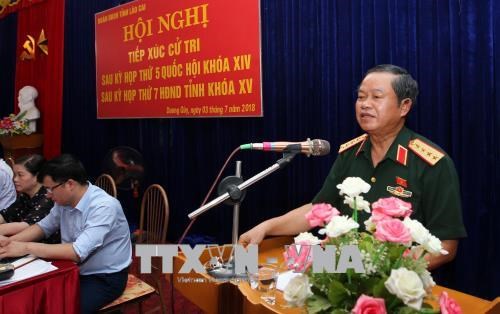 NA Vice Chairman Do Ba Ty Vice Chairman of the National Assembly (NA) Do Ba Ty on July 3 met voters in Duong Quy commune, Van Ban district, the northern province of Lao Cai, the hardest-hit locality in the recent floods. On June 24 and 25, floods severely damaged houses, transport infrastructure, and irrigation systems, inundating hundreds of hectares of rice and vegetables in Duong Quy, Hoa Mac, Minh Luong, and Nam Xe communes. Ty stressed that Van Ban district is highly prone to sudden floods due to its sloping terrain, and as such local residents should stay alert to disasters to mitigate human and material losses. He also underscored the role of village chiefs in preventing and controlling floods. As well as comments regarding basic construction, administrative reform, and policies, voters in Van Ban district asked the legislature and the Government to deal with issues regarding mineral mining and transport infrastructure. The Vice Chairman asked the provincial NA deputy delegation and all-level People’s Councils to further enhance their supervisory role and requested that constituents’ opinions be transferred to those authorities concerned for consideration. Ty lauded Van Ban district’s authorities for their reception of local citizens and prompt settlement of arising issues. La Xuan Tham, Secretary of the Duong Quy Commune Party Committee, suggested that the legislature and the Government should utilise 20-30 percent of mineral sale revenues each year to invest in infrastructure and welfare works in the locality. Constituents urged the Government to allocate funding for the repair and upgrading of national highway 279, especially from the IC 16 section of the Noi Bai-Lao Cai highway to Van Ban town. They asked the State to clarify the responsibility of individuals and units concerned for the lifespan of works which have suffered rapid downgrades or extend their warranty to prevent wastefulness and embezzlement. The same day, Ty visited and presented gifts to the family of veteran La Van An, who was affected by the floods. Soc Trang province urged to apply advanced technology by officials
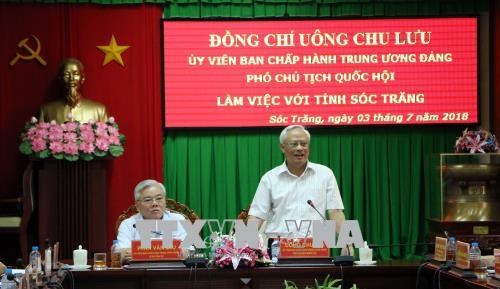 Vice Chairman of the National Assembly Uong Chu Luu at the working session in Soc Trang province. The Mekong Delta province of Soc Trang should strive further to apply advanced technology so as to promote safe agricultural production and enhance farm produce exports, said Vice Chairman of the National Assembly Uong Chu Luu. At a working session on July 3 with local authorities on the province’s socio-economic development in the first half of this year, Luu recommended the province call for investments for advanced and environmentally-friendly technologies to create high value products, and highlighted some specific measures to develop local tourism alongside preserving traditional values. Comprehensive solutions to preventing deterioration in political ideology, morality, and lifestyle must be carried out, he stressed, urging the province to effectively implement the Party Central Committee’s resolutions on apparatus rearrangement to ensure a streamlined and efficient system. According to Chairman of the provincial People’s Committee Tran Van Chuyen, local economic growth expanded 6.11 percent in the first half of the year. Total rice output was 1.3 million tonnes, with purchasing price higher than that in the same period last year. Local farmers gained big profits during the period thanks to a stable market and many Vietnamese Good Agricultural Practices (VietGAP) cultivation models. Chuyen said that the industrial production value picked up 6 percent year-on-year, spurred by a surge in the province’s key products. Among them, the value of garment production rose 59 percent, and those of bottled beer and frozen shrimp shot up 42 percent and 7.4 percent, respectively. During the January-June period, the province welcomed 60 big investors to seek investment opportunities, and there were 141 newly-established enterprises with a total registered capital of 1.2 trillion VND (51.6 million USD), increasing total operating businesses in the locality to 2,480. Regarding solutions to developing socio-economy for the remaining six months, Secretary of the provincial Party Committee Phan Van Sau said that the province will carry out a set of measures to shake up local agriculture alongside building new-style rural areas. Expanding local key areas which meet the market’s demands, responding to climate change, accelerating energy projects, developing processing technology, and implementing poverty alleviation activities will be taken as the top solution priorities. The same day, Luu visited the Republic of Korea-invested garment plant and Soc Trang Seafood JSC (STAPIMEX) at An Nghiep Industrial Park. He also visited and presented gifts to two policy beneficiary families in Phu Tam communes, Chau Thanh district. Vietnam, Laos look to settle free migration, undocumented marriages 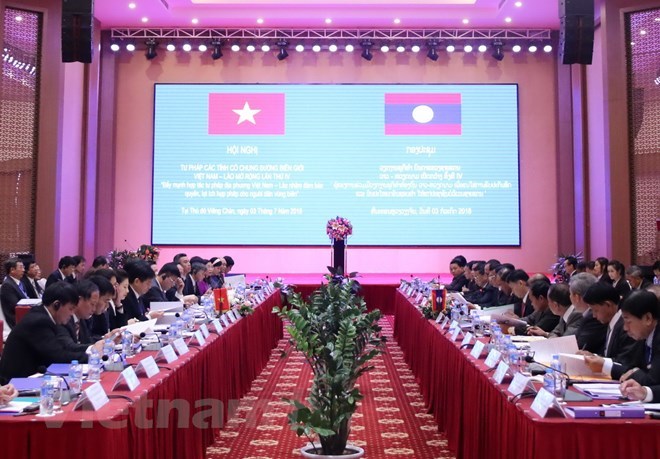 A conference to foster judicial cooperation between Vietnam and Laos to ensure legal rights and the interests of people living in the border region takes place in Vientiane on July 3. Authorities from the Vietnamese and Lao provinces along their shared border gathered in Vientiane on July 3 at a conference, seeking ways to foster judicial cooperation between the two sides to ensure legal rights and the interests of people living in the border region. The conference, the fourth of its kind, was chaired by Vietnamese Minister of Justice Le Thanh Long and his Lao counterpart Saysi Santivong, and attended by judicial officials from the two ministries as well as 16 Vietnamese and 18 Lao provinces. Since the last judicial conference, the management of household registers and citizenship-related issues in the provinces along the shared border has been strengthened with a number of encouraging results, as heard at the event. The two sides have both been actively working together to implement the 2013 Vietnam-Laos agreement in addressing free migration and undocumented marriages in their shared border areas while, at the same time, making many efforts in the enforcement of civil judgement. Vietnamese leaders congratulate US on Independence Day President Tran Dai Quang and Prime Minister Nguyen Xuan Phuc on July 3 transmitted a message of congratulations to President of the United States Donald Trump on the country’s 242nd Independence Day (July 4). On this occasion, Chairwoman of the National Assembly Nguyen Thi Kim Ngan also extended congratulations to President of the US Senate Michael Pence and Speaker of the US House of Representatives Paul Ryan. Deputy Prime Minister and Minister of Foreign Affairs Pham Binh Minh also sent a congratulatory message to US Secretary of State Michael Pompeo. PM Nguyen Xuan Phuc asks for greater focus on building institutions
Prime Minister Nguyen Xuan Phuc speaks at the meeting Prime Minister Nguyen Xuan Phuc requested ministries, sectors and relevant agencies to pay more attention to building institutions while chairing the Government’s regular meeting in Hanoi on July 3. The Ministry of Justice delivered a report on the implementation of the Government’s programme on building laws and ordinances and the promulgation of documents stipulating the enforcement of laws and ordinances in the second quarter of 2018. Ministries are set to build and promulgate 151 documents, giving details on law and ordinance regulations in 2018, including 60 documents providing details of laws and ordinances that have come into force. As of June 30, the Government, along with the Prime Minister, ministries, and ministerial-level agencies promulgated 93 out of the 151 documents. Ministries were urged to proactively draft documents for the promulgation of the remaining documents. PM Nguyen Xuan Phuc mentioned some constructive recommendations and proposals of localities on institutions and policy mechanisms in the recent review conference on the country’s socio-economic performance in the first half of 2018. He asked the Minister-Chairman of the Government Office to quickly collect these opinions and reply them quickly to the localities. The PM requested the Ministry of Justice and the Government Office to conduct regular inspections on the implementation of the Government’s programme on building laws and ordinances. At the meeting, the Government also considered the proposal of building resolutions stipulating the management of sand and soil in river beds. Cabinet members also discussed a draft law on architecture and a draft resolution stipulating preferential treatment for Vietnamese who had participated in the resistance wars for national independence and doing international missions but now residing overseas. They also discussed a plan to allocate the remaining funds and address some of the bottlenecks in the transfer of regular expenses from the central budget in 2017. Vietnam, Israel to boost cooperation in fighting crime
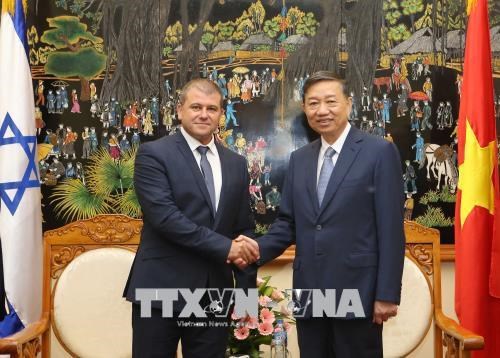 Vietnamese Minister of Public Security Sen. Lieut. Gen. To Lam (R) and his Israeli guest The Ministries of Public Security of Vietnam and Israel should increase the exchange of information and experience in preventing and combating crime, especially transnational crime, said Vietnamese Minister of Public Security Sen. Lieut. Gen. To Lam. While receiving Director General of the Israeli Ministry of Public Security Moshe Edri in Hanoi on July 3, Lam also suggested the two ministries expand cooperation in cyber security, firefighting, rescue activities, personnel training and science-technology. The minister said the Israeli delegation’s visit is of important significance as the two nations are celebrating the 25th founding anniversary of diplomatic ties (July 12). The visit is also a step to realize a cooperation agreement on preventing and fighting transnational crime signed between the two ministries in 2016, he added. Edri affirmed that he will continue try his best to promote the development of cooperative relations between Israel and Vietnam in general and between the two Ministries of Public Security in particular. Earlier on the same day, Vietnamese Deputy Minister of Public Security Sen. Lieut. Gen. Nguyen Van Thanh held talks with Director General of the Israeli Ministry of Public Security Moshe Edri. Trade unions asked to work for better livelihoods for labourers
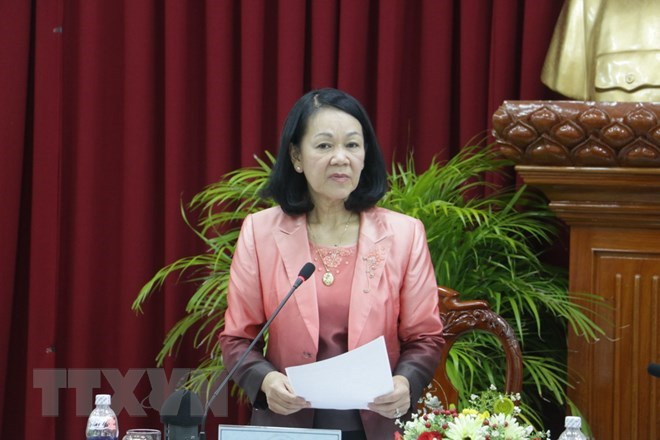 Truong Thi Mai – Politburo member, Secretary of the Party Central Committee and head of its Commission for Mass Mobilisation. Trade unions have been asked to focus their operations on ensuring the rights and legitimate interests, as well as sustainable employment and appropriate income of labourers. The statement was made by Truong Thi Mai – Politburo member, Secretary of the Party Central Committee and head of its Commission for Mass Mobilisation – at the 12th meeting of the Executive Committee of the Vietnam General Confederation of Labour (VGCL) in Hanoi on July 3. Mai spoke highly of the activities by trade unions to care for the life of labourers, especially those in remote areas and with low incomes. She recommended trade unions to get involved in addressing salary-related issues in a variety of ways. The VGCL was asked to pay attention to improving labourers’ skills; ensuring their safety at their workplace; addressing issues related to labour relationships; building a stable, harmonious and progressive labour relationship; and ensuring appropriate social welfare is in place. According to a report by the VGCL, since the beginning of this year, trade unions at all levels have signed 337 new agreements with their partners in providing products and services for trade unionists. As a result, over 1.2 million trade unionists have benefited from these agreements. The confederation has worked with the Ministry of Construction, the Ministry of Natural Resources and Environment, and localities in building trade union institutions. HCM City hopes for Japan’s support in high-tech agriculture
Secretary of Ho Chi Minh City’s Party Committee Nguyen Thien Nhan (R) and Special Advisor of the Japan-Vietnam Parliamentary Friendship Alliance, Tsutomu Takebe Secretary of Ho Chi Minh City’s Party Committee Nguyen Thien Nhan hosted a reception on July 3 for the Special Advisor of the Japan-Vietnam Parliamentary Friendship Alliance, Tsutomu Takebe, who affirmed Japan will support Vietnam in the fields it holds strength. According to Takebe, Vietnam is in the process of developing high-tech agriculture, in which Japan holds substantial experience. Japan is, therefore, willing to share its experience to support Vietnam in this field, he affirmed. Regarding preparations for the Japan-Vietnam Festival 2019, the Japanese official said this is an important cultural event held annually between the two countries, expressing Japan’s hope for continued assistance from and close cooperation with Vietnam, and Ho Chi Minh City in particular, to make the event a success. Affirming Japan’s role as one of Vietnam’s strategic partners, Nhan emphasised the two countries have cooperated effectively across numerous fields. To boost relations with Japan, one of Vietnam’s biggest economic partners, Ho Chi Minh City has sent many delegations to the country to learn from its experience, especially that in economic development based on science technology and urban management. Nhan expressed his hope that with its strength in high-tech agricultural development, Japan will continue to assist Vietnam, particularly Ho Chi Minh City. He affirmed that the city will work with the Japanese side to successfully organise the festival next year. Vietnam wants to boost multi-faceted cooperation with Panama: Party official
 Phan Dinh Trac, head of the Communist Party of Vietnam (CPV) Central Committee’s Commission for Internal Affairs and Panama President Juan Carlos Varela. Vietnam always wishes to enhance the friendship and multi-faceted cooperation with Panama, Phan Dinh Trac, head of the Communist Party of Vietnam (CPV) Central Committee’s Commission for Internal Affairs, affirmed during his visit to the Latin American country. Trac, who is also deputy head of the Central Steering Committee on Anti-Corruption, lead a Party delegation to visit Panama from June 30 to July 3. During his stay in Panama, the official met with President Juan Carlos Varela and Vice President and Foreign Minister Isabel Saint Malo, and held talks with President of the Panamenista Party (PAN) Jose Luis Varela and Secretary General of the Democratic Revolutionary Party (PRD) Pedro Miguel Gonzalez. He also had working sessions with representatives from several anti-corruption agencies of Panama. At these meetings, Trac briefed his hosts on Vietnam’s situation as well as achievements the country has recorded during the reform cause initiated and led by the CPV over the past 30 years. He reiterated Vietnam’s consistent foreign policy of independence, peace, cooperation and development; multilateralisation and diversification of international relations, being a friend and a reliable and responsible partner of the international community; and active integration into the world. The official thanked the Panamanian people for their solidarity and friendship towards Vietnamese people during the past struggle for national liberation and reunification and the present cause of national construction. He stressed that Panama is one of the first Latin American countries to back Vietnam’s bid to join the World Trade Organisation (WTO) and run for a non-permanent seat at the UN Security Council for 2008-2009, as well as to recognize the country’s market economy status. Panama also backs Vietnam’s membership in the Human Rights Council and the Economic and Social Council of the UN, he said. Trac spoke highly of the development of the relationship between Vietnam and Panama, as well as their close coordination and mutual support at many multilateral forums and international organisations. President Juan Carlos Varela and leaders of PAN and PRD expressed their special sentiments towards Vietnamese people, and their admiration for Vietnam’s struggle for national liberation and reunification. They said the Vietnamese Party delegation’s visit would help promote the fruitful relations between the CPV and political parties in Panama, and between the two countries’ States, Governments and people. Lauding Vietnam’s reform achievements, the Panamanian leaders proposed concrete measures to reinforce the bilateral ties, especially in economy, trade and investment, and cooperation with the CPV in the time ahead. The two sides agreed to intensify the exchange of all-level Party delegations, maintain bilateral consultation mechanisms, and join hands to seek ways to expand bilateral trade, and promote cultural and people-to-people exchanges. While in Panama, Trac also visited the staff of the Vietnamese Embassy in Panama. Key transport projects urged to be accelerated Leaders of the Government, ministries, sectors and localities have agreed on solutions to help the expansion of transport infrastructure keep up with socio-economic development pace in the time ahead. Speaking at the Cabinet’s teleconference with localities on July 2, Deputy Prime Minister Trinh Dinh Dung asked the Ministry of Transport (MoT) to press on with solving problems related to build-operate-transfer (BOT) projects. The Ministry of Planning and Investment needs to remove obstacles to projects using foreign loans like the urban railway project in Ho Chi Minh City. Meanwhile, the Ministry of Industry and Trade and the MoT have to speed up key transport projects and soon submit a prefeasibility study report on the North-South express railway, he said. Earlier, MoT Minister Nguyen Van The said his ministry will carry out many major projects in the time ahead, including the eastern North-South Expressway with 11 sub-projects and the My Thuan 2 Bridge. It is making a plan on the North-South express railway and will report this project to the National Assembly in 2019. He added that many localities want to upgrade their airports like Chu Lai in Quang Nam province and Cat Bi in Hai Phong city, but this issue needs time and close coordination with localities to seek the best plans. At the meeting, Deputy PM Dung also requested the Ministry of Construction and the Ministry of Agriculture and Rural Development to boost efforts to support people in the northern mountainous, central and Mekong Delta regions, recently hit by natural disasters and climate change. He underlined the need to develop social housing for low-income earners and workers in industrial zones, which hasn’t received enough attention in many localities. He noted that helping workers to have stable accommodation is critical to ensuring social security and development of industrial zones. VNN |
↧
↧
Article 2
Social News 4/7 Repair of burnt apartment block in HCMC expected to complete on August 15
The apartment block Carina On June 29, the Hung Thanh Trade - Service - Production - Construction Company (the owner of the burnt apartment block Carina) started repairing it after obtaining the license for repairing Carina Plaza (located in district 8, HCMC) that was burnt in a fire causing 13 people dead. The water and electricity items will be completed in 30 days and the fire protection system will be done in 45 days from the date of repairing, the Hung Thanh company spokesman said. On 15 August, the repair will be completed. After completion of the mending, the architect will be examined by the Ministry of Construction and residents will be permitted to accommodate. Previously, on June 28, the HCM City Department of Construction approved the Hung Thanh Company to repair Carina Plaza earlier than expected including the repairing and renovating the basement of towers A and B with an area of over 1,000m². Those working items also include the mending a number of damaged electrical items from the basement to the 2nd floor; replacement of equipment including electrical cabinets, control cabinets, cable trays, switchgear wires; water pipe system; security cameras ... and some other works. Relating the fire prevention system, the HCMC Department of Construction forced the Hung Thanh company to totally replace with new ones. Talking with SGGP Newspaper reporter on June 29, representative of the HCM City Department of Construction inspectorate said that in the process of repairing of Carina apartment, mobile inspection teams in the district will coordinate with local authorities to check, supervise the owner's process in accordance with the repair license. The work will be early completed to quickly bring people back, stabilizing their lives. Lai Chau: Thousands still isolated amidst food shortage in Muong Te
Roads to Pa Ve Su commune are still blocked by landslide debris. Nearly a week after the heavy floods and landslides that caused severe damage to the northern mountainous province of Lai Chau, thousands of households in Muong Te district are still isolated amidst a food shortage. According to the statistics, five communes with more than 50 hamlets in the district are still isolated. Despite the maximum forces and machinery being mobilised, most inter-communal roads and inter-village routes have not been cleared due to a large volume of landslide debris. Walking is the only mode to reach these communes, while essential goods’ prices are beginning to increase due to scarcity. It takes more than an hour to walk to Phi Chi A, the first hamlet in Pa Ve Su commune, which suffered the most during the incident. Although situated only about 20 km from the district’s centre, the hamlet has nearly 50 landslide areas, with a road completely damaged, cutting off the connection between the locale and the outside world. Due to the block, some essential commodities in the commune have started to become scarce with increased prices. According to Lo Xa Xe, a local shop owner, the price of each packet of install noodles or an egg has increased from VND500 to VND1,000 but he does not have enough goods to sell. Xe had to mobilise all of his seven family members and relatives to carry goods from outside through the landslide areas to the hamlet. They tried hard but only transported over a dozen packets of noodles, eggs, and some other essentials. The limited amount of goods can serve only part of the local need for just one or two days. Pan Phi Chong, Vice Chairman of Pa Ve Su commune, confirmed that, due to traffic congestion, goods storage in the commune has run out. Difficult transportation has laid a great negative impact on the lives of local people. Apart from the scarcity of goods, the damage caused by floods and landslides in other areas has also affected the lives of more than 600 households with about 2,000 people in the commune. Not only Pa Ve Su, other communes of Mu Ca, Thu Lung, Pa U and Ta Pa are also isolated. The transport has been paralysed, although Muong Te district has mobilised all means to remove the landslides and make temporary roads to facilitate people’s travel. The district’s working missions have been dispatched to isolated sites to support the victims. According to Mai Van Thach, Chairman of People's Committee of Muong Te district, the damage to local traffic is huge. In the immediate future, the district will focus on clearing the roads to the centres of such isolated communes. However, even in favourable weather conditions, it could take half a month to clear the roads leading to the aforementioned communes, Thach added. Thach also informed that, at the beginning of the rainy season, the district had inspected the hoarding of essential necessities in its communes and residential areas. In the immediate future, it will be possible to meet some of the needs of the local people; however, if the situation lasts longer, the essential goods will not be enough to serve them. Therefore, the local authorities are trying their best to solve the problems in the coming days, he affirmed. The recent flooding has claimed one live in Muong Te district, while leaving two others missing and three other injured. Dozens of households have been displaced, while many houses and roads have collapsed. Total losses are estimated at nearly VND40 billion. The recovery work is still being urgently implemented. In isolated localities, the districts are focusing on mobilising local people to help each other in overcoming difficulties, while directing the concerned forces to find any way possible to supply essential goods for the people in need. Statistics from the Steering Committees for Disaster Prevention and Control and Search and Rescue in localities in Lai Chau show that the whole province still has ten communes with over 100 hamlets and thousands of households still temporarily isolated due to floods. World Press Photo Exhibition in Hanoi 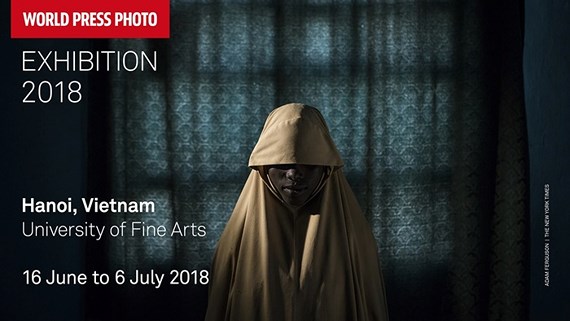 The World Press Photo Exhibition 2018 celebrating the 45th anniversary of diplomatic relations between Vietnam and the Netherlands opened at the Vietnam Fine Arts University in Hanoi. The exhibition displays pictures which were selected from 73,000 photos of 4,548 authors from 125 countries throughout the world of the 61st annual World Press Photo contest. The event will be organized in 90 cities worldwide, including Hanoi and is expected to attract more than 4 million visitors. The World Press Photo Foundation is a global platform connecting professional photographers and audiences through visual journalism and storytelling. It was founded in 1955 by a group of Dutch photographers to present their works to international viewers. The constest has now become the world’s most prestigious photography competition, attracting millions of people every year. The World Press Photo Foundation is a creative, independent, nonprofit organization, based in Amsterdam, the Netherlands.It receives support from the Dutch Postcode Lottery and is sponsored worldwide by Canon. The exhibition on its world-wide tour is held in Vietnam for the first time and will run until July 6. Danang expects high tourism growth in summer The central coastal city of Danang has seen robust growth in the tourism sector, thanks to scores of festivals taking place between May and September. Danang City recorded 1.6 million tourists over the past two months, surging by 26% year-on-year, said Tran Chi Cuong, deputy director of the Department of Tourism of Danang City. He attributed this to a series of festivals and activities, such as the Danang International Fireworks Festival and Danang-Summer Destination 2018 program. “The occupancy rate of hotels in the city was recorded at 70-90% during the festivals. Danang City, though, provided an additional 7,300 rooms to meet the tourist demand against the same period in 2017,” Cuong told The Saigon Times, adding that the city expected to welcome four million visitors during upcoming festivals, such as the Danang International Marathon. The latest statistics of the hotel booking website Agoda.com show that Danang tops the list of destinations booked by local tourists between June and August this year, followed by the cities of Bangkok, Singapore, Nha Trang and Hoi An. A source from the Danang Tourism Department noted it had worked with the municipal authority of Hoa Vang District and travel firms to promote and apply farming-tourism services in the district. In the initial period, some firms helped tourists visit Phong Nam Village in Hoa Chau Commune, Gian Bi Village in Hoa Bac Commune and Thai Lai Village in Hoa Nhon Commune. Currently, Danang has six organic paddy fields with a combined area of nearly 150 hectares and targets 500 hectares by 2020. Therefore, creating a range of agricultural ecotourism products will make the city more attractive. New editions of Chamber of Secrets released
 The paperback Hogwarts house-themed editions of Harry Potter and the Chamber of Secrets New editions of the second Harry Potter book, Chamber of Secrets, were released in Vietnam by the HCMC Book Distribution Corporation (Fahasa) late last week. The special Hogwarts house-themed editions were created by Bloomsbury Publishing to celebrate 20 years since the first publication of the book in the UK and some other countries (July 2, 1998). The covers were designed by illustrator Levi Pinfold, complete with new artwork, house colors, and additional illustrations and content. The books are available in both hardback and paperback, with four colors representing four Hogwarts houses: Gryffindor, Hufflepuff, Slytherin and Ravenclaw. As well as being house-themed, each cover has its own special array of symbols and details embedded within the main crest, so each house cover is unique. Both hardback and paperback editions come with fun features on the inside such as an illustration of the chosen house’s common room, a written introduction to that house, and a mini-feature on house-elves. A hardback book is priced at VND475,000 while the paperback edition costs VND250,000. Buyers who place an order on www.fahasa.com will be entitled to a 25% discount. Harry Potter and the Chamber of Secrets is the second novel in the Harry Potter series, written by British author J. K. Rowling. The plot follows Harry's second year at Hogwarts School of Witchcraft and Wizardry, during which a series of messages on the walls of the school's corridors warn that the "Chamber of Secrets" has been opened and that the "heir of Slytherin" would kill all students who do not come from all-magical families. These threats are found after attacks which leave residents of the school "petrified" (frozen like stone). Throughout the year, Harry and his friends Ron and Hermione investigate the attacks. Former BIDV chairman expelled from Party The former chairman of the Bank for Investment and Development of Vietnam (BIDV), Tran Bac Ha, has lost his membership of the Communist Party of Vietnam as he has been found responsible for lending irregularities. At a meeting held in Hanoi on June 27-28, the Party Central Committee’s Inspection Commission decided to remove Ha, 61, from the Party. He also served as secretary of the Party Committee of BIDV. Ha violated the principle of democratic centralism as well as working regulations, procedures and regulations on lending, financial guarantees, investment and debt management, according to a statement issued by the commission after its meeting. Ha was found to be involved in the process of approving loans totaling VND4.7 trillion (US$204.7 million) for 12 companies involved in a criminal case at the Vietnam Construction Bank. The commission also found Doan Anh Sang, former member of the standing board of the Party Committee and deputy general director of BIDV, and Tran Luc Lang, member of the standing board of the Party Committee and deputy general director of BIDV, accountable for the VND4.7 trillion loans. As a result, the 57-year-old Sang also lost all his Party posts while the 51-year-old Lang got an official warning. The commission said the State Bank of Vietnam (SBV) must also be responsible for BIDV’s lending violations and asked the SBV’s Party Committee to seriously practice criticism, draw lessons from these infringements, and discipline those responsible, promptly review, amend, and supplement banking regulations, and strengthen inspection and oversight of credit organizations. Le Nam Tra, former secretary of the Party Committee and former chairman of the State-owned MobiFone Telecommunications Corporation, was expelled from the Party for his serious violations in a now-cancelled deal in which the mobile carrier acquired a 95% stake in pay TV firm AVG, according to the statement of the Inspection Commission. The commission, whose 27th session was chaired by its head Tran Cam Tu in Hanoi, also dismissed Pham Dinh Trong, head of the Department of Corporate Management under the Ministry of Information and Communications (MIC), from the Party for his involvement in the deal. Cao Duy Hai, vice secretary of the Party Committee and general director at MobiFone, was dismissed from all his Party posts. Deputy Minister of Information and Communications Pham Hong Hai was reprimanded. MobiFone is a State-owned business under the MIC. The Inspection Commission also suggested the Party decide whether to discipline a former and a current leader of the MIC. They are Nguyen Bac Son, former Party Central Committee member and former Secretary of the Party Committee and former Minister at the MIC, and his successor Truong Minh Tuan, who are holding these three posts. Mobile carrier MobiFone and local pay TV operator AVG decided in March this year to call off the controversial deal in which the former acquired a 95% stake in the latter for VND8,889.8 billion (around US$387.3 million). The two sides agreed to cancel the stake acquisition contract on March 12. As of this May, AVG’s shareholders returned more than VND8.5 trillion to MobiFone to get back the 95% stake. After its 26th session from May 28 to 30, the Inspection Commission concluded that the Party Committee of the MIC had committed serious violations in the case. The 64-year-old Nguyen Bac Son must be held accountable for the violations and shortcomings of the Party Committee of the MIC in his 2011-2016 tenure, according to the commission. Meanwhile, the 57-year-old Truong Minh Tuan must also take responsibility for the violations and shortcomings of the Party Committee of the MIC in the 2011-2016 tenure in which he was serving as deputy minister. As secretary of the Party Committee and Minister of the MIC since April 2016, Tuan was mainly accountable for the violations and shortcomings of the Party Committee in the 2016-2021 tenure. The 58-year-old Pham Hong Hai was also responsible for the committee’s violations during the 2011-2016 and 2016-2021 tenures. Besides, the 48-year-old Pham Dinh Trong was found to have committed a slew of serious violations while advising the ministry’s leaders on the project. The 57-year-old Le Nam Tra was mainly responsible for submitting a decision to the ministry to seek approval for the project, and directly signing many relevant documents in violation of the prevailing regulations. Cao Duy Hai aged 57 also committed serious violations as he advised the council to submit a draft decision to the ministry on project approval and execution, and signed many relevant documents against the regulation. The Inspection Commission also concluded that the Ministries of Planning-Investment, Finance, and Public Security, the Government Office, and the People’s Committee of Binh Duong Province were also accountable for the case. Pawning can be a gamble Many pawn shops in Hà Nội are operating around the clock during the World Cup to serve customers who have lost money betting on football. "Last weekend, at 6am, a 40-year-old man riding on motorbike came to the shop and pulled out his wife’s degree from his pocket with his identity card, trying to pawn it. But I refused,” Kiên, owner of a pawn shop in Đặng Dung Street said. He explained that he couldn’t use the degree as collateral. Another story involving football betting was told by police of Bình Tân District, HCM City. On June 27, police arrested Nguyễn Minh Hồ, 38, living at An Giang Province on suspicion of the theft of State property. Hồ was suspected of stealing an ambulance from the Triều An Hospital parking lot, and was later found and arrested. He said from the beginning of the World Cup, he had lost VNĐ100 million. He slept in a pagoda and then went to the hospital for free food to save money for bets. One day, on the way to back home to An Giang Province, he went to Triều An Hospital for food. He found the ambulance there with the key in the ignition. When he was driving on the HCM City-Trung Lương Expressway, toll station staff reported him to local police, probably because he looked nothing like a medical worker. Thang Long Warriors beat Saigon Heat at VBA
 Defending champions Thang Long Warriors vs Saigon Heat at the VBA League on July 1. — VBA Photo Defending champions Thang Long Warriors came from behind to beat Saigon Heat 69-57 in the Việt Nam Basketball Association (VBA) League on Sunday. Despite playing away at the raucous Hà Nội University of Education gymnasium, the Heat started strong, opening up a 15-9 lead in the first quarter, thanks to eight points from Trần Đăng Khoa and Dư Minh An with five. The home team battled back however, with Predrag Lukic’s charges cutting the lead to 27-26 going into the half. Hồng Gia Lân and Tim Waale helped the Heat open up a lead in the next period at 44-36 with under a minute to go. However, Jaywuan Hill and Tô Quang Trung poured in six points in only 58 seconds, helping the capital side pull within two points at 44-42. In the last quarter, the visitors faded, while the Warriors’ only grew in strength, scoring 27 in the last 10 minutes to secure a nice 69-57 victory. American Hill was the MVP of the game, with 22 points, 14 rebounds and three assists. In other games, led by Tâm Đinh, De Angelo Hamilton and Nguyễn Phú Hoàng, Cantho Catfish crushed HCM City Wings 104-77 at Hồ Xuân Hương Gymnasium in HCM City. The Heat will next face Danang Dragons on July 3, while the Warriors will face the Catfish on July 5. Coach Em bids farewell to Sài Gòn FC
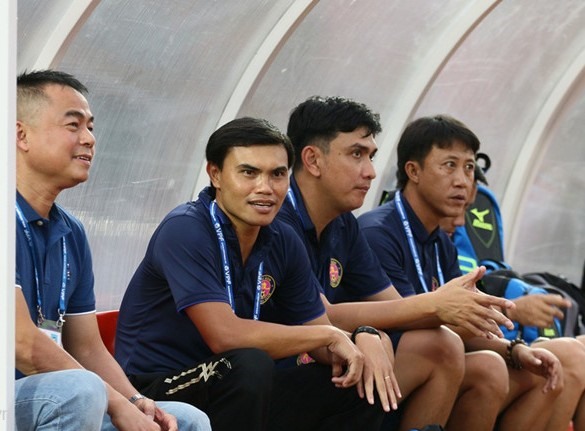 Coach Phan Văn Tài Em (second, left). — Photo zing.vn Phan Văn Tài Em has resigned as coach of V.League 1’s side Sài Gòn FC following poor results of the team in the league. Em is the second coach to quit during the event. Earlier, Thanh Hóa club’s coach Marian Mihailalso left after four rounds. Under the guidance of Em since early this year, Sài Gòn FC have had three wins, four draws and 10 losses to rank at the bottom of the score chart, with only 13 points after 16 rounds. “Sài Gòn have not had satisfactory results, so I want to give up this position to another person. I think I do not have much experience in the national premiere league. I hope the club will perform better in the other games to prevent disqualification,” Em said. Assistant coach Nguyễn Thành Công will temporarily replace Em to lead the team in the match with Nam Định for the 17th round this Sunday. Em is a retired Vietnamese footballer who last played as midfielder for ĐồngTâm Long An. He is a former member of the national football team and was awarded the Vietnamese Golden Ball in 2005. VTF Junior Tour in Tây Ninh
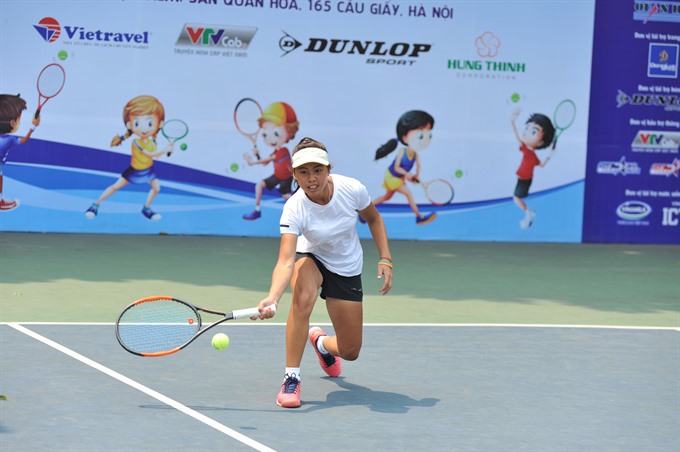 Nguyễn Thị Phương will compete for the Hà Nội team in the VTF Junior Tour. — Photo courtesy of organisers The Việt Nam Tennis Federation (VTF) Junior Tour, the Hải Đăng Cup, began in the southern province of Tây Ninh on Thursday. The event drew the participation of 235 players from 23 teams nationwide, including Đồng Nai, Sơn La, Sóc Trăng, Thái Nguyên, Becamex Bình Dương and Bạc Liêu. Participants will compete in the men’s and women’s singles and doubles categories in different age groups. Winners will walk away with cash bonuses and points for their national ranking. The finals are scheduled to take place on July 6. Vietnamese, German businesses commit to fight wildlife crimes Representatives of 40 Vietnamese and German companies in Viet Nam pledged to adopt a zero-tolerance policy towards wildlife crimes at a workshop here today. They agreed to take a public stand against the buying, gifting and consumption of wild animals and pass on the message to their clients and staff throughout their companies. The event, organised by TRAFFIC with funding from WWF-Germany and Intelligentmedia behavioural change communication company, aims to encourage the business community to step forward to handle social and environmental issues. “Wildlife trafficking is transnational by nature and bears repercussions that are felt worldwide. It is an issue that resonates with the German people, and we are pleased with this opportunity for German and Vietnamese companies to come together and spread a united message against this crime,” said Katharina Trump, programme manager, anti-poaching, WWF-Germany. Through the workshop, participants were given an opportunity to learn how to enact a corporate social responsibility (CSR) policy to attract environment-conscious clients, increase competitiveness and mitigate potential risks. The workshop featured sessions on how companies could construct meaningful messaging to incorporate CSR activities that would be effective in combatting wildlife crimes and lead to a change of practices among their colleagues and customers. Participants learnt that adopting these policies could strengthen the reputation of their businesses by ensuring they were not inadvertently participating in wildlife crime. The event is the latest in a series of activities organised by TRAFFIC with different companies and civil society organisations, such as Vietnam Chamber for Commerce and Industry, Vietnam E-Commerce Association and the Vietnam Automobile Transportation Association, which work towards the eradication of animal trafficking by encouraging companies to take a strong stand against wildlife crimes. TRAFFIC’s efforts to encourage companies to integrate wildlife protection into their CSR activities have spanned the business, tourism and hospitality sectors. Anti-trafficking messages have been put up on buses, websites, events and other platforms, reaching some 250,000 people. “Support and leadership from the business community are integral to the fight against wildlife trafficking. We are pleased that today these companies have stepped forward and are ready to be the champions of a very important cause,” said Sarah Ferguson, head of office for TRAFFIC in Viet Nam. National junior chess champs starts in Hải Phòng The National Junior Chess Championship started in Đồ Sơn City in the northern province of Hải Phòng on July 3. The event attracted the participation of 940 players from nearly 40 teams across the country including Hà Nội, HCM City, Cần Thơ, Đà Nẵng, Thừa Thiên – Huế, Quảng Ninh and the Military team. Participants will compete in the boys’ and girls’ categories across a number of age groups in rapid, blitz, standard and traditional chess formats. According to the event’s organisers, the best players will be selected for the national teams to compete in the upcoming international events. At the recent ASEAN Age Groups Chess Championship in Davao, Philippines, Việt Nam sent 109 chess players and they won 70 gold, 52 silver and 30 bronze medals. VNN |
↧
Article 1
Mid-term Vietnam Business Forum opens in HanoiHanoi – The mid-term Vietnam Business Forum (VBF) 2018, themed “Linkage between domestic and FDI businesses – Partnership for mutual benefit”, opened in Hanoi on July 4.  Scene at the mid-term Vietnam Business Forum (VBF) 2018 (Photo: baodautu.vn) Co-hosted by the Ministry of Planning and Investment, the World Bank, the International Finance Corporation, and management board of the VBF Alliance, the event featured three sessions, focusing on value chain, response to technological challenges, and financial resources for sustainable development. In his opening speech, Minister of Planning and Investment Nguyen Chi Dung said the year 2018 marks 30 years of foreign investment attraction in Vietnam. The VBF has supported Vietnam’s efforts in improving business climate over the past 21 years. The minister noted that the business community in Vietnam, comprising of both foreign-invested and domestic enterprises, have grown over the years in both number and strength, becoming an important driving force for the country’s economic development. He stressed that the foreign-invested sector has made considerable contributions to Vietnam’s economic achievements. So far 128 countries and territories have invested in about 26,000 projects in Vietnam with a total registered capital of 326 billion USD with more than 180 billion USD disbursed. The FDI sector has contributed about 25 percent to the total social investment and roughly 20 percent of the GDP. As much as 58 percent of FDI was poured into manufacturing and processing, creating 50 percent of total industrial production value, 72.6 percent of the total export, and 3.6 million direct jobs and 5-6 million indirect jobs. However, Dung said linkage between foreign-invested and domestic firms remains below expectation while support industry development and technological transfer are limited. VBF Co-Chair and Chairman of the Vietnam Chamber of Commerce and Industry Vu Tien Loc said Vietnam has made important steps towards trade liberalisation and economic openness via the government’s signing of the Comprehensive and Progressive Agreement for Trans-Pacific Partnership, completion of legal review for the EU-Vietnam Free Trade Agreement and implementation of the World Trade Organisation’s Trade Facilitation Agreement. In addition, the 10 other FTAs that Vietnam has signed have opened up more doors for Vietnamese goods to many important markets and stimulated its efforts to improve economic institutions and build a sustainable, stable and attractive business environment in the eyes of domestic and foreign investors. At the same time, Loc voiced several concerns, saying that trade tension is likely to increase, resulting in unforeseeable changes in the world markets, thus complicating competition in Vietnam and other markets. Capital, currency and securities markets are also face the risk of uncertainty. He also noted that though Vietnam’s export revenue has not reduced, the export growth is dropping over months. Vietnam’s exports, especially aquatic products, are meeting with new barriers in major markets. The US has imposed anti-dumping tax on Vietnamese tra fish and basa while the EU has issued yellow card warning and inspected all batches of imported Vietnamese aquatic products, he said, adding that timely response is needed before the situation worsens. The forum serves as a dialogue mechanism between the Government of Vietnam and the national and international business communities to improve business conditions necessary to foster the development of private enterprises, facilitate investment environment, and contribute to sustainable economic growth. VNA |
↧
Article 0
Central bank lowers dollar rate to keep exchange rate steady HÀ NỘI — The State Bank of Việt Nam (SBV) has stepped in to steady the dollar-đồng exchange rate by selling the greenback on Tuesday at 1 per cent lower than the previous day’s rate. 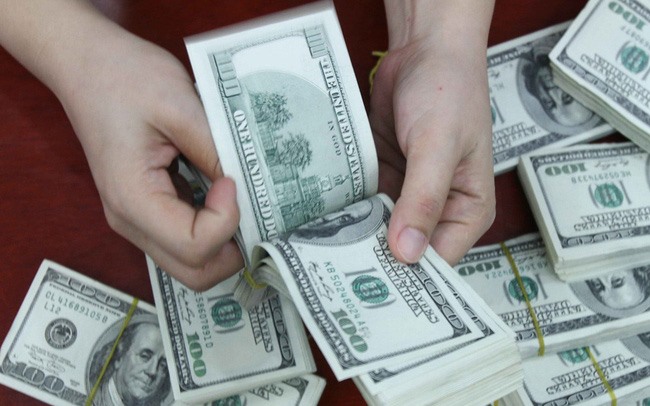 Commercial banks on Tuesday can buy the greenback from the SBV’s Operation Centre at VND23,050 per dollar. — Photo VNA Commercial banks were able to buy from the central bank’s Operation Centre at VNĐ23,050. The SBV also cut the daily reference exchange rate by VNĐ5 to VNĐ22,630 to the dollar. With the current trading band of 3 per cent, the ceiling rate for banks during the day was VNĐ23,309 and the floor rate was VNĐ21,951. Following the move, Vietcombank reduced both buying and selling rates by VNĐ5 to VNĐ23,000 and VNĐ23,070, but other lenders continued to hike their rates. BIDV increased both by VNĐ20 to VNĐ23,010 and VNĐ23,080. Techcombank’s buying rate was VNĐ22,980, up VNĐ50 from the previous day, and selling rate was VNĐ23,080. Earlier SBV Governor Lê Minh Hưng had told an online conference between the Government and localities that the central bank was willing to intervene in the foreign exchange market if supply or demand problems arose. The dollar has appreciated significantly against the đồng recently. According to Nguyễn Đức Độ, deputy head of the Economics and Finance Institute, besides the appreciation of the dollar following the US Federal Reserve’s recent interest rate hike and the accelerating US-China trade war risk, there is also a psychological factor at play following rumours that the rate would remain upward bound. But he expects the SBV to take strong measures to prevent the dollar from strengthening to much against the đồng to prevent a repeat of the dollar hoarding a few years ago. Besides, it also needs to keep the exchange rate steady to enable the Government to achieve its goal of keeping inflation below 4 per cent this year, he added. VNS |
↧
Article 2
BUSINESS IN BRIEF 5/7 Machine, metalworking expo opens in HCM City A wide range of intelligent machinery, equipment and solutions for the manufacturing value chain are on display at the International Precision Engineering, Machine Tools and Metalworking Exhibition which opened on July 3 in HCM City. The latest edition of MTA Vietnam, and the largest so far, has attracted nearly 400 exhibitors from 16 countries and territories, including 13 international group pavilions from Germany, Japan, the Republic of Korea, Singapore, Taiwan, Thailand, and the UK, said BT Tee, General Manager of UBM VES, the exhibition organiser. He said 74 percent of the exhibitors are foreign, and the number of Vietnamese exhibitors has also increased compared to previous expos. Koji Takimoto, chief representative of the Japan External Trade Organisation’s HCM City office, said 24 Japanese companies are participating this year, 11 of them for the first time. They have brought labour-saving components and equipment; equipment and materials which can protect workers like press load monitoring device, safety valves and rust removers that are safe for humans; and devices and inspection tools that can help increase local content, he said. “Vietnam is a very attractive market for Japanese firms thanks to its steady economic growth and large population,” he said. “Besides, Japanese firms are confident of their technologies. “Japanese machinery cost rather more than Chinese machinery, and this is their disadvantage. But their strategy is to create a difference in terms of technologies and accuracy rather than competing on price.” Vietnam’s low labour cost used to be a key factor in attracting foreign investors, but no longer, he said. Therefore, firms need to have machinery and equipment that offer high productivity and efficiency but require less labour, he said. They also need to improve their working environment to ensure workers’ safety, and this would provide a competitive edge to Vietnamese firms when entering fastidious markets, he said. Osamu Hata, sales department manager at NMC Co Ltd, which supplies rust removal and prevention solutions, said: “We are present in Thailand and Malaysia, but not many businesses in Vietnam know us. Therefore, by participating in the show, we want to expand our market here. “Many businesses were interested in our products, and asked for samples to see how their work.” Seiji Ushiyama of the overseas sales division at Shinko Denshi Co., Ltd, which provides solutions to industries requiring high-accuracy weighing and measurement, said his company wants to find new customers and an agent in the north. Tee said the exhibition has again attracted market leaders such as Amada, Bystronic, Blum, Carl Zeiss, Conic, DMG Mori, Dine, Doosan, Sodick, Mazak, Makino, Knuth, Kuka Robotics, Mitutoyo, and Nikon, he said. On the sidelines of the expo, seminars and conferences would be organised by the Taiwan External Trade Development Council, the Multi Engineering Solutions Laboratory, Lean Six Sigma Network, and other organisations, he said. The expo, at the Saigon Exhibition and Convention Centre in District 7, will run until July 6. 1H FDI disbursement at $8.37 bn  FDI projects were estimated to have disbursed $8.37 billion in the first half of this year, up 8.4 per cent year-on-year. Vietnam had 25,953 valid projects as at the end of the first half, with total registered capital of $331.24 billion. Total disbursed FDI capital was estimated at $180.74 billion, or 54.6 per cent of total registered capital in valid projects. Foreign investors have invested in 19 out of the 21 sectors in Vietnam to date, in which processing and manufacturing accounted for the highest proportion, with $189.13 billion, or 57.1 per cent of total investment capital, followed by real estate with $56.2 billion, or nearly 17 per cent, and the production and distribution of electricity, water and gas, with $21.92 billion, or 6.6 per cent. Valid projects come from 128 countries and territories. South Korea ranks first, with total registered capital of $61.67 billion, accounting for 18.6 per cent of the total. Japan ranked second, with $55.45 billion, or 16.7 per cent, followed by Singapore, Taiwan, the British Virgin Islands, and Hong Kong. FDI is present in all 63 cities and provinces, in which Ho Chi Minh City continued to rank top, with $45.5 billion, or 13.7 per cent of total investment capital, followed by Hanoi with $32.87 billion, or 9.9 per cent, and southern Binh Duong province with $30.74 billion, or 9.3 per cent. Exports by the foreign investment sector (including crude oil) were $80.86 billion, up 14.8 per cent year-on-year and accounting for 71 per cent of export turnover. Exports excluding crude oil totaled $79.84 billion, up 15.8 per cent year-on-year and accounting for 70.1 per cent of the total. Imports by the FDI sector were $65.21 billion, up 8.1 per cent year-on-year and capturing nearly 58.6 per cent of total import turnover. The trade surplus of the FDI sector was $15.65 billion including crude oil and $14.63 billion excluding crude oil. Vietnam had 1,366 new projects granted investment certificates in the first half with total newly-registered capital of $11.8 billion, equal to 99.7 per cent of the figure in the first half of last year, while 507 projects adjusted their capital by a total of $4.43 billion, or 86.2 per cent of the figure in the first half of last year. It saw capital contributions and share purchases made by foreign investors on 2,749 separate occasions, with capital contributions standing at nearly $4.1 billion, up 82.4 per cent year-on-year. Total new and additional capital and capital contributed and shares purchased by foreign investors was $20.33 billion, up 5.7 per cent year-on-year. Seventeen sectors received investment from foreign investors in the first half, in which the processing and manufacturing sector attracted much attention, with total capital of $7.91 billion, or 38.9 per cent of total registered capital. Real estate ranked second with total investment capital of $5.54 billion, accounting for 27.3 per cent of the total, and wholesale and retail ranked third, with $1.5 billion, or 7.4 per cent. There were 87 countries and territories with new investment projects in Vietnam in the first half. Japan ranked first with total investment of $6.47 billion, or 31.8 per cent of the total. South Korea followed with $5.06 billion, or 24.9 per cent, and Singapore ranked third, with $2.39 billion, or 11.8 per cent. Fifty-five cities and provinces received foreign investment in the first half, in which Hanoi attracted the most, with $5.87 billion, or 28.9 per cent. Ho Chi Minh City ranked second, with $3.68 billion, or 18.1 per cent, followed by southern Ba Ria Vung Tau province with $1.93 billion, or 9.5 per cent. Major projects granted investment certificates in the half included: - Smart city projects in Hai Boi, Vinh Ngoc commune, Dong Anh district, Hanoi, with total investment of $4.1 billion from Japanese investors, with the goal of building a smart city with synchronous technical infrastructure and social infrastructure city. - A polypropylene (PP) manufacturing plant and liquefied petroleum gas (LPG) warehouse project with a total capital of $1.2 billion, from South Korea’s Hyosung Corporation in Ba Ria Vung Tau. - A Laguna (Vietnam) Company Limited project, invested by Singaporean investors, in central Thua Thien Hue province, which increased its investment capital by $1.12 billion. - The Hanoi Lotte Mall project, with total registered investment of $600 million from South Korean investors, with the goal of building an international standard high-end complex including a shopping center, a hotel, office space, and tourist apartments for short-term accommodation. - The LG Innotek Hai Phong factory project from South Korean investors, with the objective of manufacturing camera modules, which increased its capital by $501 million. June PMI rises to 55.7 The Nikkei Vietnam Manufacturing Purchasing Managers’ Index (PMI) - a composite single-figure indicator of manufacturing performance - rose to 55.7 in June from 53.9 in May, one of the largest monthly improvements since the survey began in March 2011 and largely on the back of business conditions in Vietnam improving sharply. Business conditions have now strengthened in each of the past 31 months. “Vietnam’s manufacturing sector appears to be motoring midway through 2018, with growth in output and new orders among the fastest seen since the survey began in 2011,” said Mr. Andrew Harker, Associate Director at IHS Markit. “The current growth phase has been extremely positive for Vietnamese workers, with firms taking on extra staff at a record pace during June.” Manufacturing output increased at a substantial pace as the rate of growth accelerated for the third month running. Panelists reported that higher new orders and stronger client demand has been behind the rise in output. In line with the picture for production, the rate of growth in new orders was among the steepest seen across the survey’s history so far. New orders have risen continuously since December 2015. The rate of expansion in total new business outpaced that of new export orders in June, with new business from abroad increasing at a slower pace than in May. That said, the rate of growth remained marked. Higher workloads led firms in Vietnam to take on extra staff in June. Moreover, the rate of job creation quickened to a new survey record. Record hiring helped firms reduce their backlogs of work fractionally, despite strong new order growth. Manufacturers also upped their purchasing of inputs sharply in June, with the rate of expansion the third-fastest in the series so far. This helped firms increase their stocks of purchases. Stocks of finished goods decreased as inventories were used to satisfy new orders. Input costs rose sharply, with the rate of inflation quickening for the third month running. Higher oil prices and shortages of raw materials contributed to increased cost burdens. Supply shortages were also mentioned by those firms that saw delivery times lengthen. Lead times increased for the 17th successive month. Manufacturers responded to higher input costs by raising their output prices, extending the current sequence of inflation to ten months. Selling prices also increased at the fastest pace since February. Although easing to a four-month low in June, confidence among manufacturers remained strong. According to respondents, new order growth is set to support increases in output over the coming year. PG Bank skips 2017 dividend PG Bank had to set aside a provision of VND383 billion ($17 million) in 2017 so its profit was not enough to pay dividends. Will the merger with HDBank improve the business activities of PG Bank? According to PG Bank’s report on its general shareholders’ meeting, the total assets of the bank in 2017 were nearly VND29.3 trillion ($1.3 billion), up 18 per cent on-year, while total deposits were approximately VND25.3 trillion ($1.12 billion), up 20 per cent, and the outstanding balance of the entire bank was VND21.42 trillion ($0.95 billion), up 22 per cent. In 2017, PG Bank gained VND80 billion ($3.5 million) in pre-tax profit, equivalent to 54 per cent of the plan set forth. At the annual general shareholders’ meeting yesterday, PG Bank’s chairman Bui Ngoc Bao said that the reason for the low profit was unsatisfactory deposits and lending, and the increase of provisions. The total bad debts of PG Bank were VND691 billion ($30.44), increasing by VND258 billion ($11.37 million) against 2016, equalling 3.23 per cent compared to the 2.47 per cent of 2016. The report shows that the bank reached most of all business targets in 2017, but profit was little as provisions were set at VND383 billion ($17 million). PG Bank intends not to pay dividend in 2017. In 2018, PG Bank set the target of nearly VND30 trillion ($1.3 billion) in total deposits, up 19 per cent on-year, and VND24 trillion ($1.06 billion) in outstanding lending, up 12 per cent. In the end of 2018, the total assets of the bank are expected to rise by 17 per cent to VND34.2 trillion ($1.5 billion) throughout the year. Pre-tax profit is expected to hit VND183 billion ($8.6 million), a 2.3-fold increase against 2017’s performance, because the bank intends to set aside provisions of VND33 billion ($1.45 million), while it set aside VND460 billion ($20.26 million) in 2017. PG Bank and HDBank are collaborating to complete the merger in this August. PG Bank maintains its leadership until the merger is finalised in the next several months. “The final target of the leaders is to merge and develop PG Bank into a large-scale bank and bring benefits to all shareholders. The merged entity will keep all jobs, employees, as well as develop the bank,” Bao stated at the annual general shareholders’ meeting yesterday. As PG Bank has been in the red for a while now, it remains questionable whether HDBank could improve its situation. Also, should shareholders expect dividend at the next AGM? Earlier, on April 19, Vietnam National Petroleum Group (Petrolimex), the parent company of PG Bank, signed a strategic co-operation agreement with HDBank. Their plan outlined the estimated swap ratio of PG Bank and HDBank shares at 1:0.621, meaning one share of PG Bank will be converted into 0.621 shares of HDBank. Additionally, HDBank plans to pay a bonus equivalent to 20 per cent of the total shares for shareholders. If the merger plan is approved, Petrolimex will also get an additional 20 per cent of the bonus shares based on the total number of swapped shares after the merger. Moreover, the merger will also create a surplus estimated at VND5 trillion ($220.3 million), which will benefit all shareholders, including Petrolimex. HDBank holds great experience in the management and administration of mergers and acquisitions activities. By this merger, the charter capital of the two banks is estimated at VND15.345 trillion ($676 million). PG Bank and HDBank expect to become an outstanding financial and credit organisation, and its network of individual customers and small- and medium-sized enterprises will expand drastically. Morocco willing to share sustainable energy experience Morocco is willing to share its experience in sustainable energy with Vietnamese enterprises, according to Mr. Mustapha Sellam, Director of the Noor Ouarzazate Solar Power Complex under the Morocco Agency for Sustainable Energy (Masen). He also told VET that it expects greater cooperation in the sector with Vietnam in the future. Masen has taken specific actions to reach its goals. The Noor Ouarzazate Solar Complex is its most outstanding project, developed 10 km north-east of the city of Ouarzazate and the largest solar complex in the world. Phase 1 of the project involved the construction of a 160 MW concentrated solar power (CSP) plant called Noor I, while Phase 2 involved the construction of the 200 MW Noor II CSP plant and the 150 MW Noor III CSP plant. Phase 3 will see the construction of the Noor IV CSP plant. Noor I and Noor II, Mr. Sellam said, have been put into operation, while Noor III and Noor IV are expected to be completed this year. Total investment capital is some $9 billion. Along with the benefits from saving energy, the Noor complex also brings economic benefits to local citizens, he added. The project is being developed on a build, own, operate and transfer (BOOT) basis by ACWA Power Ouarzazate, a consortium of ACWA Power, Masen, Aries and TSK. The solar complex will be operated and maintained by a consortium led by NOMAC, a subsidiary of ACWA Power, and Masen. The project forms part of the Moroccan Solar Energy Programme (NOOR), which aims to develop five solar complexes with a combined capacity of approximately 2 GW by 2020 to meet the energy demands of the country, which must import 95 per cent of its power. The Noor I CSP plant is expected to offset 240,000 tons a year of CO2 emissions and generate approximately 1,000 construction jobs and 60 permanent jobs during the operations and maintenance phase. The Noor II and Noor III plants combined will help offset 533,000 tons of CO2 emissions a year. The engineering, procurement and construction (EPC) contractor for Phase 1 is the TSK Electronic consortium, whereas the EPC contractor for Phase 2 is a consortium led by Sener and Sepco III. Technical advisory services for Phase 2 were provided by Lahmeyer International and the specific environmental and social impact assessment (SESIA). Masen is responsible for managing renewable energy in Morocco. It leads development programs of integrated projects aimed at creating an additional 3,000 MW of clean electricity generation capacity by 2020 and a further 6,000 MW by 2030.The goal is to secure 52 per cent of the country’s energy mix from renewable sources by 2030. WISIUM & Jeil Feed extend cooperation The fourth renewal of a strategic cooperation program was signed on June 29 by Wisium, a premix/firm services business under France’s Neovia Group, and South Korea’s Jeil Feed, which will allow the leading South Korean feed producer to strengthen its know-how in animal nutrition and Wisium to provide it with knowledge, assistance and technical support. Wisium ranks among the leaders in the sector, providing solutions for a total feed equivalent of 30 million tons and with a direct presence in more than 50 countries and 13 others through Neovia subsidiaries. Recognized for its research and development (R&D) and zootechnical know-how, Wisium benefits from 60 years of expertise in animal nutrition and is aiming to develop solutions to better address existing and upcoming problems in the animal nutrition industry, such as demedication, optimizing production costs, improving the quality of final products, and addressing demand in the entire chain. Jeil Feed, a major South Korean animal feed producer with seven plants in South Korea and two in China, produces 1.4 million tons of feed per year and earns revenue of $560 million. Established in 1962, it belongs to the Harim Group, South Korea’s leading industrial player in poultry. Started in 2012 from a knowledge transfer agreement between the companies, the partnership has been renewed and now signed for a fourth time, focusing on designing more innovative, efficient and sustainable solutions. Wisium is a well-known specialist in the field of animal nutrition and health and is focusing on the development of innovative solutions, formulations for animal feed, the characterization of raw materials, and the implementation of R&D trials and protocols in zootechnical assistance. From this collaboration, Jeil Feed continues to develop its know-how in these fields in order to better address the agriculture sector of the future. In this context, the company will strengthen its systems efficiency by improving the performance of the company and farmers. Driven by these objectives, it has chosen Wisium to advise it on market trends and help it design more efficient and sustainable solutions. The aim of the partnership is to provide a high level of expertise in different topics and different species. Included in the agreement is the renewal of technical training for Jeil Feed’s sales team on swine and ruminant and visits by Jeil Feed’s teams to Neovia platforms around the world to better understand the different modes of production and the way to adapt to each local context. “This renewed agreement is a clear sign of the trust of Jeil Feed in the quality of the knowledge and services provided by Wisium,” said Mr. Eric Carfi, Business Development Director of Wisium in Asia. “At the same time, it demonstrates the capacity of our company to provide tailor-made value-added services and zootechnical assistance to major animal nutrition and health players, such as Jeil Feed.” KPMG & LIN partner in strategic CSR program KPMG and the LIN Center for Community Development (LIN) signed a partnership agreement last week for a three-year strategic corporate social responsibility (CSR) program called “Partnership for a Vibrant Vietnam”, within the framework of the “How Doing Good is Good for Business” conference, co-organized by LIN, the Canadian Chamber of Commerce Vietnam (CanCham), and the French Chamber of Commerce and Industry in Vietnam (CCIFV). Opening the conference, Mr. Warrick Cleine, Chairman and CEO of KPMG in Vietnam and Cambodia, delivered a keynote address on how and why strategic CSR partnerships can help grow businesses and contribute to Vietnam’s socioeconomic development. The following high-level discussion on “Strengthening Partnerships and Impact by Building Trust” welcomed diverse and expert panelists from foreign and national governments, business, individual philanthropists, and non-profits. The conference saw 270 leaders and executives in attendance, from business, non-profits, and government sectors, to inspire partnerships to further contribute to Vietnam’s socioeconomic development. This was the second time the conference has been organized. “Business Impact & Community Impact - Where to Meet?” discussions invited participants to explore creating shared value (CSV) and CSR models, looking at cross-sector partnerships that build value and sustainable impact, encouraging and enabling businesses to continue to grow sustainably, creating and continuing positive social and environmental impacts, and learning how to strengthen partnerships with key stakeholders. Within three years, KPMG and LIN aim to engage KPMG’s employees in meaningful work and develop their leadership capacity and understanding of community needs through pro bono (skill volunteering) work with LIN’s non-profit organization partners. They will also build trust, network, access the necessities of life, and reduce inequalities in the community through small grants to non-profit organizations tackling various social issues. Then, they will enhance and develop cross-sector collaboration by assisting businesses to solve complex challenges, steer change, and disrupt sectors and growth. The workshops were delivered by excellent speakers and facilitators who are senior leaders of international and local SMEs, MNCs, and NGOs/NPOs. Participants left with new understanding, ideas, inspiration, tools, platforms, and networks to optimize their CSR strategies as well as develop partnerships toward long-term transformation in Vietnam. Ms. Ton Nu Thi Ninh, President of the Ho Chi Minh City Peace & Development Foundation (HPDF) and Vice President of the Vietnam Peace Committee, delivered the closing address, outlining the opportunities and actions required for moving forward together. Ms. Tran Vu Ngan Giang, Executive Director of LIN, said that through its work LIN recognizes that businesses and community organizations share many values promoting business growth in parallel with community development. However, there are gaps and a lack of trust that challenge the partnerships between these two players. The conference was one of LIN’s key programs to facilitate collaboration between business and non-profits to create sustainable change for Vietnam. Mr. Cleine also said that “CSR propositions are about pleasing all stakeholders by creating shared values and a balanced approach.” Local demands swell animal feed production and IT application With Vietnam’s strong demand for agricultural production, especially livestock production, Vietnam has become all the more attractive to foreign animal feed makers and foreign IT firms who are expanding their business and investment in the country. Three weeks ago, the Livestock Production Department, under the Ministry of Agriculture and Rural Development (MARD), signed a document asking China’s Tongwei Vietnam to provide more documents so that the firm will be allowed to import Vietnam Lecithin, an important ingredient used for making animal feeds. Tongwei currently has two animal feed facilities, including four production lines for producing fish feed and five production lines for making shrimp feed. In its strategy in Vietnam, Tongwei is expected to expand the number of its facilities and distribution networks in the near future. “In addition to Tongwei, many other foreign firms have also registered to import new feed materials into Vietnam during the first six months of the year,” said a source from the department’s Secretariat. “The rate of foreign firms registering to import new feed materials has increased by about 20% in this year’s first half, as compared to about 10% in the corresponding period last year. Many firms are also planning to open new feed mills.” Over three weeks ago, Australia-Vietnam joint venture Mavin Group inaugurated its fifth feed mill in Vietnam, worth US$30 million, in the southern province of Dong Thap. This is also the biggest feed mill in the Mekong Delta region, annually producing 400,000 tonnes of livestock feed and aqua feed. The mill is equipped with new technology from Germany’s Bühler Group, including robotics and state-of-the-art equipment. Chairman of Mavin Group, David Whitehead, said that Mavin will continue to invest in other projects in Dong Thap, with the total investment in the province expected to be over US$70.5 million. Mavin has been granted an investment certificate to develop a nucleus pig breeding farm of 5,000 sows, annually producing 400,000 piglets. The firm will also develop pork meat production for export and engage in duck farming. According to the MARD, since early this year, Vietnam’s agricultural sector has lured special attention from many foreign firms who are expanding their business and investment in the sector, which is now seeing limited foreign direct investment (FDI) - accounting for only 1% of the country’s total FDI. Currently agricultural FDI in Vietnam is mostly found in the production of animal feeds and farm produce. Several Japanese projects are engaged in cultivating flowers and vegetables in the Central Highlands region. The total number of FDI agricultural projects is roughly 500, registered at US$3.44 billion. For example, at present the US-backed Cargill company is building a US$30 million feed mill in the southern province of Binh Duong and is also planning to build another one in the northern Bac Ninh province. Two months ago, Cargill opened its new 80,000 tonne storage facility in the southern province of Ba Ria-Vung Tau, with the aim of strengthening its grains and oilseeds distribution in Vietnam. “Vietnam is a critical aquaculture market for Cargill. Cargill continues to be an active investor in Vietnam by further expanding our workforce, manufacturing capabilities, distribution network and product line diversification,” Jorge Becerra, managing director of Cargill Feed and Nutrition Vietnam, told Nhan dan Online. In another case, South Korea’s CJ Vina Agri Company recently began operation of its sixth animal feed factory in the south-central province of Binh Dinh. The 4.1 hectare factory has a capacity of 150.000 tonnes per year and total investment capital of nearly US$30 million. In the sugar sector, Indian sugar producer KCP Vietnam Industries Ltd., has invested US$103 million in Phu Yen province, with modern technologies used in dozens of its plants there. “KCP will continue to build future projects, including a 60,000-litre-per-day distillery unit to produce fuel ethanol, an expansion of our biomass power project to 60 megawatts and an expansion of our Dong Xuan sugar unit to 6,000 tonnes of sugar cane per day. The total additional investment will be US$100 million,” said the firm’s general director K.V.S.R Subbaiah. At present, about 60 foreign firms own over 70 animal feed mills, accounting for 65% of Vietnam’s animal feed market share. According to StoxPlus, an associate company of Nikkei Inc. and QUICK Corp., 16.8 million tonnes of industrial animal feed were consumed in Vietnam in 2016, thanks to the development of the livestock sector. The consumption of industrial animal feed is expected to be at 17 million tonnes in 2020. There are three main sources of animal feed demand in Vietnam including pig, poultry and cattle (beef/buffalo/sheep/goat). All segments pose potential opportunities for animal feed providers. Each segment poses a particular formula of animal feed for animal feed providers to fulfill the market potential. Currently, Cargill is also expanding its investment and business portfolio in Vietnam via IT solutions. For example, shrimp farmers can tap into the first cloud-based solution in the aquaculture industry thanks to Cargill’s iQShrimp. The predictive software uses machine learning and sensors to give them real-time visibility into their farm operations. iQShrimp is a first-generation offering driven by iQuatic™, Cargill’s digital platform for aquaculture. “Shrimp farming has inherent weather and disease risks,” said Neil Wendover, Cargill’s digital insights product line director for aquaculture. “By working directly with shrimp farmers, our data scientists can use machine learning to deliver insights in order to inform decisions that directly impact the growth and economics of their operations.” Many other foreign firms also want to apply their IT solutions in Vietnam’s agricultural sector. They come from many foreign markets, such as Gintel from Taiwan, GAGO Ltd from China, Enzootic Ltd from Hong Kong and Israel, Fluence corporation-NIROBOX from Israel, SmartFarm Co Ltd., and Verifik8/FairAgora Asia from Thailand), Pycno Industries from Australia, and Intello Labs Pvt. Ltd. from India. “They offer a wide range of platforms, in the format of apps, software, and cell transplantation technology,” said agricultural expert Pham Hoang Ngan, and they are helping some of these firms to enter Vietnam. “In Vietnam, local agricultural firms tend to use high-tech solutions in their production which cannot be made in Vietnam. This is offering great opportunities for these foreign enterprises,” Ngan told VIR. For example, Thailand’s GoodHout BV is finding partners of coconut processors, suppliers of coconut husk, wood panels and furniture manufacturers. This firm’s solution is to turn coconut waste into a high quality bio-based material, such as flat coconut husk boards in various sizes and thickness, to be sold in the EU. Meanwhile, GAGO Ltd is seeking co-operation with agricultural firms and agricultural insurance companies. Its intelligent agriculture solution is a cloud-based platform, enabling real-time monitoring and smarter decision-making by leveraging visualised agronomic data. Also, Thailand’s Verifik8/FairAgora Asia is finding partners to apply data streams such as satellite imagery and sensors. Verifik8 is a software platform that connects producers and buyers to de-risk operations and improve compliance in the food supply chain, to improve social and environmental performance in the seafood supply chain. PVEP surpasses oil and gas exploration, financial targets The PetroVietnam Exploration Production Corporation (PVEP) has surpassed its oil and gas exploration and financial targets for the first half of this year. Specifically, the total oil and gas production hit 2.17 million tonnes of oil equivalent, up 6 percent from its target, while the total gas for sale reached 558 million cubic metres. PVEP put Bunga Pakma mine, lot PM3 CAA into operation on May 12 with a high volume. The total revenue surpassed 18.29 trillion VND, up 35 percent compared to its target. Pre-tax and post-tax profit topped 6.65 trillion VND and 3.36 trillion VND, respectively. It contributed over 4.9 trillion VND to the State budget, also up 47 percent from the plan. Since early this year, PVEP has adopted specific measures to stabilise manufacturing and ensure absolute safety for its operations. Its leaders stepped up the approval of the PVEP restructuring plan for the 2017-2020 period to submit to competent agencies. Together with PetroVietnam, it has refined its legal framework for oil and gas projects, financial mechanisms, and feasible capital for its operations. For the remaining half of the year, PVEP will increase oil reserves to 1 million tonnes of oil equivalent and develop Ca Tam field, lot 09-3/12 – which is expected to generate the first oil flow in December 2018, Su Tu Trang Pha 2, lot 15-1 as well as other projects. In order to achieve its set goals, PetroVietnam and the Ministry of Industry and Trade need to rapidly approve a suitable financial mechanism for PVEP’s oil and gas exploration. Tien Giang’s export turnover hits 1.27 billion USD Export turnover of the Mekong Delta province of Tien Giang reached 1.27 billion USD in the first half of 2018, a rise of 6.8 percent year-on-year, said Director of the provincial Department of Industry and Trade Ngo Van Tuan. Most of the province’s key staples recorded high export growth, such as copper tubes (244 million USD), footwear (230.8 million USD), garment and textiles (210.5 million USD), and rice (93.2 million USD). Currently, the province’s rice exporters have been working to increase shipments of high-quality rice in a bid to raise the export price of its products. An increasing global demand for rice has also contributed to the export price hike, around 17-20 percent higher than the previous year. In the January-June period, the province’s exports to Europe rose 10.8 percent year-on-year, followed by its exports to America (6.7 percent) and Asia (3.8 percent). Tuan said that businesses in Tien Giang have continued to promote exports in traditional markets while also seeking new ones, particularly markets that Vietnam has signed free trade agreements with. In the near future, import tariffs imposed on Vietnamese goods will be removed or cut down thanks to those agreements, offering new opportunities for Tien Giang’s products, he added. In the remaining months, the province aims to earn 1.37 billion USD from exports to meet the target of 2.65 billion USD for the whole year, obtaining a year-on-year rise of 6.3 percent. Quang Ninh develops OCOP products with focus on quality The northeastern province of Quang Ninh is developing its own brands through the One Commune One Product (OCOP) programme. The programme was initiated by the Ministry of Agriculture and Rural Development in 2008, following the model of Japan’s One Village One Product (OVOP) and Thailand’s One Town One Product (OTOP) drives. Quang Ninh was the first locality in Vietnam to implement the programme in 2013. Since then, 180 businesses, cooperatives, and working groups have been established or registered to join the programme, with a total of 210 products and groups of products and services granted the OCOP trademark, including 99 meeting 3-5 star standards. Vice Chairman of the provincial People’s Committee Dang Huy Hau said Quang Ninh wants to, through the programme, leverage on its advantages in natural resources, culture and rural labour for the creation of high-quality products to increase incomes and generate jobs for local residents as well as achieve sustainable development. The OCOP programme is designated to help develop complete production and value chains from production, harvesting, processing and consumption for local specialties and products, he said. Particularly, the OCOP brand is registered as intellectual property and printed on all products, according to Hau. Chairman of Quang Ninh Alliance of Cooperatives Nguyen Van Nghi said the province has encouraged the participation of cooperatives in the OCOP programme, as well as the transformation of cooperatives in line with the 2012 Law on Cooperatives to receive new preferential treatment and improve their operational efficiency. In addition, 29 cooperatives have been established through the OCOP. Nghi said the law has created a legal framework for cooperatives to develop sustainably and diversify production models, thus contributing to poverty reduction. Meanwhile, Nguyen Ngoc Bao, Chairman of Vietnam Cooperatives Alliance, recognized the effective implementation of the OCOP in Quang Ninh with the establishment of new cooperatives. Particularly, there is connectivity among businesses, he said. However, some cooperatives are operating at a small scale, hence their products are less competitive, he added. Vu Duc Phu, Director of Phu Hai Production and Industrial Services Cooperative, advised cooperatives to work together in building a value chain, which is useful for creating high-quality products and securing their foothold in the market. Quang Ninh plans to develop 130 existing OCOP products and 120 new ones in the near future, he said. OCOP is an economic development programme in rural areas focusing on increasing internal power and values, contributing to the implementation of the National Target Programme on New Rural Development for 2016-2020. Groups of goods and services defined in the programme include food (fresh and processed farm produce); beverages (alcoholic and non-alcoholic drinking); medicinal herbs (products made from herbal plants); fabric and textiles (products made from cotton and yarn); souvenirs - furniture - decorations (products made from wood, fiber, rattan, metal and ceramics); and rural tourism services and sales (services for sightseeing, tourism, study, research). The overall objective of the programme is to develop forms of production organisation and business (with the priority will be given to developing cooperatives and small and medium-sized enterprises (SMEs), towards producing traditional products and developing services with high competitiveness in the domestic and international markets, thus promoting rural economy and the national agriculture industrialisation and moderlisation. According to the Ministry of Agriculture and Rural Development, nearly 6,010 enterprises, cooperatives, working groups and business households are producing 4,823 products in six commodity groups. Specifically, there are 2,584 products in food, 1,041 in beverages, 231 in herbals, 186 in fabric and garment, 580 in souvenirs – interior décor, 201 in rural tourism services. However, only 1,086 products register for quality standards and 695 products register for intellectual property protection. As of late April, 60 out of 63 cities and provinces nationwide built the frame OCOP programme at the provincial level, 30 of which already completed the programme design and 28 others are collecting feedback before approval. Nhan Co alumina plant achieves 3.2 trillion VND in revenue The Vietnam National Coal and Mineral Industries Group (Vinacomin)’s Nhan Co Alumina plant in the Central Highland province of Dak Nong gained more than 3.2 trillion VND (141 million USD) in revenue in the first six months of the year. According to a report from the Dak Nong Aluminum Company - the plant’s operator, the Nhan Co factory produced more than 324,000 tonnes of alumina in the first half of 2018, or 56 percent of the set target for the whole year. After one year of operation, the plant’s total alumina output was 600,348 tonnes. Around 303,000 tonnes of alumina produced by the Nhan Co plant were consumed during the January-June period, equivalent to 55.6 percent of the annual plan. Vinacomin Chairman Le Minh Chuan said that advanced technical solutions, rational production chains, and strict management of technical standards and costs are the key to reducing production costs while improving production efficiency. With more than 98.6 percent of alumina content, the plant’s products have been favoured in many foreign markets like Japan, the Republic of Korea, Hong Kong (China), Singapore, the United Arab Emirates (UAE) and Sweden. This year, Vinacomin inked long-term agreements with its partners in India and the UAE to consume the products from the Nhan Co Alumina plant. The Nhan Co plant plans to produce 580,000 tonnes of alumina in 2018, gain 4.46 trillion VND (196.24 million USD) in revenue, and contribute 424 billion VND (18.65 million USD) to the state budget. The Dak Nong Aluminum Company is striving to produce 630,000 tonnes of alumina in 2018, up 8.6 percent from the amount assigned by Vinacomin. Director of the company Hoang Khai Quoc Minh said that the company will work to master the state-of-the-art production line, and invest in the analysis of technical system to ensure stable operation of the production line. Also, it will channel efforts to effectively use bauxite resources, and protect the environment, ensuring sustainable economic growth. Taiwanese firms boost agricultural partnership with Vietnam Businesses from Taiwan (China) have signed several agreements on agricultural cooperation with the Vietnam Organic Agri-Economy Institute after recent fact-finding trips to Tay Ninh, Dong Thap and Lam Dong provinces. Nguyen Ngoc Bao, Chairman of the Vietnam Cooperative Alliance (VCA), said under the deals, the two sides will transfer technologies of crossbreeding and producing plant and animal varieties that match the soil, climate and manpower conditions in Vietnam. They will work together to help local agricultural cooperatives apply high technologies in a bid to develop value chains in agricultural production. The Taiwanese firms will also assist in manpower training, exchange of experts and support for agriculture-based start-ups. Notably, a programme on developing the start-up ecosystem in Vietnam’s rural areas will be developed. This programme aims to assist young people to start their careers in agriculture and in their hometowns in rural areas, Bao noted. Van Thinh Phat Group and some partners have mobilised 200 billion VND (8.7 million USD) to fund the first phase of the programme, whose coordinating board and some other businesses, including Sunny World Investment and Development Corporation and Saigon Commercial Bank, will continue calling for investment in this programme. Beneficiaries are young people with disadvantages who have feasible capital use plans and production-business ideas but lack funding. The programme will also finance part of the capital for extremely poor families. Bao said Vietnam is facing a shortage of young workforce for cooperatives, so it is necessary to learn from Taiwan’s agricultural start-up experience in the programme. This is a solution helping to strongly develop Vietnam’s agriculture and reach the target of having over 35,000 cooperatives, including 15,000 agricultural ones, by 2020, he added. 650 million shares auctioned on HNX in H1 Twenty-one auctions were held at the Hanoi Stock Exchange (HNX) in the first half of 2018, including 14 for capital withdrawal, six for initial public offering (IPO) and one for purchase rights. More than 1 billion shares were auctioned, of which some 650 million shares were traded, equivalent to 63 percent. About 10.4 trillion VND (452.9 million USD) worth of shares were collected after the 21 auctions. Investors were interested in auctions for divestments and IPOs on HNX, with offered volume several times higher than sale volume. In June there was an IPO auction of the Hai Duong motor vehicle registration centre, and another auction for capital withdrawal of Bach Dang Construction Corporation JSC of the Ministry of Construction. Only 22 million shares worth 556 billion VND (24.2 million USD) were auctioned, while up to 90 million shares were ordered in the two auctions, up four times compared to those for sale. According to the HNX, it will hold two auctions in July, with more than 11 million shares of the Duyen Hai Quang Ninh One-member Company Limited and the Nghe An Water Supply JSC on offer. 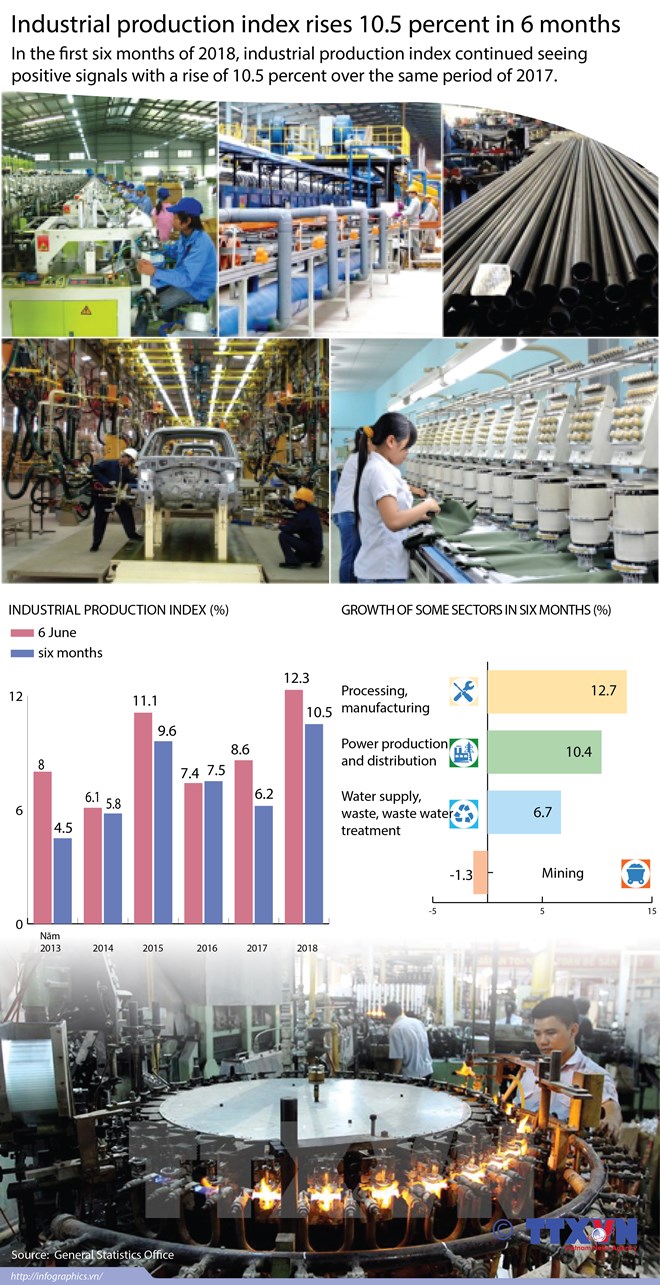 Vietjet Air starts int’l flight services at Cam Ranh airport’s T2 terminal Vietjet Air announced on July 3 that it has officially begun services related to international flights to and from the Cam Ranh International Airport, in the central province of Khanh Hoa, at the airport’s international passenger terminal (T2). Accordingly, the carrier will place bulletin boards in easy-to-see locations, and guide passengers between the old terminal and the new one. Vietjet Air will operate counters E and F on the second floor of T2. A separate counter (F09) will be arranged for SkyBoss class passengers on the same floor. The counters will be equipped with modern technology and visually striking bulletin boards. Everyday, Vietjet Air offers more than 30 flights with five domestic routes from Cam Ranh to Ho Chi Minh City, Hanoi, Da Nang, Hai Phong, and Thanh Hoa. It also provides flights on two international routes from Nha Trang to Seoul in the Republic of Korea and Siem Reap in Cambodia, as well as other international charter flights. Vietjet Air is currently the firm with the highest frequency of operations at the Cam Ranh International Airport. Passengers should arrive for check-in procedures three hours before the departure time of their international flights in the new terminal. Currently, Vietjet Air operates 60 aircraft of A320 and A321 types, undertaking more than 385 flights per day on 93 routes within Vietnam, as well as those to Hong Kong, Singapore, the RoK, Taiwan, Thailand, Indonesia, Myanmar, Malaysia, and Cambodia. Vietnam wishes to receive continued support from VBF Consortium Vietnam wants to continue receiving valuable assistance and cooperation from the Vietnam Business Forum (VBF) Consortium, domestic and foreign organisations and businesses, said a senior Vietnamese official. Nguyen Van Binh, Politburo member, Secretary of the Party Central Committee and head of the Committee’s Economic Commission, made the statement at a reception in Hanoi on July 4 for a working delegation from the VBF Consortium led by Tomaso Andreatta, Co-Chairman of the VBF Consortium’s Management Board and Vice Chairman of the European Chamber of Commerce in Vietnam. Binh stressed that foreign organisations and businesses have made great contributions to Vietnam’s economic development, especially in trade and investment. He revealed that under Vietnam’s objective set for 2020, with a vision toward 2030-2035, the private economic sector will become an important driving force for national economic development. In the energy field, Vietnam encourages and creates all possible conditions for the private sector to develop strongly, he noted. For his part, Tomaso Andreatta spoke highly of Vietnam’s socio-economic development achievements, especially in energy and power market development. He mentioned the development of power market and renewable energy in Vietnam as well as the potential role of the private sector in this field. VNN |
↧
↧
Article 1
VN should be resilient to shifting megatrends: WB HÀ NỘI —Việt Nam’s economy can be re-defined by focusing on the effective exploitation of four megatrends affecting the country’s sustainable and competitive development.
Ousmane Dione, country director of World Bank in Việt Nam, addresses the conference held on Thursday in Hà Nội. — VNS Photo Linh Anh The statement was made by Ousmane Dione, country director of World Bank in Việt Nam, during a conference held on Thursday in Hà Nội, themed ‘Enhancing Competitiveness, Realising Sustainable Development Goals’. The event was co-organised by the Việt Nam Chamber of Commerce and Industry (VCCI), Việt Nam Business Council for Sustainable Development (VBCSD) and the World Bank. “Megatrends are regional or global in nature, and they are sustained and transformational forces that can re-define our world by changing the rules of the game,” Dione said. Four specific megatrends Dione mentioned comprised of shifting trade patterns, rising knowledge economy, climate change, and an aging population. “Megatrends present risks and opportunities, and the trick is to figure out how to leverage them to work in Việt Nam’s advantage.” Ousmane Dione also introduced key findings from the World Bank’s report ‘Việt Nam’s future jobs’, which emphasised the effective exploitation of the mentioned megatrends and how these trends would affect Việt Nam’s jobs structure and economic reform process. “Jobs have been a fundamental part of Việt Nam’s rapid transformation to a modern, globally integrated, middle-income country,” Dione said. “The world is on the cusp of new opportunities that could further shift Việt Nam’s jobs picture. The rise of the Asian consumer class, especially in China, a shift toward knowledge economies, new trade partners and patterns, automation in the workplace, and aging all threaten Việt Nam’s current jobs structure, but they also offer opportunities.” To help Việt Nam’s resilience to megatrends and effective implementation of sustainable development goals as well as improving competitiveness, the four types of capital – institutional, human, physical, and natural – must be developed and deployed efficiently, equitably, and effectively, he said. At the event, VCCI Chairman and co-chair of the Vietnam Business Council for Sustainable Development (VBCSD), Vũ Tiến Lộc, said that Việt Nam would accelerate the economic reform process and become a high-middle-income country within the next two decades, with impressive achievements in social justice and equality and effective state management. He emphasised the consensus and concerted efforts of all social classes, the effective support and cooperation of related parties and international organisations. The conference also focused on issues and solutions to promote public-private partnerships, recommendations from the business community and international organisations to promote the implementation of the Government’s action programmes to improve productivity and competitiveness, towards sustainable development in the digital era. The event was attended by more than 650 delegates, representing governmental agencies, ministries, localities, research institutions, international organisations and business associations. Within the framework of the conference, the Ministry of Planning and Investment and the VCCI also announced the Partnering for Green Growth and the Global Goals 2030 (P4G), a new global partnership initiative aiming to facilitate and leverage strategic global public-private partnerships to contribute to the implementation of the 2030 Global Sustainable Development Goal through the implementation of Green Growth. VNS |
↧
Article 0
Vietnam’s fruits enter choosy markets Vietnam fruits have penetrated 60 markets as food safety standards have improved in recent years.
Vietnam's fruits have penetrated 60 markets According to the Ministry of Agriculture and Rural Development (MARD), after many years of negotiation, Vietnam has overcome technical barriers to enter choosy markets including Australia, the US, New Zealand, Japan and South Korea. By April 2018, Vietnam had exported over $1.3 billion worth of fruits, an increase of 30 percent over the same period last year. In 2017, the export turnover from fruits was $3.5 billion, nearly twice as much as 2016 ($1.7 billion). The figure is expected to reach $4.3-4.5 billion this year. Vietnam is able to meet strict requirements set by import countries on origin tracing. The efficiency of trade promotion, branding and the connection between farmers and exporters is also very good.
According to Hoang Trung, head of the Plant Protection Agency, it took Vietnam seven years to obtain the right for Vietnam’s rambutan to enter New Zealand market. And only after 10 years of negotiations did the US open its market to Vietnam’s star apple. To enter choosy markets, Vietnam has to satisfy requirements on food safety, especially in plant protection chemical residue. To date, the Plant Protection Agency has granted 6,000 growing area codes to dragon fruit, mango, longan, rambutan and litchi. MARD is joining forces with enterprises to continue building seven processing plants with regional stature. Trump said there are three major requirements for the US market. First, the growing areas must meet requirements or the US to authorize MARD to grant growing area codes. Second, the packaging factories must be granted codes by the US. And third, export products must be radiated at factories that meet standards. Vo Quan Huy, director of Huy Long An, which grows and exports bananas to Japan, confirmed that to enter the Japanese market, the company has to meet many strict requirements, from soil conditions to seedling selection, from cropping to harvesting, from product size to packaging in containers. Farmers need to take care of every banana, so that they have equal size and quality. Each bunch must not have too many bananas to ensure quality and appearance. Huy said that, before signing contracts, Japan sent staff to growing areas to take soil, water and air samples for testing of 230 criteria. Vietnam exported $3.51 billion worth of vegetable and fruit exports in 2017, of which fresh fruits made up 75 percent, or $2.63 billion. VNN |
↧
Article 1
Credit institutions hope for better results in 2018Hanoi -Most credit institutions reported good results in the second quarter of this year, and expected their business performance throughout 2018 to be better than the previous year. Illustrative photo (Photo: VNA) During the period, demand for loans, deposits and payments and cards increased 51.1 percent, 36.9 percent and 35.4 percent, respectively, according to a survey conducted by the State Bank of Vietnam (SBV) in June. The credit institutions hoped that the demand would continue to surge in the next quarter and the entire year. Up to 82.5 percent of respondents expected that risks for customers will remain stable in the third quarter while 6.5 percent thought risks would reduce in the period. The credit institutions estimated that bad debts and credit outstanding balance will stay low till the end of 2018, lower than that the rates posted in the same period last year. They expressed optimism on the liquidity of the banking system in both Vietnamese dong and foreign currencies. The survey revealed that 67.4 percent of credit institutions said their business in April-June was better than the previous quarter, 76.1 percent of them had high hopes for July-September while 82.6 percent hoped for business improvement through 2018. Up to 88 percent of the interviewees predicted their pre-tax profits in the year to rise against 2017, with total profits expected to grow 19.05 percent on average, higher than the 18.2 percent forecast in the first-quarter survey but lower than the 19.33 percent rate in the survey conducted in the fourth quarter of 2017. Meanwhile, 46 percent of the credit institutions said they had employed more workers in the second quarter and 30 percent of them reported a lack of necessary labour force, and 62 percent of them aim to recruit more labourers in the third quarter of 2018. It is estimated that 70 percent of the credit institutions will increase the number of workers in the end of 2018, 23 percent will retain their present labour force and only 7 percent will cut personnel. The respondents anticipated that capital mobilisation of the entire system will expand 5.45 percent in the third quarter and 16.51 percent in the year, both higher than the figures recorded in 2017. Credit outstanding balance is projected to surge 5.99 percent in the third quarter and 16.78 percent in 2018, also higher than the numbers in 2017. VNA |
↧
More Pages to Explore .....
